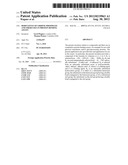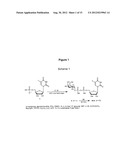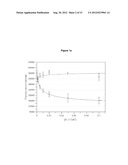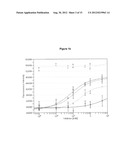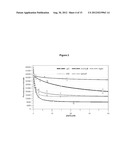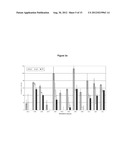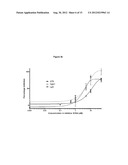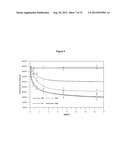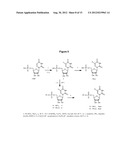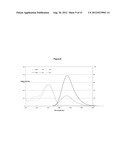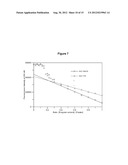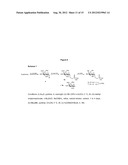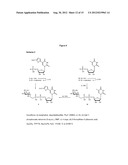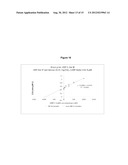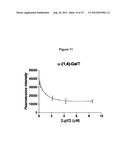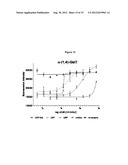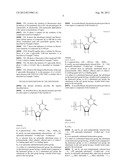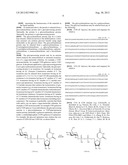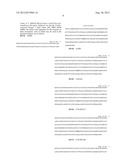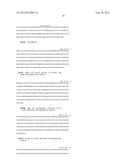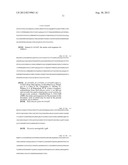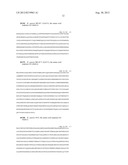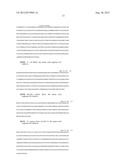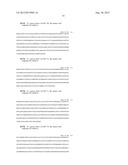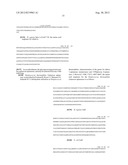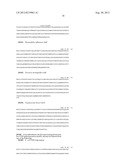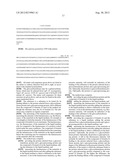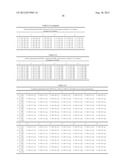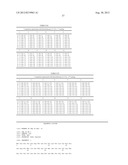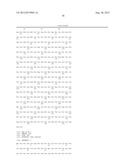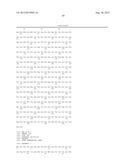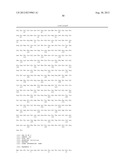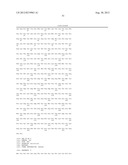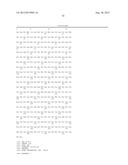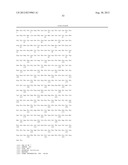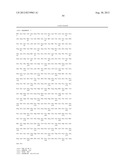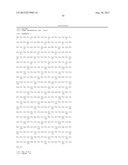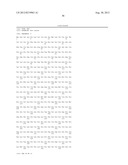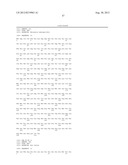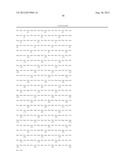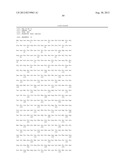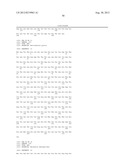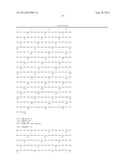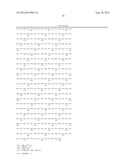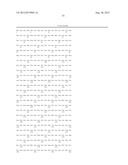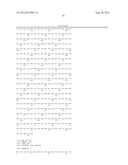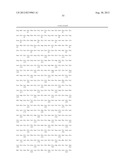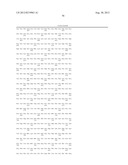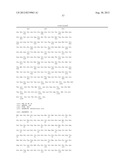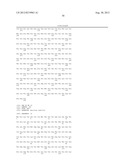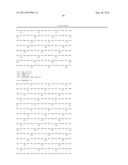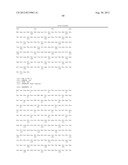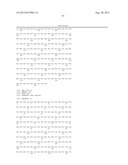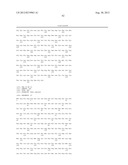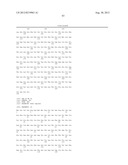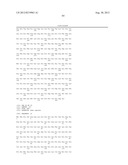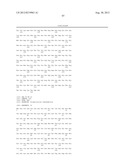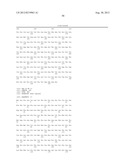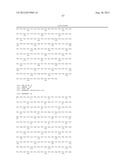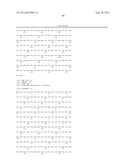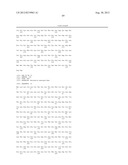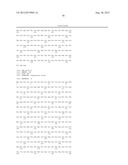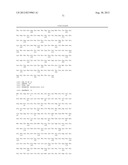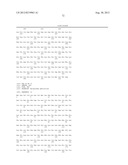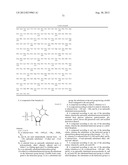Patent application title: DERIVATIVES OF URIDINE PHOSPHATE AND THEIR USES IN PROTEIN BINDING ASSAYS
Inventors:
Gerd Wagner (London, GB)
Thomas Pesnot (Coulsdon, GB)
IPC8 Class: AG01N33573FI
USPC Class:
435 74
Class name: Measuring or testing process involving enzymes or micro-organisms; composition or test strip therefore; processes of forming such composition or test strip involving antigen-antibody binding, specific binding protein assay or specific ligand-receptor binding assay to identify an enzyme or isoenzyme
Publication date: 2012-08-30
Patent application number: 20120219963
Abstract:
The present invention relates to compounds and their use in competitive
protein binding assays, for example for use with glycosyl transferase
and/or glycoprocessing proteins. The present application also provides
kits and apparatuses for use in the assays. In particular, the present
invention provides a compound of the formula (I): wherein n is 1, 2 or 3;
R1 is selected from --OH, --OPO3H, --OR4, --NHR4,
R6; R2 and R3 are each independently selected from --H,
--OH, optionally substituted --O-alkyl and --O-alkanoyl; R4 is
selected from an optionally substituted mono or polysaccharide, -alkyl,
-alkenyl, -alkynyl, and L-Z, where L is a linking agent and Z is a
binding agent; R6 is an optionally substituted hydrocarbon group; A
is either (i) a substituted heteroaryl group, the substituent on the
heteroaryl group having a double bond conjugated to the heteroaryl group,
or (ii) a substituted aryl group, the substituent on the aryl group
having a double bond conjugated to the aryl group.Claims:
1. A compound of the formula (I): ##STR00009## wherein n is 1, 2 or 3;
R1 is selected from --OH, --OPO3H, --OR4, --NHR4,
R6; R2 and R3 are each independently selected from --H,
--OH, optionally substituted --O-alkyl and --O-alkanoyl; R4 is
selected from an optionally substituted mono or polysaccharide, -alkyl,
-alkenyl, -alkynyl, and L-Z, where L is a linking agent and Z is a
binding agent; R6 is an optionally substituted hydrocarbon group; A
is either (i) a substituted heteroaryl group, the substituent on the
heteroaryl group having a double bond conjugated to the heteroaryl group,
or (ii) a substituted aryl group, the substituent on the aryl group
having a double bond conjugated to the aryl group.
2. A compound according to claim 1, wherein n is 2.
3. A compound according to claim 1 or claim 2, wherein R1 is selected from --OH and --OR4 and R4 is an optionally substituted monosaccharide.
4. A compound according to any one of the preceding claims, wherein the optionally substituted monosaccharide is selected from glucose, galactose, galactosamine, glucosamine, xylose, fucose and glucuronic acid, and acylated derivatives thereof.
5. A compound according to any one of the preceding claims, wherein the substituted heteroaryl group is a substituted thiophene.
6. A compound according to any one of the preceding claims, wherein the substituent on the heteroaryl group is selected from alkenyl and a group of the formula --C(═X)--R5, wherein X is selected from O, S, NH and N-alkyl, and R5 is selected from --H and optionally substituted -alkyl, -alkenyl and -alkynyl.
7. A compound according to any one of the preceding claims, wherein R2 and R3 are each OH.
8. A compound according to any one of the preceding claims, wherein n is 2, R1 is selected from --OH and --OR4 and R4 is an optionally substituted monosaccharide, R2 and R3 are each OH, the substituted heteroaryl group is a substituted thiophene, the substituent on the heteroaryl group is a group of the formula --C(═X)--R5, wherein X is selected from O, S, NH and N-alkyl, and R5 is selected from --H and optionally substituted -alkyl, -alkenyl and -alkynyl.
9. A compound according to any one of claims 1, 2, 5, 6 and 7 wherein n is 1 or 2, R1 is optionally substituted C1 to 3 alkyl.
10. A compound according to claim 9, wherein R1 is C1 to 3 alkyl substituted with a mono or polysaccharide, and wherein the C1 to 3 alkyl is linked to the mono or polysaccharide by a C-glycosidic bond.
11. A method for determining the binding affinity of a substance to a protein selected from a glycosyltransferase protein and a glycoprocessing protein, the method comprising: contacting in a liquid medium the materials: a protein selected from a glycosyltransferase protein and a glycoprocessing protein; a compound of formula (I) according to any one of claims 1 to 8; and a substance; and, after the contacting, measuring the luminescence of the materials in the liquid medium.
12. A method according to claim 11, wherein the method comprises: providing the protein selected from a glycosyltransferase protein and a glycoprocessing protein and the compound of formula (I) according to any one of claims 1 to 10 in the liquid medium; adding the substance to the liquid medium; and measuring the luminescence of the compound of formula (I) before and after adding the substance to the liquid medium to detect a difference in the luminescence.
13. A method according to claim 11, wherein the method comprises: providing the compound of formula (I) according to any one of claims 1 to 10 and the substance in a liquid medium; adding the protein selected from a glycosyltransferase protein and a glycoprocessing protein into the liquid medium; and measuring the luminescence of the compound of formula (I) before and after adding the substance to the liquid medium to detect a difference in the luminescence.
14. A method according to any one of claims 11 to 13, wherein the glycosyltransferase protein is selected from a galactosyltransferase, a N-acetylgalactosyltransferase, a glucosyltransferase, a N-acetylglucosyltransferase, a xylosyltransferase, a glucuronyltransferase, a mannosyltransferase, and a fucosyltransferase.
15. A method according to any one of claims 11 to 13, wherein the glycoprocessing protein is an isomerase that can bind with and/or act upon UDP-galactose and/or UDP-glucose.
16. A method according to according to any one of claims 11 to 13 and 15, wherein glycoprocessing protein has an EC number of 5.1 or 5.4.
17. A method according to any one of claims 11 to 13, wherein the glycoprocessing protein is a UDP-Gal 4'-epimerase.
18. A method according to any one of claims 11 to 17, wherein the liquid medium comprises a protic solvent.
19. A method according to any one of claims 11 to 18, wherein the liquid medium contains a divalent metal ion.
20. A method according to claim 19, wherein the divalent metal ion is Mn2+.
21. Use of a compound of formula (I) according to any one of claims 1 to 10 in determining the binding affinity of a substance to a protein selected from a glycosyltransferase protein and a glycoprocessing protein.
22. A kit for use in the method of any one of claims 11 to 20, the kit comprising one or more containers comprising: a compound of formula (I) according to any one of claims 1 to 10, and instructions on how to carry out a method for determining the binding affinity of a substance to a protein selected from a glycosyltransferase protein and a glycoprocessing protein using the compound of formula (I).
23. The kit according to claim 22, which further comprises, optionally in one or more separate containers from the compound of formula (I), (i) a protein selected from a glycosyltransferase protein and a glycoprocessing protein and/or (ii) a liquid medium suitable for allowing the binding of the compound of formula (I) to the protein selected from a glycosyltransferase protein and a glycoprocessing protein within the liquid medium.
24. An apparatus for use in the method according to any one of claims 11 to 23, the apparatus comprising a container containing a compound of formula (I) according to any one of claims 1 to 10, and optionally one or more of a liquid medium, a protein selected from a glycosyltransferase protein and a glycoprocessing protein, and a substance, and wherein the container is adapted such that fluorescence of the compound of formula (I) can be measured.
25. The apparatus according to claim 24, the apparatus further comprising a means for measuring the fluorescence of the compound of formula (I) in the liquid medium.
26. The apparatus according to claim 24 or 25, wherein the container is a multi-well plate for use in a high throughput screening process, at least one the wells containing a compound of formula (I) according to any one of claims 1 to 10, and optionally one or more of a liquid medium, a protein selected from a glycosyltransferase protein and a glycoprocessing protein, and a substance to be tested.
27. A composition comprising a compound of formula (I) according to any one of claims 1 to 10 and a protein selected from a glycosyltransferase protein and a glycoprocessing protein.
28. A composition according to claim 27, wherein the glycosyltransferase protein is selected from a galactosyltransferase, a N-acetylgalactosyltransferase, a glucosyltransferase, a N-acetylglucosyltransferase, a xylosyltransferase, a glucuronyltransferase, a mannosyltransferase, and a fucosyltransferase
29. A composition according to claim 27, wherein the glycoprocessing protein is an isomerase that can bind with and/or act upon UDP-galactose and/or UDP-glucose.
30. A composition according to claim 27 or 29, wherein glycoprocessing protein has an EC number of 5.1 or 5.4.
31. A composition according to any one of claims 27, 29 and 30, wherein the glycoprocessing protein is a UDP-Gal 4'-epimerase.
32. A composition according to any one of claims 27 to 31, wherein the composition further comprises a liquid medium.
Description:
FIELD OF THE INVENTION
[0001] The present invention relates to compounds and their use in competitive protein binding assays, for example for use with glycosyl transferase and/or glycoprocessing proteins. The present application also provides kits and apparatuses for use in the assays.
BACKGROUND TO THE INVENTION
[0002] In all domains of life, the biosynthesis of complex glycoconjugates requires the concerted action of a multitude of glycosyltransferases (GTs), enzymes that catalyse the transfer of a mono- or oligosaccharide from a glycosyl donor, e.g. a sugar-nucleotide, to a suitable acceptor, e.g. a glycan, peptide or lipid. These functions are further described in Weadge, J. T. & Palcic, M. M. Chemistry of glycosyltransferases. Wiley Encyclopedia of Chemical Biology. DOI 10.1002/9780470048672.wecb213, 1-13 (2008); Lairson, L. L., Henrissat, B., Davies, G. J. & Withers, S. G. Glycosyltransferases: structures, functions and mechanisms. Annu. Rev. Biochem. 77, 521-555 (2008); Schuman, B., Alfaro, J. A. & Evans, S. V. Glycosyltransferase structure and function. Top. Curr. Chem. 272, 217-257 (2008); Breton, C., Snajdrova, L., Jeanneau, C., Koca, J. & Imberty, A. Structures and mechanisms of glycosyltransferases. Glycobiology 16, 29R-37R (2006).
[0003] GTs play a key role in many fundamental biological processes underpinning human health and disease, such as cell signalling, cellular adhesion, carcinogenesis, and cell wall biosynthesis in humanpathogens. This is further described in Marth, J. D. & Grewal, P. K. Mammalian glycosylation in immunity. Nat. Rev. Immunol. 8, 874-887 (2008); Rexach, J. E., Clark, P. M. & Hsieh-Wilson, L. C. Chemical approaches to understanding O-GlcNAc glycosylation in the brain. Nat. Chem. Biol. 4, 97-106 (2008); Dube, D. H. & Bertozzi, C. R. Glycans in cancer and inflammation: potential for therapeutics and diagnostics. Nat. Rev. Drug. Discov. 4, 477-488 (2005); Berg, S., Kaur, D., Jackson, M. & Brennan, P. J. The glycosyltransferases of Mycobacterium tuberculosis--roles in the synthesis of arabinogalactan, lipoarabinomannan, and other glycoconjugates. Glycobiology 17, 35R-56R (2007).
[0004] The development of small molecular glycosyltransferase inhibitors is therefore of considerable scientific interest in chemical glycobiology and drug discovery. Thus, GT inhibitors are sought after as molecular tools for the interrogation of glycosylation pathways, for mechanistic studies on carbohydrate-active enzymes, and as lead compounds in several important therapeutic areas, including infectious diseases, inflammation and cancer. This is further described in Qian, X. & Palcic, M. M. Glycosyltransferase Inhibitors. In: B. Ernst, G. Hart, P. Sina (Eds.) Carbohydrates in Chemistry & Biology, p 293-328 (Wiley-VCH, Weinheim, 2000).
[0005] A number of methods have been developed to study glycosyltransferases (GTs), as isolated enzymes and in living organisms. These methods allow the monitoring of GT activity during and after enzyme purification and can be used for studies of enzyme mechanisms, inhibition measurements, high throughput screening (HTS) and applications in biocatalysis. Enzymatic bioassays can be designed as either a functional or a binding assay. Functional assays provide information, qualitatively and quantitatively, about the progress of an enzymatically catalysed reaction and about the influence of a chemical of interest on said enzymatic reaction. Thus, the biological activity of a molecule towards an enzyme can be determined, e.g. whether said molecule behaves as an inhibitor or a substrate. Functional bioassays for GTs are most commonly based on monitoring either the depletion of the substrates (i.e. sugar-nucleotide and acceptor) or the formation of the products (i.e. nucleoside diphosphate or glycosylated acceptor).
[0006] Ideally, GT functional assays are carried out in real time with saturated substrate concentrations. However, this is often difficult to achieve practically because of the elevated cost and limited availability of many GT substrates. Binding bioassays, on the other hand, do not necessarily require both enzymatic substrates since they are exclusively designed to quantify the binding affinity of a molecule for an enzyme, and do not rely on an enzymatic reaction. Since they can be developed as HTS assays, binding affinity bioassays are especially useful in medicinal chemistry projects to determine the binding activity of small molecular inhibitors.
[0007] Due to the complexities of assaying GTs, an extensive range of methods have been employed for the development of both functional and binding assays (Palcic, M. M.; Sujino, K. Trends Glycosci. Glycotechnol. 2001, 13, 361.) Thus, methods based on different principles of detection such as radiochemistry, chromatography, immunology and spectrophotometry have been designed. Functional assays include chromatographic, spectrophotometric and radiochemical assays. The use of chromatographic methods in functional assays is further described in Taniguchi, N.; Nishikawa, A.; Fujii, S.; Gu, J. Methods Enzymol. 1989, 179, 397. Examples of multi-enzyme assay methods using mammalian glycosyltransferases can be found in Gosselin, S.; Alhussaini, M.; Streiff, M. B.; Takabayashi, K.; Palcic, M. M. Anal. Biochem. 1994, 220, 92. Such methods were later adapted for use in microplates allowing high-throughput inhibitor screening. However, these assays often require large quantities of enzymes, limiting their application to highly abundant or cloned enzyme sources.
[0008] Radiochemical assays have also been used as functional assays for GTs since they are highly sensitive and enable the detection of low levels of enzymes (Palcic, M. M.; Pierce, M.; Hindsgaul, O. Methods Enzymol. 1994, 247, 215). Typically, the non-continuous assay involves the incubation of the enzyme with radiolabelled sugar-nucleotide and acceptor. After quenching the reaction, several methods exist for the separation of the unreacted radiolabelled donor from the radiolabelled glycosylated product. These include electrophoresis, ion-exchange chromatography, TLC and size exclusion chromatography for glycoproteins. More recently, von Ahsen and coworkers engineered radiochemical assays with suitable conditions for the high throughput screening of drug-like glycosidic acceptor inhibitors. (Von Ahsen, O.; Voigtmann, U.; Klotz, M.; Nifantiev, N.; Schottelius, A.; Ernst, A.; Muller-Tiemann, B; Parczyk, K. Anal. Biochem. 2008, 372, 96.) Their screening of nearly 800,000 compounds enabled the identification of 233 hits, mostly specific to Fucosyltransferase VII, a promising drug target for the treatment of inflammatory skin diseases. The main limitations of this radiochemical assay include hazards associated with the use and disposal of radioactive material and its lack of versatility, since it was exclusively designed for FucTVII.
[0009] Other methods available for functional GT assays include Enzyme-Linked Immunosorbant Assays (ELISA), an example of which is described in Verdon, B.; Berger, E. G.; Salchli, S.; Goldhirsch, A.; Gerber, A. Clin. Chem. 1983, 29, 1928. With highly specific antibodies or lectins, immunological assay methods have the advantage of identifying reaction products and being suitable for high throughput screening. Palcic and co-workers also developed a procedure analogous to the ELISA called the ELFIA (Enzyme-Linked Immuno-Fluorescent Assay). In this procedure, originally developed for assaying blood group A and B transferases, BSA-conjugates are coated onto nitrocellulose membranes rather than microplates. Advantageously, this provides a much faster assay than the ELISA technology (Keshvara, L. M.; Gosselin, S.; Palcic, M. M. Glycobiology 1993, 3, 416.). Immunological assays based on fluorescence such as "Transcreener Assays" commercialised by BellBrook Laboratories are also available for high throughput GT inhibitor evaluation. Immunological assays are, however, unsuitable for detailed kinetic or mechanistic studies since the acceptor substrate can only be immobilised in low concentrations. Moreover, the availability of antibody or acceptor conjugate can also be a limitation especially for HTS evaluation of large libraries of inhibitors. Many other methods were designed for quantitative GT assays in both isolated enzymes and cells. One of the most recent assays relies on pH measurements and was first reported by Deng and Chen (Deng, C.; Chem, R. R. Anal. Biochem. 2004, 330, 219.) The pH-based assay relies on the detecting the absorbance change of a pH indicator, phenol red, in response to the proton release that accompanies the galactose transfer. Advantageously, the pH-based assay does not require any expensive specialised equipment or labelled substrate, and therefore was successfully applied by Palcic and Persson to automated HTS with mutated GTB enzymes.
[0010] Carbohydrate microarrays, often called "lab-on-a-chip", were also designed for GT activity and the analysis of glycan-protein or glycan-cell interactions as well as for the detection of pathogens (see Nagahori, N.; Niikura, K.; Sadamoto, R.; Taniguchi, M.; Yamagishi, A.; Monde, and K.; Nishimura, S. I. Adv. Synth. Catal. 2003, 345, 729. 46) Park, S.; Shin, I. Org. Lett. 2007, 9, 1675.)
[0011] A label-free, real-time glycosyltransferase assay based on exogenic fluorophores such as 8-anilino-1-naphtalenesulfonate (ANS) or artificial zinc-chelated chemosensors has also been developed (see Mizyed, S.; Oddone, A.; Byczynski, B.; Hugues, D. W.; Berti, P. J. Biochemistry 2005, 44, 4011 and Wongkongkatep, J.; Miyahara, Y.; Ojida, A.; Hamachi, I. Angew. Chem. 2006, 118, 681). Attractively, these continuous assays are not limited to specific acceptors, donors or enzymes since their principle of detection only requires cleavage of the donor anomeric linkage. On the other hand, this specific mode of detection makes them unsuitable to assay enzymes other than GTs, and provides only indirect information about the GT reaction, from the formation of the secondary reaction product.
[0012] GT ligand-displacement assays, or binding assays, based on fluorescein-labelled sugar-nucleotides have previously been used successfully for the HTS of two GlcNAc transferases, MurG and OGT (see Helm, J. S, Hu, Y., Chen, L., Gross, B. & Walker, S. Identification of Active-Site Inhibitors of MurG Using a Generalizable, High-Throughput Glycosyltransferase Screen. J. Am. Chem. Soc. 125, 11168-11169 (2003). and Gross, B. J., Kraybill, B. C. & Walker, S. Discovery of O-GlcNAc transferase inhibitors. J. Am. Chem. Soc. 127, 14588-14589 (2005)). However, for each of these two enzymes an individual, tailor-made fluorophore had to be developed. This limited applicability is a significant drawback, especially as the preparation of each fluorophore required multi-step synthesis.
[0013] The present invention aims to provide an alternative to the prior art methods, and may overcome or mitigate at least one problem associated with one or more of the prior art methods, even if not expressly mentioned herein.
SUMMARY OF THE INVENTION
[0014] The present invention provides in a first aspect a compound of the formula (I):
##STR00001##
wherein n is 1, 2 or 3; R1 is selected from --OH, --OPO3H, --OR4, --NHR4, R6; R2 and R3 are each independently selected from --H, --OH, optionally substituted --O-alkyl and --O-alkanoyl; R4 is selected from an optionally substituted mono or polysaccharide, -alkyl, -alkenyl, -alkynyl, and L-Z, where L is a linking agent and Z is a binding agent; R6 is an optionally substituted hydrocarbon group A is either (i) a substituted heteroaryl group, the substituent on the heteroaryl group having a double bond conjugated to the heteroaryl group, or (ii) a substituted aryl group, the substituent on the aryl group having a double bond conjugated to the aryl group.
[0015] The present invention further provides in a first aspect a compound of the formula (I):
##STR00002##
wherein n is 1, 2 or 3; R1 is selected from --OH, --OPO3H, --OR4, --NHR4; R2 and R3 are each independently selected from --H, --OH, optionally substituted --O-alkyl and --O-alkanoyl; R4 is selected from an optionally substituted mono or polysaccharide, -alkyl, -alkenyl, -alkynyl, and L-Z, where L is a linking agent and Z is a binding agent; A is either (i) a substituted heteroaryl group, the substituent on the heteroaryl group having a double bond conjugated to the heteroaryl group, or (ii) a substituted aryl group, the substituent on the aryl group having a double bond conjugated to the aryl group.
[0016] The present invention provides in a second aspect a method for determining the binding affinity of a substance to a protein selected from a glycosyltransferase protein and a glycoprocessing protein, the method comprising:
contacting in a liquid medium the materials: [0017] a protein selected from a glycosyltransferase protein and a glycoprocessing protein; [0018] a compound of formula (I) according to the first aspect; and [0019] a substance; and, after the contacting, [0020] measuring the luminescence of the materials in the liquid medium.
[0021] The present invention further provides in a second aspect a method for determining the binding affinity of a substance to a glycosyltransferase protein, the method comprising:
contacting in a liquid medium the materials: [0022] a glycosyltransferase protein; [0023] a compound of formula (I) according to the first aspect; and [0024] a substance; and, after the contacting, measuring the luminescence of the materials in the liquid medium.
[0025] The present invention provides in a third aspect use of a compound of formula (I) of the first aspect in determining the binding affinity of a substance to a protein selected from a glycosyltransferase protein and a glycoprocessing protein.
[0026] The present invention further provides in a third aspect use of a compound of formula (I) of the first aspect in determining the binding affinity of a substance to a glycosyltransferase protein.
[0027] The present invention provides in a fourth aspect a kit for use in the method of the second aspect comprising:
one or more containers comprising: [0028] a compound of formula (I) according to the first aspect, [0029] and instructions on how to carry out a method for determining the binding affinity of a substance to a protein, wherein the protein is selected from a glycosyltransferase protein and a glycoprocessing protein, using the compound of formula (I).
[0030] The present invention further provides in a fourth aspect a kit for use in the method of the second aspect comprising:
one or more containers comprising: [0031] a compound of formula (I) according to the first aspect, [0032] and instructions on how to carry out a method for determining the binding affinity of a substance to a glycosyltransferase protein using the compound of formula (I).
[0033] The present invention provides in a fifth aspect an apparatus for use in the method according to the second aspect the apparatus comprising [0034] a container containing a compound of formula (I) according to the first aspect, and optionally one or more of a liquid medium, a protein selected from a glycosyltransferase protein and a glycoprocessing protein, and a substance, and wherein the container is adapted such that fluorescence of the compound of formula (I) can be measured.
[0035] The present invention further provides in a fifth aspect an apparatus for use in the method according to the second aspect the apparatus comprising [0036] a container containing a compound of formula (I) according to the first aspect, and optionally one or more of a liquid medium, a glycosyltransferase protein, and a substance, and wherein the container is adapted such that fluorescence of the compound of formula (I) can be measured.
[0037] The present invention provides in a sixth aspect a composition comprising a compound of formula (I) according to the first aspect and a protein selected from a glycosyltransferase protein and a glycoprocessing protein.
[0038] The present invention further provides in a sixth aspect a composition comprising a compound of formula (I) according to the first aspect and a glycosyltransferase protein.
[0039] The compounds of the present invention have been found to have a number of advantages. They can bind to a range of glycosyltransferases, have a high binding affinity and high fluorescence, and are therefore very effective in screening assays. The Examples below illustrate the binding of compounds of the present invention to a range of glycosyltransferases, and the unexpectedly high fluorescence of the compounds (see for example Table I and the difference between the quantum yield of compound 3d, 5-(5-Formylthien-2-yl)-UDP-α-D-galactose, and the unsubstituted phenyl analogue, 3a). The compounds of the present invention are particularly suitable in the high throughput screening of a number of test substances to determine if those substances can bind to one or more types of glycosyltransferases. Compounds of the present invention have also been found to bind to glycoprocessing enzymes, for example a UDP-Gal-4' epimerase. This is also illustrated in the Examples below.
BRIEF DESCRIPTION OF THE FIGURES
[0040] FIG. 1 shows scheme 1, which illustrates the synthesis of 5-substituted UDP-α-D-galactose derivatives 3a-d; (i) morpholine, dipyridyl disulfide, PPh3, DMSO, 1 h, rt; (ii) Gal-1-P, tetrazole, DMF, rt, 5 h; (iii) R--B(OH)2, Na2Cl4Pd, TPPTS, Cs2CO3, H2O, 50° C. For identity of R in FIG. 1, see Table 1 below.
[0041] FIG. 1a shows the fluorescence emission of fluorophore 3d (see Examples) upon titration with α-1.3-GalT in the presence (blue) or absence (red) of MnCl2. Assay conditions: 200 nM ligand, 50 mM Tris buffer (pH=7), increasing concentration of enzyme, 30° C., 15 min.
[0042] FIG. 1b shows the titration of 3d and α-1.3-GalT with UDP (blue), UDP-Gal (red), UMP (green) and uridine (black), control experiment without enzyme in grey.
[0043] FIG. 2 shows the titration of 3d with other GTs, including β4GalT (H. pylori), LgtC (N. meningitidis), Ggta1 (B. taurus), GTB (H. sapiens), and AA(Gly)B GTB mutant (H. sapiens).
[0044] FIG. 3a shows the screening of 12 inhibitor candidates in parallel against three different GalTs, LgtC (N. meningitidis), Ggta1 (B. taurus), GTB (H. sapiens), using fluorophore 3d.
[0045] FIG. 3b shows the Inhibition of GalTs GTB, LgtC and Ggta1 by thiazolidinone inhibitor SYN4.
[0046] FIG. 4 shows the variation in fluorescence upon incubation of 3d (numbered 18e in FIG. 4) and analogues 5h (nucleoside), 6r (nucleotide), 22d (nucleoside diphosphate) with various concentrations of Ggta1.
[0047] FIG. 5 shows a scheme for the synthesis of the compounds tested in Example 6.
[0048] FIG. 6 shows the absorbance (dotted) and fluorescence (plain) spectra of compound 2q' at 200 nM in water (blue), isopropanol (red) and acetonitrile (green); this is described in Example 6 below.
[0049] FIG. 7 shows the influence of solvents on fluorescence intensity of compound 2q' at 450 nm
[0050] FIGS. 8 and 9 together show a scheme for the synthesis of a new C-glycosidic UDP-Gal derivative 2, as described in Example 7 below.
[0051] FIG. 10 shows a Dixon plot of the compound UDP-C-Gal 2, which is further described in Example 7 below.
[0052] FIG. 11 shows the titration of C-glycosidic fluorophore 2 with a-1.4-GalT; this is described in Example 7 below.
[0053] FIG. 12 shows the change in fluorescence of the new C-glycosidic fluorophore 2, in the presence of a-1.4-GalT, upon titration with UDP-Gal, UDP, UMP, or uridine; this is described in Example 7 below.
DETAILED DESCRIPTION OF THE INVENTION
[0054] The present invention provides the aspects described above.
[0055] As described above, the present invention provides in a first aspect a compound of the formula (I):
##STR00003##
wherein n is 1, 2 or 3; R1 is selected from --OH, --OPO3H, --OR4, --NHR4, R6; R2 and R3 are each independently selected from --H, --OH, optionally substituted --O-alkyl and --O-alkanoyl; R4 is selected from an optionally substituted mono or polysaccharide, -alkyl, -alkenyl, -alkynyl, and -L-Z, where L is a linking agent and Z is a binding agent; R6 is an optionally substituted hydrocarbon group; A is either (i) a substituted heteroaryl group, the substituent on the heteroaryl group having a double bond conjugated to the heteroaryl group, or (ii) a substituted aryl group, the substituent on the aryl group having a double bond conjugated to the aryl group.
[0056] In an embodiment, the present invention provides in a first aspect a compound of the formula (I):
##STR00004##
wherein n is 1, 2 or 3; R1 is selected from --OH, --OPO3H, --OR4, --NHR4; R2 and R3 are each independently selected from --H, --OH, optionally substituted --O-alkyl and --O-alkanoyl; R4 is selected from an optionally substituted mono or polysaccharide, -alkyl, -alkenyl, -alkynyl, and L-Z, where L is a linking agent and Z is a binding agent; A is either (i) a substituted heteroaryl group, the substituent on the heteroaryl group having a double bond conjugated to the heteroaryl group, or (ii) a substituted aryl group, the substituent on the aryl group having a double bond conjugated to the aryl group.
[0057] In an embodiment, the present invention provides in a first aspect a compound of the formula (I):
##STR00005##
wherein n is 1, 2 or 3;
R1 is R6,
[0058] R2 and R3 are each independently selected from --H, --OH, optionally substituted --O-alkyl and --O-alkanoyl; R6 is an optionally substituted hydrocarbon group; A is either (i) a substituted heteroaryl group, the substituent on the heteroaryl group having a double bond conjugated to the heteroaryl group, or (ii) a substituted aryl group, the substituent on the aryl group having a double bond conjugated to the aryl group.
[0059] R2 and R3 are each independently selected from --H, --OH, optionally substituted --O-alkyl and --O-alkanoyl. In optionally substituted alkyl, alkyl may be selected from C1-20 alkyl; optionally C1-10 alkyl; optionally --C1-5 alkyl. In optionally substituted alkanoyl, alkanoyl may be selected from C1-20 alkanoyl; optionally C1-10 alkanoyl; optionally --C1-5 alkanoyl.
[0060] R4, if present, is selected from an optionally substituted mono or polysaccharide, -alkyl, -alkenyl, -alkynyl, and -L-Z, where L is a linking agent and Z is a binding agent. For the avoidance of doubt, "optionally substituted" refers to all of mono or polysaccharide, -alkyl, -alkenyl and -alkynyl. The -alkyl, -alkenyl and -alkynyl may be selected from --C1-20 alkyl, --C2-20 alkenyl and --C2-20 alkynyl; optionally --C1-10 alkyl, --C2-10 alkenyl and --C2-10 alkynyl; optionally --C1-5 alkyl, --C2-5 alkenyl and --C2-5 alkynyl.
[0061] A is either (i) a substituted heteroaryl group, the substituent on the heteroaryl group having a double bond conjugated to the heteroaryl group, or (ii) a substituted aryl group, the substituent on the aryl group having a double bond conjugated to the aryl group. A is preferably a substituted heteroaryl group, the substituent on the heteroaryl group having a double bond conjugated to the heteroaryl group. If A is a substituted heteroaryl group, "A" may comprise any type of heteroaryl ring, including, but not limited to, a 5- or 6-membered heteroaryl ring. The heteroaryl group contains one or more heteroatoms in the heteroaryl ring, optionally two or more heteroatoms in the heteroaryl ring. The one or more heteroatoms may, for example, be independently selected from S, O, and N. The heteroaryl ring in the substituted heteroaryl group may be selected from thiophene, furan, pyrrole, pyrazole, triazole, isoxazole, oxazole, thiazole, isothiazole, oxadiazoles (including 1,2,3-oxadiazole, 1,2,4-oxadiazole, 1,2,5-oxadiazols, 1,3,4-oxadiazole), pyridine, pyridazine, pyrimidine, pyrazine, triazine, as-triazine and v-triazine. The uracyl and substituent on the aryl or heteroaryl group may be attached to any atom on the aryl heteroaryl ring; preferably one or both of the uracyl and substituent on the aryl or heteroaryl ring is/are attached to a carbon atom of the aryl or heteroaryl ring.
[0062] The substituent on the aryl or heteroaryl group is one in which a double bond is conjugated to the aryl or heteroaryl group. The substituent may, for example, have a carbon-carbon double bond, one carbon of which is covalently bonded to an atom of the aryl or heteroaryl group, for example a carbon atom of the aryl or heteroaryl group. This substituent may, for example, be a carbon-oxygen double bond, the carbon of which is covalently bonded to an atom of the aryl or heteroaryl group, for example a carbon atom of the aryl or heteroaryl group. The substituent may be an alkenyl group. The alkenyl group may be selected from C2-20 alkenyl; optionally C2-10 alkenyl; optionally --C2-5 alkenyl. The substituent on the heteroaryl group may be selected from acyl or alkenyl in which the C--C double bond is between C1 and C2, C1 being the carbon in the alkenyl group covalently bonded to the heteroaryl ring. The substituent may be a substituent of the formula --C(═X)--R5, wherein X is selected from O, S, NH and N-alkyl, preferably O. The alkyl in N-alkyl includes, but is not limited to, C1-20 alkyl; optionally C1-10 alkyl; optionally --C1-5 alkyl. R5 is preferably selected from --H and optionally substituted -alkyl, -alkenyl and -alkynyl; optionally --C1-20 alkyl, --C2-20 alkenyl and --C2-20 alkynyl; optionally --C1-10 alkyl, --C2-10 alkenyl and --C2-10 alkynyl; optionally --C1-5 alkyl, --C2-5 alkenyl and --C2-5 alkynyl. The substituent may comprise from 1 to 20 carbons, optionally from 1 to 10 carbons, optionally 1 to 5 carbons. The substituent may be covalently bonded to the aryl ring of the aryl group or heteroaryl ring of the heteroaryl group at two or more atoms, such that the substituent and the aryl ring or heteroaryl ring may together form a further ring. The aryl or heteroaryl group may have one or more further substituents, which do not have a double bond conjugated to the aryl or heteroaryl group. Such further substituents may be as described below.
[0063] Z is a binding agent. Z is preferably a group that can bind to a solid substrate, for example a wall or base of a container, for example a well of a plate, for example a microwell or microtitre plate, or the surface of a bead, for example a polymeric bead. Such groups are known to those skilled in the art. Z may, for example, comprise one member of a specific binding pair. The other member of the binding pair may be bound to the surface of a solid substrate, which may be as described herein. The binding pair may, for example, be selected from biotin:avidin or streptavidin, antibody:antigen or protein A, receptor:ligand, nucleic acid:nucleic acid (e.g. DNA:DNA), wheatgerm agglutin (WGA):N-acetyl β glucosamine residues or glycoproteins, glutathione:GST (glutathione-S-transferase) and copper:histidine tag. Other suitable binding pairs are known to the skilled person. Alternatively, the binding can be achieved by electrostatic interaction, for example by creating a positively charged species on Z which is bound to a negatively charged species on the solid substrate. Preferably, Z is biotin. This allows binding of Z to a substrate having avidin or streptavidin bound to its surface. Binding agents are described in a number of prior art references, one of which is EP-A-1269192, which is incorporated herein by reference.
[0064] L is a linking agent. L is not particularly restricted. It may be any group capable of linking the binding agent Z to the remaining part of the molecule in formula (I). Such groups are known to the skilled person. It may, for example, be or contain a group selected from alkylene, alkenylene and alkynylene; optionally --C1-20 alkylene, --C2-20 alkenylene and --C2-20 alkynylene; optionally --C1-10 alkylene, --C2-10 alkenylene and --C2-10 alkynylene; optionally --C1-5 alkylene, --C2-5 alkenylene and --C2-5 alkynylene. It may be or contain a polymeric group. The polymeric group may, for example, be a water-soluble polymeric group, for example a polyethylene glycol (PEG) or polyvinylpyrrolidone. Examples of water-soluble linking agents are described in EP-A-1269192, which is incorporated herein by reference.
[0065] In an embodiment, L-Z may be selected from C(O)-alkylene-NH-(biotinyl), C(O)-alkenylene-NH-(biotinyl), and C(O)-alkynylene-NH-(biotinyl); and wherein optionally alkylene, alkenylene and alkynylene are selected from --C1-20 alkylene, --C2-20 alkenylene and --C2-20 alkynylene; optionally --C1-10 alkylene, --C2-10 alkenylene and --C2-10 alkynylene; optionally --C1-5 alkylene, --C2-5 alkenylene and --C2-5 alkynylene.
[0066] The compound of formula (I) may be a compound of the formula (II):
##STR00006##
wherein n, R1, R2 and R3 are as defined above for formula (I); Y is selected from O, S, NH, and N-alkyl; T is a substituent as defined above.
[0067] T may be selected from alkenyl (preferably alkenyl in which the C--C double bond is between C1 and C2, C1 being the carbon in the alkenyl group covalently bonded to the heteroaryl ring) and a group of the formula --C(═X)--R5, wherein X is selected from O, S, NH and N-alkyl, preferably O. The alkyl in N-alkyl includes, but is not limited to, C1-20 alkyl; optionally C1-10 alkyl; optionally --C1-5 alkyl. R5 is preferably selected from --H and optionally substituted -alkyl, -alkenyl and -alkynyl; optionally --C1-20 alkyl, --C2-20 alkenyl and --C2-20 alkynyl; optionally --C1-10 alkyl, --C2-10 alkenyl and --C2-10 alkynyl; optionally --C1-5 alkyl, --C2-5 alkenyl and --C2-5 alkynyl.
[0068] The uracyl group and T group may be attached at any position on the 5-membered heterocyclic ring in formula (II). Taking the nomenclature for the heterocyclic ring wherein Y in formula I is the 1-position, and, proceeding anticlockwise, the adjacent carbon atom is the 2-position, the next adjacent carbon atom is the 3-position, and so on, the uracyl group may, for example, be at the 2-position and the T group may be at the 3-, 4- or 5-position. Using this same nomenclature, in another embodiment, the uracyl group may, for example, be at the 3-position, and the T group may be at the 2-, 4- or 5-position of the 5-membered heterocyclic ring. Preferably, the uracyl group is in the 2-position and the T group is at the 5-position.
[0069] In the compounds of formula (I) and (II), n is preferably 2.
[0070] In the compounds of formula (I) and (II), R1 is preferably selected from --OH, --OPO3H, --OR4, and --NHR4, wherein preferably R4 is selected from an optionally substituted monosaccharide.
[0071] The optionally substituted monosaccharide may be selected from selected from glucose, galactose, galactosamine, glucosamine; xylose, fucose and glucuronic acid, and acylated derivatives thereof. The monosaccharide may be an L or D-monosaccharide, and is preferably a D-monosaccharide. The monosaccharide may be an α- or β-monosaccharide. Preferably, the saccharide is an α-D-monosaccharide.
[0072] In the compounds of formula (I) and (II), R2 and R3 are each preferably selected from --OH and optionally substituted --O-alkyl and --O-alkanoyl.
[0073] In formula (I), one or more heteroatoms in the heteroaryl group is/are preferably S. In the compound of formula (II), Y is preferably S.
[0074] In an embodiment, in formula (I) or (II) R1 is R6; wherein R6 is an optionally substituted hydrocarbon group; the optionally substituted hydrocarbon group may be selected from an optionally substituted alkyl group, an optionally substituted alkene group and an optionally substituted alkyne group, preferably an optionally substituted alkyl group. R6 may be a hydrocarbon group substituted with R4 as defined above. R6 may be a hydrocarbon group substituted with an optionally substituted mono or polysaccharide, and -L-Z, where L is a linking agent and Z is a binding agent. Preferably R6 is a hydrocarbon group substituted with an optionally substituted mono or polysaccharide. The optionally substituted mono or polysaccharide may be covalently bonded to the hydrocarbon group via any type of glycosidic bond, for example an O-glycosidic bond, a n N-glycosidic bond, an S-glycosidic bond and a C-glycosidic bond. If the hydrocarbon group is covalently bonded to the mono or polysaccharide via a C-glycosidic bond, preferably a carbon of the hydrocarbon replaces the 0 that would have been present in an analogous O-glycosidic bond. R6 is preferably an optionally substituted C1 to 10 hydrocarbon group, more preferably an optionally substituted C1 to 5 hydrocarbon group, more preferably an optionally substituted C1 to 3 hydrocarbon group, most preferably a C2 hydrocarbon group. R6 is preferably an optionally substituted C1 to 10 alkyl group, more preferably an optionally substituted C1 to 5 alkyl group, more preferably an optionally substituted C1 to 3 alkyl group, most preferably an optionally substituted C2 alkyl group.
[0075] In an embodiment, n is 1 or 2, preferably 2, R1 is optionally substituted C1 to 3 alkyl, preferably an optionally substituted C2 alkyl. Preferably, R1 is C1 to 3 alkyl substituted with a mono or polysaccharide, and wherein the C1 to 3 alkyl is linked to the mono or polysaccharide by a C-glycosidic bond. Preferably, a carbon of the C1 to 3 alkyl replaces the O that would have been present in an analogous O-glycosidic bond. The mono or polysaccharide may be as described herein, for example as on page 14 above. In an embodiment, the compound of formula (I) is compound 2 as shown in FIG. 9.
[0076] The above embodiments in which R1 is R6, wherein R6 is an optionally substituted hydrocarbon group, have been found to be surprisingly hydrolytically stable.
[0077] The term "alkyl" or "alkan", by itself or as part of another substituent, means, unless otherwise stated, a straight or branched chain, or cyclic (a cycloalkyl)hydrocarbon radical, or combination thereof, which may be fully saturated and optionally may be substituted. Each alkyl may independently be a C1-20 alkyl, optionally a C1-10 alkyl, optionally a C1-5 alkyl, optionally C1-3 alkyl, optionally C1-2 alkyl. Examples of saturated hydrocarbon radicals include, but are not limited to, groups such as methyl, ethyl, n-propyl, isopropyl, n-butyl, t-butyl, isobutyl sec-butyl, cyclohexyl, (cyclohexyl)methyl, cyclopropylmethyl, homologs and isomers of, for example, n-pentyl, n-hexyl, n-heptyl, n-octyl, and the like. The term "alkyl," unless otherwise noted, optionally includes derivatives of alkyl.
[0078] The term "alkylene" means, unless otherwise stated, a straight or branched chain, or cyclic (a cycloalkylene) divalent hydrocarbon radical, or combination thereof, which may be fully saturated and optionally may be substituted. Unless otherwise stated, "alkylene" means optionally substituted alkylene. Each alkyl may independently be a C1-20 alkylene, optionally a C1-10 alkylene, optionally a C1-5 alkylene, optionally C1-3 alkylene, optionally C1-2 alkylene. Examples of saturated hydrocarbon radicals include, but are not limited to, groups such as methylene, ethylene, n-propylene, and isopropylene.
[0079] The term "cycloalkyl" refers to any cyclic alkyl ring. Each cycloalkyl may independently be a C3-8 cycloalkyl, optionally a C5-7 cycloalkyl, optionally a C6 cycloalkyl. Examples of cycloalkyl groups include cyclopropyl, cyclobutyl, cyclopentyl and cyclohexyl. Unless otherwise stated, "cycloalkyl" means optionally substituted cycloalkyl.
[0080] The term "acyl" refers to a group of the formula --C(═O)--R, in which R is selected from H and optionally substituted-alkyl, -alkenyl, -alkynyl. The alkyl, -alkenyl and -alkynyl may be selected from --C1-20 alkyl, --C2-20 alkenyl and --C2-20alkynyl; optionally --C1-10 alkyl, --C2-10 alkenyl and --C2-10alkynyl; optionally --C1-5 alkyl, --C2-5 alkenyl and --C2-5 alkynyl.
[0081] The term "alkenyl" as a group or part of a group refers to any linear or branched chain hydrocarbon radical containing at least one carbon-carbon double bond, which may occur at any point along the chain. Unless otherwise stated, "alkenyl" means optionally substituted alkenyl. Each alkenyl may independently be a C2-20 alkenyl, optionally a C2-10 alkenyl, optionally a C2-5 alkenyl, optionally C2-3 alkenyl. E- and Z-forms are both included, where applicable. Examples of alkenyl groups include vinyl, allyl, butenyl and pentenyl.
[0082] The term "alkenylene" refers to any linear or branched chain divalent hydrocarbon radical containing at least one carbon-carbon double bond, which may occur at any point along the chain. Unless otherwise stated, "alkenylene" means optionally substituted alkenylene. Each alkenylene may independently be a C2-20 alkenylene, optionally a C2-10 alkenylene, optionally a C2-5 alkenylene, optionally C2-3 alkenylene. E- and Z-forms are both included, where applicable. Examples of alkenylene groups include vinylene, allylene, butenylene and pentenylene.
[0083] The term "alkynyl" as a group or part of a group refers to any linear or branched chain hydrocarbon containing at least one carbon-carbon triple bond, which may occur at any point along the chain. Unless otherwise stated, "alkynyl" means optionally substituted alkynyl. Each alkynyl may independently be a C2-20 alkynyl, optionally a C2-10 alkynyl, optionally a C2-5 alkynyl, optionally C2-3 alkynyl. Examples of suitable alkynyl groups include ethynyl, propynyl, butynyl and pentynyl.
[0084] The term "alkynylene" refers to any linear or branched chain divalent hydrocarbon radical containing at least one carbon-carbon triple bond, which may occur at any point along the chain. Unless otherwise stated, "alkynylene" means optionally substituted alkynylene. Each alkynylene may independently be a C2-20 alkynylene, optionally a C2-10 alkynylene, optionally a C2-5 alkynylene, optionally C2-3 alkynylene. Examples of suitable alkynylene groups include ethynylene, propynylene, butynylene and pentynylene.
[0085] Where a compound or group is described as "optionally substituted," the compound or group may be unsubstituted or one or more substituents may be present. Furthermore, optional substituents may be attached to the compounds or groups which they substitute in a variety of ways, either directly or through a connecting group such as amine, amide, ester, ether, thioether, sulfonamide, sulfamide, sulfoxide, urea, thiourea and urethane. As appropriate, an optional substituent may itself be substituted by another substituent, either directly to the former or through a connecting group such as those exemplified above. Substituents may each independently be selected from alkyl, alkenyl, alkynyl, --O-alkyl, --O-alkanoyl, halogen, heterocyclyl, alkoxycarbonyl, hydroxy, mercapto, nitro, acyloxy, hydroxy, thiol, acyl, cycloalkyl, cycloalkenyl, substituted alkyl, substituted alkoxy, substituted alkenyl, substituted alkynyl, substituted cycloalkyl, substituted cycloalkenyl, amino, substituted amino, aminoacyl, acylamino, alkaryl, aryl, aryloxy, azido, carboxy, carboxyalkyl, cyano, halo, nitro, heteroaryl, heteroaryloxy, heterocyclic, heterocyclooxy, aminoacyloxy, oxyacylamino, thioalkoxy, substituted thioalkoxy, thioaryloxy, thioheteroaryloxy, --SO-alkyl, --SO-substituted alkyl, --SO-aryl, --SO-heteroaryl, --SO2-alkyl, --SO2-substituted alkyl, --SO2-aryl and --SO2-heteroaryl.
[0086] Optionally substituted mono- or polysaccharides include, but are not limited to, mono- and polysaccharides in which at least one hydroxy group has been replaced with one or more substituents, which may be as described above.
[0087] The term "halogen" or "halo" means fluorine, chlorine, bromine and iodine (alternatively referred to as fluoro, chloro, bromo and iodo, respectively).
[0088] The term "aryl" as a group or part of a group, includes, but is not limited to, phenyl or naphthyl. The term "heteroaryl" as a group or part of a group includes, but is not limited to, a 5- or 6-membered aromatic ring containing one or more heteroatoms, optionally 1, 2 or 3 heteroatoms, and the heteroatoms may be selected from N, O and S, attached through a ring carbon or nitrogen. Examples of such groups include pyrrolyl, furanyl, thienyl, pyridyl, pyrazolyl, imidazolyl, oxazolyl, isoxazolyl, thiazolyl, isothiazolyl, pyrazinyl, pyrimidinyl, pyridazinyl, triazolyl, oxadiazolyl, thiadiazolyl, triazinyl and tetrazolyl.
[0089] The term "heterocyclyl" as a group or part of a group means a 5- to 7-membered saturated or unsaturated non-aromatic ring having one or more heteroatoms, for example 1, 2, 3 or 4 heteroatoms, optionally selected from N, O and S, attached through a ring carbon or nitrogen.
[0090] The compound of formula (I) may be bound to a solid substrate. The compound of formula (I) may, for example, contain the group L-Z, as described above, and Z is bound to the solid substrate. The solid substrate may be any suitable substrate for carrying out a solid phase assay, including, but not limited to a polymeric substrate, for example a substrate comprising polystyrene. The substrate may comprise the wall or base of a well of a multi-well plate or microtitre plate or a polymeric bead.
[0091] The present invention provides in a second aspect a method for determining the binding affinity of a substance to a protein selected from a glycosyltransferase protein and a glycoprocessing protein, the method comprising:
contacting in a liquid medium the materials: [0092] a protein selected from a glycosyltransferase protein and a glycoprocessing protein; [0093] a compound of formula (I) according to the first aspect; and [0094] a substance; and, after the contacting, [0095] measuring the luminescence of the materials in the liquid medium.
[0096] In an embodiment, the present invention provides in a second aspect a method for determining the binding affinity of a substance to a glycosyltransferase protein, the method comprising:
contacting in a liquid medium the materials: [0097] a glycosyltransferase protein; [0098] a compound of formula (I); and [0099] a substance; and, after the contacting, [0100] measuring the luminescence of the materials in the liquid medium.
[0101] In an embodiment, the present invention provides in a second aspect a method for determining the binding affinity of a substance to a glycoprocessing protein, the method comprising:
contacting in a liquid medium the materials: [0102] a glycoprocessing protein; [0103] a compound of formula (I); and [0104] a substance; and, after the contacting, [0105] measuring the luminescence of the materials in the liquid medium.
[0106] As mentioned above, the protein is selected from a glycosyltransferase protein and a glycoprocessing protein. Optionally, the protein is a glycosyltransferase protein. Optionally, the protein is a glycoprocessing protein.
[0107] The glycosyltransferase protein may be a Leloir-type enzyme, which are known to the skilled person. Leloir-type enzymes can catalyse glycosyl transfer using sugar nucleotides as the glycosyl donor. The glycosyltransferase protein may be selected from a galactosyltransferase, a N-acetylgalactosyltransferase, a glucosyltransferase, a N-acetylglucosyltransferase, a xylosyltransferase, a glucuronyltransferase, a mannosyltransferase, and a fucosyltransferase.
[0108] The glycoprocessing protein may be an enzyme which catalyses the stereochemical or structural isomerisation of a sugar-nucleotide substrate, for example a UDP-monosaccharide, for example UDP-galactose and/or UDP-glucose. In the present application, a glycoprocessing protein is not a glycosyltransferase protein. Optionally, the glycoprocessing protein is an isomerase, for example an isomerase having an EC (Enzyme Commission) number of 5. The isomerase may be selected from isomerases having an EC number of 5.1, 5.2, 5.3, 5.4, 5.5 and 5.99. Most preferably, the isomerase is an isomerase having an EC number of 5.1 and 5.4. Isomerases having an EC number of 5.1 include racemases and epimerases. Isomerases having an EC number of 5.2 include enzymes that catalyze the isomerization of geometric isomers (e.g. cis-trans isomerases). Isomerases having an EC number of 5.3 include intramolecular oxidoreductases. Isomerases having an EC number of 5.4 include intramolecular transferases (mutases). Isomerases having an EC number of 5.5 includes intramolecular lyases. Isomerases having an EC number of 5.99 include other isomerases (including topoisomerases). The isomerase is preferably a protein that binds with and/or can act upon a sugar-nucleotide substrate, for example a UDP-monosaccaride, for example UDP-galactose and/or UDP-glucose. In an embodiment, the glycoprocessing enzyme is a glycosylepimerase or UDP-glucopyranose mutase protein, preferably a galactose epimerase, more preferably a uridinediphosphate (UDP)-galactose-4'-epimerase. For example, the glycosyl epimerase may catalyse the conversion of UDP-Gal into UDP-Glc, as shown below
##STR00007##
[0109] The glycosyltransferase may be a galactosyltransferase. The glycosyl transferase may be selected from any of the following: [0110] GTB (H. Sapiens), the amino acid sequence for which is
TABLE-US-00001 [0110] (SEQ ID NO: 1) MAEVLRTLAGKPKCHALRPMILFLIMLVLVLFGYGVLSPRSLMPGSLER GFCMAVREPDHLQRVSLPRMVYPQPKVLTPCRKDVLVVTPWLAPIVWEG TFNIDILNEQFRLQNTTIGLTVFAIKKYVAFLKLFLETAEKHFMVGHRV HYYVFTDQPAAVPRVTLGTGRQLSVLEVGAYKRWQDVSMRRMEMISDFC ERRFLSEVDYLVCVDVDMEFRDHVGVEILTPLFGTLHPSFYGSSREAFT YERRPQSQAYIPKDEGDFYYMGAFFGGSVQEVQRLTRACHQAMMVDQAN GIEAVWHDESHLNKYLLRHKPTKVLSPEYLWDQQLLGWPAVLRKLRFTA VPKNHQAVRNP;
[0111] GTA (H. Sapiens), the amino acid sequence for which is
TABLE-US-00002 [0111] (SEQ ID NO: 2) MAEVLRTLAGKPKCHALRPMILFLIMLVLVLFGYGVLSPRSLMPGSLER GFCMAVREPDHLQRVSLPRMVYPQPKVLTPCRKDVLVVTPWLAPIVWEG TFNIDILNEQFRLQNTTIGLTVFAIKKYVAFLKLFLETAEKHFMVGHRV HYYVFTDQPAAVPRVTLGTGRQLSVLEVRAYKRWQDVSMRRMEMISDFC ERRFLSEVDYLVCVDVDMEFRDHVGVEILTPLFGTLHPGFYGSSREAFT YERRPQSQAYIPKDEGDFYYLGGFFGGSVQEVQRLTRACHQAMMVDQAN GIEAVWHDESHLNKYLLRHKPTKVLSPEYLWDQQLLGWPAVLRKLRFTA VPKNHQAVRNP;
[0112] GTA & GTB mutants (e.g. AA(Gly)B), as described in e.g. Persson, M; Letts, J. A.; Hosseini-Maaf, B.; Borisova, S. N.; Palcic, M. M.; Evans, S. V. & Olsson, M. L. Structural Effects of Naturally Occurring Human Blood Group B Galactosyltransferase Mutations Adjacent to the DXD Motif. J. Biol. Chem. 282, 9564-9570 (2007), and Alfaro, J. A.; Zheng, R. B.; Persson, M; Letts, J. A.; Polakowski, R.; Bai, Y.; Borisova, S. N.; Seto, N. O. L.; Lowary, T. L.; Palcic, M. M. & Evans, S. V. ABO(H) Blood Group A and B Glycosyltransferases Recognize Substrate via Specific Conformational Changes. J. Biol. Chem. 283, 10097-10108 (2008); the amino acid sequences for the enzymes in these documents, each of which may be used in the present invention, are as follows: [0113] ABBB
TABLE-US-00003 [0113] (SEQ ID NO: 3) MAEVLRTLAGKPKCHALRPMILFLIMLVLVLFGYGVLSPRSLMPGSLER GFCMAVREPDHLQRVSLPRMVYPQPKVLTPCRKDVLVVTPWLAPIVWEG TFNIDILNEQFRLQNTTIGLTVFAIKKYVAFLKLFLETAEKHFMVGHRV HYYVFTDQPAAVPRVTLGTGRQLSVLEVRAYKRWQDVSMRRMEMISDFC ERRFLSEVDYLVCVDVDMEFRDHVGVEILTPLFGTLHPSFYGSSREAFT YERRPQSQAYIPKDEGDFYYMGAFFGGSVQEVQRLTRACHQAMMVDQAN GIEAVWHDESHLNKYLLRHKPTKVLSPEYLWDQQLLGWPAVLRKLRFTA VPKNHQAVRNP;
[0114] AABB
TABLE-US-00004 [0114] (SEQ ID NO: 4) MAEVLRTLAGKPKCHALRPMILFLIMLVLVLFGYGVLSPRSLMPGSLERGFCMAVREPDH LQRVSLPRMVYPQPKVLTPCRKDVLVVTPWLAPIVWEGTFNIDILNEQFRLQNTTIGLTV FAIKKYVAFLKLFLETAEKHFMVGHRVHYYVFTDQPAAVPRVTLGTGRQLSVLEVRAYKR WQDVSMRRMEMISDFCERRFLSEVDYLVCVDVDMEFRDHVGVEILTPLFGTLHPGFYGSS REAFTYERRPQSQAYIPKDEGDFYYMGAFFGGSVQEVQRLTRACHQAMMVDQANGIEAVW HDESHLNKYLLRHKPTKVLSPEYLWDQQLLGWPAVLRKLRFTAVPKNHQAVRNP;
[0115] AAGlyB
TABLE-US-00005 [0115] (SEQ ID NO: 5) MAEVLRTLAGKPKCHALRPMILFLIMLVLVLFGYGVLSPRSLMPGSLERGFCMAVREPDH LQRVSLPRMVYPQPKVLTPCRKDVLVVTPWLAPIVWEGTFNIDILNEQFRLQNTTIGLTV FAIKKYVAFLKLFLETAEKHFMVGHRVHYYVFTDQPAAVPRVTLGTGRQLSVLEVRAYKR WQDVSMRRMEMISDFCERRFLSEVDYLVCVDVDMEFRDHVGVEILTPLFGTLHPGFYGSS REAFTYERRPQSQAYIPKDEGDFYYGGAFFGGSVQEVQRLTRACHQAMMVDQANGIEAVW HDESHLNKYLLRHKPTKVLSPEYLWDQQLLGWPAVLRKLRFTAVPKNHQAVRNP;
[0116] GTB-M214T
TABLE-US-00006 [0116] (SEQ ID NO: 6) MAEVLRTLAGKPKCHALRPMILFLIMLVLVLFGYGVLSPRSLMPGSLERGFCMAVREPDH LQRVSLPRMVYPQPKVLTPCRKDVLVVTPWLAPIVWEGTFNIDILNEQFRLQNTTIGLTV FAIKKYVAFLKLFLETAEKHFMVGHRVHYYVFTDQPAAVPRVTLGTGRQLSVLEVGAYKR WQDVSMRRMEMISDFCERRFLSEVDYLVCVDVDTEFRDHVGVEILTPLFGTLHPSFYGSS REAFTYERRPQSQAYIPKDEGDFYYMGAFFGGSVQEVQRLTRACHQAMMVDQANGIEAVW HDESHLNKYLLRHKPTKVLSPEYLWDQQLLGWPAVLRKLRFTAVPKNHQAVRNP;
[0117] GTB-M214R
TABLE-US-00007 [0117] (SEQ ID NO: 7) MAEVLRTLAGKPKCHALRPMILFLIMLVLVLFGYGVLSPRSLMPGSLERGFCMAVREPDH LQRVSLPRMVYPQPKVLTPCRKDVLVVTPWLAPIVWEGTFNIDILNEQFRLQNTTIGLTV FAIKKYVAFLKLFLETAEKHFMVGHRVHYYVFTDQPAAVPRVTLGTGRQLSVLEVGAYKR WQDVSMRRMEMISDFCERRFLSEVDYLVCVDVDREFRDHVGVEILTPLFGTLHPSFYGSS REAFTYERRPQSQAYIPKDEGDFYYMGAFFGGSVQEVQRLTRACHQAMMVDQANGIEAVW HDESHLNKYLLRHKPTKVLSPEYLWDQQLLGWPAVLRKLRFTAVPKNHQAVRNP;
[0118] GTB-M214V
TABLE-US-00008 [0118] (SEQ ID NO: 8) MAEVLRTLAGKPKCHALRPMILFLIMLVLVLFGYGVLSPRSLMPGSLERGFCMAVREPDH LQRVSLPRMVYPQPKVLTPCRKDVLVVTPWLAPIVWEGTFNIDILNEQFRLQNTTIGLTV FAIKKYVAFLKLFLETAEKHFMVGHRVHYYVFTDQPAAVPRVTLGTGRQLSVLEVGAYKR WQDVSMRRMEMISDFCERRFLSEVDYLVCVDVDVEFRDHVGVEILTPLFGTLHPSFYGSS REAFTYERRPQSQAYIPKDEGDFYYMGAFFGGSVQEVQRLTRACHQAMMVDQANGIEAVW HDESHLNKYLLRHKPTKVLSPEYLWDQQLLGWPAVLRKLRFTAVPKNHQAVRNP;
[0119] Ggta1 (B. taurus) (bovine α-1,3-GalT), the amino acid sequence for which is
TABLE-US-00009 [0119] (SEQ ID NO: 9) MNVKGKVILSMLVVSTVIVVFWEYIHSPEGSLFWINPSRNPEVGGSSIQKGWWLPRWFNN GYHEEDGDINEEKEQRNEDESKLKLSDWFNPFKRPEVVTMTKWKAPVVWEGTYNRAVLDN YYAKQKITVGLTVFAVGRYIEHYLEEFLTSANKHFMVGHPVIFYIMVDDVSRMPLIELGP LRSFKVFKIKPEKRWQDISMMRMKTIGEHIVAHIQHEVDFLFCMDVDQVFQDKFGVETLG ESVAQLQAWWYKADPNDFTYERRKESAAYIPFGEGDFYYHAAIFGGTPTQVLNITQECFK GILKDKKNDIEAQWHDESHLNKYFLLNKPTKILSPEYCWDYHIGLPADIKLVKMSWQTKE YNVVRNNV;
[0120] LgtC (N. meningitidis) (Neisseria β-1,4-GalT), the amino acid sequence for which is
TABLE-US-00010 [0120] (SEQ ID NO: 10) MDIVFAADDNYAAYLCVAAKSVEAAHPDTEIRFHVLDAGISEANRAAVAANLRGGGGNIR FIDVNPEDFAGFPLNIRHISITTYARLKLGEYIADCDKVLYLDIDVLVRDSLTPLWDTDL GDNWLGACIDLFVERQEGYKQKIGMADGEYYFNAGVLLINLKKWRRHDIFKMSCEWVEQY KDVMQYQDQDILNGLFKGGVCYANSRFNFMPTNYAFMANWFASRHTDPLYRDRTNTVMPV AVSHYCGSAKPWHRDCTAWGAERFTELGGSLTTVPEEWRGKLAVPHRMFSTKRMLQRWRR KLSARFLRKIY;
[0121] bovine β-1,4-GalT, the amino acid sequence for which is
TABLE-US-00011 [0121] (SEQ ID NO: 11) MKFREPLLGGSAAMPGASLQRACRLLVAVCALHLGVTLVYYLAGRDLRRLPQLVGVHPPL QGSSHGAAAIGQPSGELRLRGVAPPPPLQNSSKPRSRAPSNLDAYSHPGPGPGPGSNLTS APVPSTTTRSLTACPEESPLLVGPMLIEFNIPVDLKLVEQQNPKVKLGGRYTPMDCISPH KVAIIIPFRNRQEHLKYWLYYLHPILQRQQLDYGIYVINQAGESMFNRAKLLNVGFKEAL KDYDYNCFVFSDVDLIPMNDHNTYRCFSQPRHISVAMDKFGFSLPYVQYFGGVSALSKQQ FLSINGFPNNYWGWGGEDDDIYNRLAFRGMSVSRPNAVIGKCRMIRHSRDKKNEPNPQRF DRIAHTKETMLSDGLNSLTYMVLEVQRYPLYTKITVDIGTPS;
[0122] human β-1,4-GalT, the amino acid sequence for which is
TABLE-US-00012 [0122] (SEQ ID NO: 12) MRLREPLLSGSAAMPGASLQRACRLLVAVCALHLGVTLVYYLAGRDLSRLPQLVGVSTPL QGGSNSAAAIGQSSGELRTGGARPPPPLGASSQPRPGGDSSPVVDSGPGPASNLTSVPVP HTTALSLPACPEESPLLVGPMLIEFNMPVDLELVAKQNPNVKMGGRYAPRDCVSPHKVAI IIPFRNRQEHLKYWLYYLHPVLQRQQLDYGIYVINQAGDTIFNRAKLLNVGFQEALKDYD YTCFVFSDVDLIPMNDHNAYRCFSQPRHISVAMDKFGFSLPYVQYFGGVSALSKQQFLTI NGFPNNYWGWGGEDDDIFNRLVFRGMSISRPNAVVGRCRMIRHSRDKKNEPNPQRFDRIA HTKETMLSDGLNSLTYQVLDVQRYPLYTQITVDIGTPS;
[0123] β-1,4-GalTs, β-1,3-GalTs, α-1,4-GalTs and α-1,3-GalTs from other species, as described in e.g. Namdjou, D. J.; Chen, H. M.; Vinogradov, E.; Brochu, D.; Withers, S. G. & Wakarchuk, W. W. A beta-1,4-galactosyltransferase from Helicobacter pylori is an efficient and versatile biocatalyst displaying a novel activity for thioglycoside synthesis. ChemBioChem 9, 1632-1640 (2008); the amino acid sequences for the enzymes in this document, each of which may be used in the present invention, are as follows [0124] Helicobacter pylori b1.4-GalT
TABLE-US-00013 [0124] (SEQ ID NO: 13) MRVFAISLNQKVCDTFGLVFRDTTTLLNSINATHHQAQIFDAIYSKTFEGGLHPLVKKHL HPYFITQNIKDMGITTNLISEVSKFYYALKYHAKFMSLGELGCYASHYSLWEKCIELNEA ICILEDDITLKEDFKEGLDFLEKHIQELGYIRLMHLLYDASVKSEPLSHKNHEIQERVGI IKAYSEGVGTQGYVITPKIAKVFLKCSRKWVVPVDTIMDATFIHGVKNLVLQPFVIADDE QISTIARKEEPYSPKIALMRELHFKYLKYWQFV;
[0125] Neisseria meningitidis LgtB
TABLE-US-00014 [0125] (SEQ ID NO: 14) MQNHVISLASAAERRAHIADTFGRHGIPFQFFDALMPSERLEQAMAELVPGLSAHPYLSG VEKACFMSHAVLWKQALDEGLPYITVFEDDVLLGEGAEKFLAEDAWLQERFDPDTAFIVR LETMFMHVLTSPSGVADYCGRAFPLLESEHWGTAGYIISRKAMRFFLDRFAALPPEGLHP VDLMMFSDFFDREGMPVCQLNPALCAQELHYAKFHDQNSALGSLIEHDRLLNRKQQRRDS PANTFKHRLIRALTKISREREKRRQRREQFIVPFQ;
[0126] H. sapiens MGAT I (GnT-I), the amino acid sequence for which is:
TABLE-US-00015 [0126] (SEQ ID NO: 15) MLKKQSAGLVLWGAILFVAWNALLLLFFWTRPAPGRPPSVSALDGDPASLTREVIRLAQD AEVELERQRGLLQQIGDALSSQRGRVPTAAPPAQPRVPVTPAPAVIPILVIACDRSTVRR CLDKLLHYRPSAELFPIIVSQDCGHEETAQAIASYGSAVTHIRQPDLSSIAVPPDHRKFQ GYYKIARHYRWALGQVFRQFRFPAAVVVEDDLEVAPDFFEYFRATYPLLKADPSLWCVSA WNDNGKEQMVDASRPELLYRTDFFPGLGWLLLAELWAELEPKWPKAFWDDWMRRPEQRQG RACIRPEISRTMTFGRKGVSHGQFFDQHLKFIKLNQQFVHFTQLDLSYLQREAYDRDFLA RVYGAPQLQVEKVRTNDRKELGEVRVQYTGRDSFKAFAKALGVMDDLKSGVPRAGYRGIV TFQFRGRRVHLAPPPTWEGYDPSWN;
[0127] H. sapiens MGAT V (GnT-V), the amino acid sequence for which is
TABLE-US-00016 [0127] (SEQ ID NO: 16) MALFTPWKLSSQKLGFFLVTFGFIWGMMLLHFTIQQRTQPESSSMLREQILDLSKRYIKA LAEENRNVVDGPYAGVMTAYDLKKTLAVLLDNILQRIGKLESKVDNLVVNGTGTNSTNST TAVPSLVALEKINVADIINGAQEKCVLPPMDGYPHCEGKIKWMKDMWRSDPCYADYGVDG STCSFFIYLSEVENWCPHLPWRAKNPYEEADHNSLAEIRTDFNILYSMMKKHEEFRWMRL RIRRMADAWIQAIKSLAEKQNLEKRKRKKVLVHLGLLTKESGFKIAETAFSGGPLGELVQ WSDLITSLYLLGHDIRISASLAELKEIMKKVVGNRSGCPTVGDRIVELIYIDIVGLAQFK KTLGPSWVHYQCMLRVLDSFGTEPEFNHANYAQSKGHKTPWGKWNLNPQQFYTMFPHTPD NSFLGFVVEQHLNSSDIHHINEIKRQNQSLVYGKVDSFWKNKKIYLDIIHTYMEVHATVY GSSTKNIPSYVKNHGILSGRDLQFLLRETKLFVGLGFPYEGPAPLEAIANGCAFLNPKFN PPKSSKNTDFFIGKPTLRELTSQHPYAEVFIGRPHVWTVDLNNQEEVEDAVKAILNQKIE PYMPYEFTCEGMLQRINAFIEKQDFCHGQVMWPPLSALQVKLAEPGQSCKQVCQESQLIC EPSFFQHLNKDKDMLKYKVTCQSSELAKDILVPSFDPKNKHCVFQGDLLLFSCAGAHPRH QRVCPCRDFIKGQVALCKDCL;
[0128] H. sapiens OGT, the amino acid sequence for which is
TABLE-US-00017 [0128] (SEQ ID NO: 17) MASSVGNVADSTEPTKRMLSFQGLAELAHREYQAGDFEAAERHCMQLWRQEPDNTGVLLL LSSIHFQCRRLDRSAHFSTLAIKQNPLLAEAYSNLGNVYKERGQLQEAIEHYRHALRLKP DFIDGYINLAAALVAAGDMEGAVQAYVSALQYNPDLYCVRSDLGNLLKALGRLEEAKACY LKAIETQPNFAVAWSNLGCVFNAQGEIWLAIHHFEKAVTLDPNFLDAYINLGNVLKEARI FDRAVAAYLRALSLSPNHAVVHGNLACVYYEQGLIDLAIDTYRRAIELQPHFPDAYCNLA NALKEKGSVAEAEDCYNTALRLCPTHADSLNNLANIKREQGNIEEAVRLYRKALEVFPEF AAAHSNLASVLQQQGKLQEALMHYKEAIRISPTFADAYSNMGNTLKEMQDVQGALQCYTR AIQINPAFADAHSNLASIHKDSGNIPEAIASYRTALKLKPDFPDAYCNLAHCLQIVCDWT DYDERMKKLVSIVADQLEKNRLPSVHPHHSMLYPLSHGFRKAIAERHGNLCLDKINVLHK PPYEHPKDLKLSDGRLRVGYVSSDFGNHPTSHLMQSIPGMHNPDKFEVFCYALSPDDGTN FRVKVMAEANHFIDLSQIPCNGKAADRIHQDGIHILVNMNGYTKGARNELFALRPAPIQA MWLGYPGTSGALFMDYIITDQETSPAEVAEQYSEKLAYMPHTFFIGDHANMFPHLKKKAV IDFKSNGHIYDNRIVLNGIDLKAFLDSLPDVKIVKMKCPDGGDNADSSNTALNMPVIPMN TIAEAVIEMINRGQIQITINGFSISNGLATTQINNKAATGEEVPRTIIVTTRSQYGLPED AIVYCNFNQLYKIDPSTLQMWANILKRVPNSVLWLLRFPAVGEPNIQQYAQNMGLPQNRI IFSPVAPKEEHVRRGQLADVCLDTPLCNGHTTGMDVLWAGTPMVTMPGETLASRVAASQL TCLGCLELIAKNRQEYEDIAVKLGTDLEYLKKVRGKVWKQRISSPLFNTKQYTMELERLY LQMWEHYAAGNKPDHMIKPVEVTESA;
[0129] E. coli MurG, the amino acid sequence for which is
TABLE-US-00018 [0129] (SEQ ID NO: 18) MSGQGKRLMVMAGGTGGHVFPGLAVAHHLMAQGWQVRWLGTADRMEADLVPKHGIEIDFI RISGLRGKGIKALIAAPLRIFNAWRQARAIMKAYKPDVVLGMGGYVSGPGGLAAWSLGIP VVLHEQNGIAGLTNKWLAKIATKVMQAFPGAFPNAEVVGNPVRTDVLALPLPQQRLAGRE GPVRVLVVGGSQGARILNQTMPQVAAKLGDSVTIWHQSGKGSQQSVEQAYAEAGQPQHKV TEFIDDMAAAYAWADVVVCRSGALTVSEIAAAGLPALFVPFQHKDRQQYWNALPLEKAGA AKIIEQPQLSVDAVANTLAGWSRETLLTMAERARAASIPDATERVANEVSRVARA;
[0130] Bacillus subtilis SpsA, the amino acid sequence for which is
TABLE-US-00019 [0130] (SEQ ID NO: 19) MPKVSVIMTSYNKSDYVAKSISSILSQTFSDFELFIMDDNSNEETLNVIRPFLNDNRVRF YQSDISGVKERTEKTRYAALINQAIEMAEGEYITYATDDNIYMPDRLLKMVRELDTHPEK AVIYSASKTYHLNENRDIVKETVRPAAQVTWNAPCAIDHCSVMHRYSVLEKVKEKFGSYW DESPAFYRIGDARFFWRVNHFYPFYPLDEELDLNYITDQSIHFQLFELEKNEFVRNLPPQ RNCRELRESLKKLGMG;
[0131] H. sapiens beta-1.4-GalT II, the amino acid sequence for which is
TABLE-US-00020 [0131] (SEQ ID NO: 20) MSRLLGGTLERVCKAVLLLCLLHFLVAVILYFDVYAQHLAFFSRFSARGPAHALHPAASS SSSSSNCSRPNATASSSGLPEVPSALPGPTAPTLPPCPDSPPGLVGRLLIEFTSPMPLER VQRENPGVLMGGRYTPPDCTPAQTVAVIIPFRHREHHLRYWLHYLHPILRRQRLRYGVYV INQHGEDTFNRAKLLNVGFLEALKEDAAYDCFIFSDVDLVPMDDRNLYRCGDQPRHFAIA MDKFGFRLPYAGYFGGVSGLSKAQFLRINGFPNEYWGWGGEDDDIFNRISLTGMKISRPD IRIGRYRMIKHDRDKHNEPNPQRFTKIQNTKLTMKRDGIGSVRYQVLEVSRQPLFTNITV DIGRPPSWPPRG;
[0132] H. sapiens beta-1.4-GalT III, the amino acid sequence for which is
TABLE-US-00021 [0132] (SEQ ID NO: 21) MLRRLLERPCTLALLVGSQLAVMMYLSLGGFRSLSALFGRDQGPTFDYSHPRDVYSNLSH LPGAPGGPPAPQGLPYCPERSPLLVGPVSVSFSPVPSLAEIVERNPRVEPGGRYRPAGCE PRSRTAIIVPHRAREHHLRLLLYHLHPFLQRQQLAYGIYVIHQAGNGTFNRAKLLNVGVR EALRDEEWDCLFLHDVDLLPENDHNLYVCDPRGPRHVAVAMNKFGYSLPYPQYFGGVSAL TPDQYLKMNGFPNEYWGWGGEDDDIATRVRLAGMKISRPPTSVGHYKMVKHRGDKGNEEN PHRFDLLVRTQNSWTQDGMNSLTYQLLARELGPLYTNITADIGTDPRGPRAPSGPRYPPG SSQAFRQEMLQRRPPARPGPLSTANHTALRGSH;
[0133] H. sapiens beta-1.4-GalT IV, the amino acid sequence for which is
TABLE-US-00022 [0133] (SEQ ID NO: 22) MGFNLTFHLSYKFRLLLLLTLCLTVVGWATSNYFVGAIQEIPKAKEFMANFHKTLILGKG KTLTNEASTKKVELDNCPSVSPYLRGQSKLIFKPDLTLEEVQAENPKVSRGRYRPQECKA LQRVAILVPHRNREKHLMYLLEHLHPFLQRQQLDYGIYVIHQAEGKKFNRAKLLNVGYLE ALKEENWDCFIFHDVDLVPENDFNLYKCEEHPKHLVVGRNSTGYRLRYSGYFGGVTALSR EQFFKVNGFSNNYWGWGGEDDDLRLRVELQRMKISRPLPEVGKYTMVFHTRDKGNEVNAE RMKLLHQVSRVWRTDGLSSCSYKLVSVEHNPLYINITVDFWFGA;
[0134] H. sapiens beta-1.4-GalT V, the amino acid sequence for which is
TABLE-US-00023 [0134] (SEQ ID NO: 23) MRARRGLLRLPRRSLLAALFFFSLSSSLLYFVYVAPGIVNTYLFMMQAQGILIRDNVRTI GAQVYEQVLRSAYAKRNSSVNDSDYPLDLNHSETFLQTTTFLPEDFTYFANHTCPERLPS MKGPIDINMSEIGMDYIHELFSKDPTIKLGGHWKPSDCMPRWKVAILIPFRNRHEHLPVL FRHLLPMLQRQRLQFAFYVVEQVGTQPFNRAMLFNVGFQEAMKDLDWDCLIFHDVDHIPE SDRNYYGCGQMPRHFATKLDKYMYLLPYTEFFGGVSGLTVEQFRKINGFPNAFWGWGGED DDLWNRVQNAGYSVSRPEGDTGKYKSIPHHHRGEVQFLGRYALLRKSKERQGLDGLNNLN YFANITYDALYKNITVNLTPELAQVNEY;
[0135] H. sapiens beta-1.4-GalT VI, the amino acid sequence for which is
TABLE-US-00024 [0135] (SEQ ID NO: 24) MSVLRRMMRVSNRSLLAFIFFFSLSSSCLYFIYVAPGIANTYLFMVQARGIMLRENVKTI GHMIRLYTNKNSTLNGTDYPEGNNSSDYLVQTTTYLPENFTYSPYLPCPEKLPYMRGFLN VNVSEVSFDEIHQLFSKDLDIEPGGHWRPKDCKPRWKVAVLIPFRNRHEHLPIFFLHLIP MLQKQRLEFAFYVIEQTGTQPFNRAMLFNVGFKEAMKDSVWDCVIFHDVDHLPENDRNYY GCGEMPRHFAAKLDKYMYILPYKEFFGGVSGLTVEQFRKINGFPNAFWGWGGEDDDLWNR VHYAGYNVTRPEGDLGKYKSIPHHHRGEVQFLGRYKLLRYSKERQYIDGLNNLIYRPKIL VDRLYTNISVNLMPELAPIEDY; and
[0136] H. sapiens beta-1.4-GalT VII, the amino acid sequence for which is
TABLE-US-00025 [0136] (SEQ ID NO: 25) MFPSRRKAAQLPWEDGRSGLLSGGLPRKCSVFHLFVACLSLGFFSLLWLQLSCSGDVARA VRGQGQETSGPPRACPPEPPPEHWEEDASWGPHRLAVLVPFRERFEELLVFVPHMRRFLS RKKIRHHIYVLNQVDHFRFNRAALINVGFLESSNSTDYIAMHDVDLLPLNEELDYGFPEA GPFHVASPELHPLYHYKTYVGGILLLSKQHYRLCNGMSNRFWGWGREDDEFYRRIKGAGL QLFRPSGITTGYKTFRHLHDPAWRKRDQKRIAAQKQEQFKVDREGGLNTVKYHVASRTAL SVGGAPCTVLNIMLDCDKTATPWCTFS
[0137] In an embodiment, the glycoprocessing protein may be a galactose epimerase, and may be selected from any of the following: [0138] Streptococcus thermophilus Galactose epimerase, as described in Poolman B, Royer T J, Mainzer S E, Schmidt B F Carbohydrate utilization in Streptococcus thermophilus: characterization of the genes for aldose 1-epimerase (mutarotase) and UDPglucose 4-epimerase. J. Bacteriol. 1990, 172(7), 4037-4047; the amino acid sequence for the Streptococcus thermophilus Galactose epimerase is as follows:
TABLE-US-00026 [0138] (SEQ ID NO: 26) MAILVLGGAGYIGSHMVDRLVEKGQEKVVVVDSLVTGHRAAVHPDAIFYQGDLSDQDFMR KVFKENPDVDAVIHFAAYSLVGESMEKPLKYFDNNTAGMVKLLEVMNECGVKYIVFSSTA ATYGIPEEIPILETTPQNPINPYGESKLMMETIMKWSDQAYGIKYVPLRYFNVAGANLMV RLVRTRSETHLLPIILQVAQGVREKIMIFGDDYNTPDGTNVRDYVHPFDLADAHLLAVEY LRKGNESTAFNLGSSTGFSNLQILEAARKVTGKEIPAEKADRRPGDPDILIASSEKARTV LGWKPQFDNIEKIIASAWAWHSSHPKGYDDRG;
[0139] H. sapiens GalE
TABLE-US-00027 [0139] (SEQ ID NO: 27) MAEKVLVTGGAGYIGSHTVLELLEAGYLPVVIDNFHNAFRGGGSLPESLRRVQELTGRSV EFEEMDILDQGALQRLFKKYSFMAVIHFAGLKAVGESVQKPLDYYRVNLTGTIQLLEIMK AHGVKNLVFSSSATVYGNPQYLPLDEAHPTGGCTNPYGKSKFFIEEMIRDLCQADKTWNA VLLRYFNPTGAHASGCIGEDPQGIPNNLMPYVSQVAIGRREALNVFGNDYDTEDGTGVRD YIHVVDLAKGHIAALRKLKEQCGCRIYNLGTGTGYSVLQMVQAMEKASGKKIPYKVVARR EGDVAACYANPSLAQEELGWTAALGLDRMCEDLWRWQKQNPSGFGTQA;
[0140] E. coli GalE
TABLE-US-00028 [0140] (SEQ ID NO: 28) MRVLVTGGSGYIGSHTCVQLLQNGHDVIILDNLCNSKRSVLPVIERLGGKHPTFVEGDIR NEALMTEILHDHAIDTVIHFAGLKAVGESVQKPLEYYDNNVNGTLRLISAMRAANVKNFI FSSSATVYGDQPKIPYVESFPTGTPQSPYGKSKLMVEQILTDLQKAQPDWSIALLRYFNP VGAHPSGDMGEDPQGIPNNLMPYIAQVAVGRRDSLAIFGNDYPTEDGTGVRDYIHVMDLA DGHVVAMEKLANKPGVHIYNLGAGVGNSVLDVVNAFSKACGKPVNYHFAPRREGDLPAYW ADASKADRELNWRVTRTLDEMAQDTWHWQSRHPQGYPD;
[0141] Haemophilus influenzae GalE
TABLE-US-00029 [0141] (SEQ ID NO: 29) MAILVTGGAGYIGSHTVVELLNVGKEVVVLDNLCNSSPKSLERVKQITGKEAKFYEGDIL DRALLQKIFAENEINSVIHFAGLKAVGESVQKPTEYYMNNVAGTLVLIQEMKKAGVWNFV FSSSATVYGDPKIIPITEDCEVGGTTNPYGTSKYMVEQILRDTAKAEPKFSMTILRYFNP VGAHESGLIGEDPNGIPNNLLPYISQVAIGKLAQLSVFGSDYDTHDGTGVRDYIHVVDLA VGHLKALQRHENDAGLHIYNLGTGHGYSVLDMVKAFEKANNITIAYKLVERRSGDIATCY SDPSLAAKELGWVAERGLEKMMQDTWNWQKNNPKGYRD;
[0142] Neisseria meningitides GalE
TABLE-US-00030 [0142] (SEQ ID NO: 30) MKKILVTGGTGFIGSHTVVSLLKSGHQVVILDNLCNSSINILPRLKTITGQEIPFYQGDI RDREILRRIFAENRIDSVIHFAGLKAVGESVAEPMKYYDNNVSGSLVLAEEMARAGVFSI VFSSSATVYGDPGKVPYTEDMPPGDTTSPYGASKSMVERILTDIQKADPRWSMILLRYFN PIGAHESGLIGEQPNGIPNNLLPYICQVAAGKLPQLAVFGDDYPTPDGTGMRDYIHVMDL AEGHVAAMQAKSNVAGTHLLNLGSGRASSVLEIIRAFEAASGLTIPYEVKPRRAGDLACF YADPSYTKAQIGWQTQRDLTQMMEDSWRWVSNNPNGYDD; and
[0143] Trypanosoma brucei Gal E
TABLE-US-00031 [0143] (SEQ ID NO: 31) MRVLVCGGAGYIGSHFVRALLRDTNHSVVIVDSLVGTHGKSDHVETRENVARKLQQSDGP KPPWADRYAALEVGDVRNEDFLNGVFTRHGPIDAVVHMCAFLAVGESVRDPLKYYDNNVV GILRLLQAMLLHKCDKIIFSSSAAIFGNPTMGSVSTNAEPIDINAKKSPESPYGESKLIA ERMIRDCAEAYGIKGICLRYFNACGAHEDGDIGEHYQGSTHLIPIILGRVMSDIAPDQRL TIHEDASTDKRMPIFGTDYPTPDGTCVRDYVHVCDLASAHILALDYVEKLGPNDKSKYFS VFNLGTSRGYSVREVIEVARKTTGHPIPVRECGRREGDPAYLVAASDKAREVLGWKPKYD TLEAIMETSWKFQRTHPNGYASQENGTPGGRTTKL;
[0144] In an embodiment, the glycoprocessing protein may be a UDP-galactopyranose mutase, and may be selected from any of the following: [0145] E. coli UDP-Galp mutase
TABLE-US-00032 [0145] (SEQ ID NO: 32) MYDYIIVGSGLFGAVCANELKKLNKKVLVIEKRNHIGGNAYTEDCEGIQIHKYGAHIFHT NDKYIWDYVNDLVEFNRFTNSPLAIYKDKLFNLPFNMNTFHQMWGVKDPQEAQNIINAQK KKYGDKVPENLEEQAISLVGEDLYQALIKGYTEKQWGRSAKELPAFIIKRIPVRFTFDNN YFSDRYQGIPVGGYTKLIEKMLEGVDVKLGIDFLKDKDSLASKAHRIIYTGPIDQYFDYR FGALEYRSLKFETERHEFPNFQGNAVINFTDANVPYTRIIEHKHFDYVETKHTVVTKEYP LEWKVGDEPYYPVNDNKNMELFKKYRELASREDKVIFGGRLAEYKYYDMHQVISAALYQV KNIMSTD; and
[0146] Mycoplasma genitalium UDP-Galp mutase
TABLE-US-00033 [0146] (SEQ ID NO: 33) MNVILSVMLFSSPSCVNINSFDILIVGAGISGIVLANILANHNKRVLIVEKRDHIGGNCY DKVDSKTQLLFHQYGPHIFHTNNQTVINFISPFFELNNYHHRVGLKLKNNLDLTLPFDFQ QIYKLMGKDGRKLVSFFKENFSLNTHLSLAELQLIDNPLAQKLYQFLISNVYKPYSVKMW GLPFAMINENVINRVKIVLSEQSSYFPDAIIQGLPKSGYTNSFLKMLANPLIDVQLNCKD NLLVYQDEKLFFNNNLIEKPVVYCGLIDKLFNFCFGHLQYRSLAFSWKRFNQKKYQTYPV VNMPLAKSITRSVEYKQLTNQGSFKPQTIVSFETPGSYAINDPRFNEPYYPINNTLNDTL FKKYWKKASKLKNLHLLGRLATYQYIDMDKAILLSIKKAQQLLS
[0147] All amino acid sequences given above are listed in the amino to carboxy direction from left to right, in accordance with standard nomenclature.
[0148] The glycosyltransferase may be a galactosyltransferase, which may be selected from LgtC (N. meningitidis), Ggta1 (B. taurus), GTB (H. sapiens) and AA(Gly)B GTB mutant (H. sapiens). The amino acid sequences for these enzymes are given above, and can also be found in the references mentioned above.
[0149] The substance is a substance to be tested for its binding affinity to the protein selected from a glycosyltransferase protein and a glycoprocessing protein, and is different from the compound of formula (I) used in the method (although the substance may also be of formula (I)). The substance may comprise an organic compound.
[0150] The measuring of the luminescence may comprise measuring the intensity of the luminescence, e.g. the fluorescence, of the materials in the liquid medium, for example at wavelength at which the intensity of the luminescence of the compound of formula (I) is at a maximum. The luminescence, e.g., the fluorescence, of the materials in the liquid medium may be compared to the luminescence of a positive control tested under the same conditions. The compound of formula (I) may be present in the liquid medium before the contacting, and the luminescence of the materials in the liquid medium before the contacting may be compared to the luminescence of the materials after the contacting.
[0151] The method may comprise: [0152] providing the protein selected from a glycosyltransferase protein and a glycoprocessing protein and the compound of formula (I) in the liquid medium; adding the substance to the liquid medium; and [0153] measuring the luminescence of the materials in the liquid medium before and after adding the substance to the liquid medium to detect a difference in the luminescence. A rise in the luminescence intensity, e.g. fluorescence intensity, will normally be indicative of the binding of the substance to the protein selected from a glycosyltransferase protein and a glycoprocessing protein. Optionally, the protein is a glycosyltransferase protein. Optionally, the protein is a glycoprocessing protein.
[0154] The method may comprise: [0155] providing the glycosyltransferase protein and the compound of formula (I) in the liquid medium; [0156] adding the substance to the liquid medium; and [0157] measuring the luminescence of the materials in the liquid medium before and after adding the substance to the liquid medium to detect a difference in the luminescence. A rise in the luminescence intensity, e.g. fluorescence intensity, will normally be indicative of the binding of the substance to the glycosyltransferase.
[0158] The method may comprise: [0159] providing the compound of formula (I) and the substance in a liquid medium; adding the protein selected from a glycosyltransferase protein and a glycoprocessing protein to the liquid medium; and [0160] measuring the luminescence of the materials in the liquid medium before and after adding the substance to the liquid medium to detect a difference in the luminescence. Optionally, the protein is a glycosyltransferase protein. Optionally, the protein is a glycoprocessing protein. A fall in the fluorescence intensity will normally be indicative of the compound of formula (I) binding to the protein selected from a glycosyltransferase protein and a glycoprocessing protein and the degree of the difference in fluorescence intensity will be indicative of the extent to which the substance binds to the protein selected from a glycosyltransferase protein and a glycoprocessing protein compared to the compound of formula (I); the higher the difference, the greater the binding affinity of the compound of formula (I) to the protein selected from a glycosyltransferase protein and a glycoprocessing protein compared to the substance. This method has been found to be particularly effective in determining the binding affinity of a substance that may itself be fluorescent.
[0161] The method may comprise: [0162] providing the compound of formula (I) and the substance in a liquid medium; adding the glycosyltransferase protein to the liquid medium; and [0163] measuring the luminescence of the materials in the liquid medium before and after adding the substance to the liquid medium to detect a difference in the luminescence. A fall in the fluorescence intensity will normally be indicative of the compound of formula (I) binding to the glycosyltransferase and the degree of the difference in fluorescence intensity will be indicative of the extent to which the substance binds to the glycosyltransferase compared to the compound of formula (I); the higher the difference, the greater the binding affinity of the compound of formula (I) to the glycosyltransferase protein compared to the substance. This method has been found to be particularly effective in determining the binding affinity of a substance that may itself be fluorescent.
[0164] The method may comprise the procedures: [0165] (i) contacting in a liquid medium the materials: [0166] a protein selected from a glycosyltransferase protein and a glycoprocessing protein; [0167] a compound of formula (I); and [0168] a first substance; and, after the contacting, [0169] measuring luminescence of the materials in the liquid medium, [0170] (ii) contacting in a liquid medium the materials: [0171] a protein selected from a glycosyltransferase protein and a glycoprocessing protein; [0172] a compound of formula (I); and [0173] a second substance; and, after the contacting, [0174] measuring the luminescence of the materials in the liquid medium; [0175] comparing the luminescence obtained in procedure (i) with the luminescence obtained in procedure (ii). Optionally, the protein is a glycosyltransferase protein. Optionally, the protein is a glycoprocessing protein. The conditions in procedures (i) and (ii) should be the same, apart from the identity of the first and second substances. The method may be carried out to compare the binding affinity for a plurality of different substances on a particular protein selected from a glycosyltransferase protein and a glycoprocessing protein.
[0176] The method may comprise the procedures: [0177] (i) contacting in a liquid medium the materials: [0178] a glycosyltransferase protein; [0179] a compound of formula (I); and [0180] a first substance; and, after the contacting, [0181] measuring luminescence of the materials in the liquid medium, [0182] (ii) contacting in a liquid medium the materials: [0183] a glycosyltransferase protein; [0184] a compound of formula (I); and [0185] a second substance; and, after the contacting, [0186] measuring the luminescence of the materials in the liquid medium; [0187] comparing the luminescence obtained in procedure (i) with the luminescence obtained in procedure (ii). The conditions in procedures (i) and (ii) should be the same, apart from the identity of the first and second substances. The method may be carried out to compare the binding affinity for a plurality of different substances on a particular glycosyltransferase protein.
[0188] The method may comprise the procedures: [0189] (i) contacting in a liquid medium the materials: [0190] a first protein selected from a glycosyltransferase protein and a glycoprocessing protein; [0191] a compound of formula (I); and [0192] a substance; and, after the contacting, [0193] measuring luminescence of the materials in the liquid medium, [0194] (ii) contacting in a liquid medium the materials: [0195] a second protein selected from a glycosyltransferase protein and a glycoprocessing protein; [0196] a compound of formula (I); and [0197] a substance; and, after the contacting, [0198] measuring the luminescence of the materials in the liquid medium; [0199] comparing the luminescence obtained in procedure (i) with the luminescence obtained in procedure (ii). Optionally, the first and second proteins are each a glycosyltransferase protein. Optionally, the first and second proteins are each a glycoprocessing protein. The conditions in procedures (i) and (ii) should be the same, apart from the identity of the first and second proteins. The method may be carried out to compare the binding affinity of a substance on a plurality of a proteins selected from a glycosyltransferase protein and a glycoprocessing protein.
[0200] The method may comprise the procedures: [0201] (i) contacting in a liquid medium the materials: [0202] a first glycosyltransferase protein; [0203] a compound of formula (I); and [0204] a substance; and, after the contacting, [0205] measuring luminescence of the materials in the liquid medium, [0206] (ii) contacting in a liquid medium the materials: [0207] a second glycosyltransferase protein; [0208] a compound of formula (I); and [0209] a substance; and, after the contacting, [0210] measuring the luminescence of the materials in the liquid medium; [0211] comparing the luminescence obtained in procedure (i) with the luminescence obtained in procedure (ii). The conditions in procedures (i) and (ii) should be the same, apart from the identity of the first and second glycosyltransferase proteins. The method may be carried out to compare the binding affinity of a substance on a plurality of glycosyltransferase proteins.
[0212] In the methods described above, the compound of formula (I) may be bound to a solid substrate. The compound of formula (I) may, for example, contain the group L-Z, as described above, and Z is bound to the solid substrate. The solid substrate may be any suitable substrate for carrying out a solid phase assay, including, but not limited to a polymeric substrate. Solid phase assay indicates that the compound is bound to a solid phase; the components used in solid phase assays may be in the liquid phase, for example in a liquid medium as described above. The substrate may comprise the wall or base of a well of a multi-well plate or microtitre plate or a polymeric bead. Any of the methods described herein may comprise the step, before the contacting, of binding the compound of formula (I) to a solid substrate.
[0213] The method may be carried out using the apparatus described below. The method may be carried out in multi-well plates or microtitre plates. The method may be carried out a plurality of times using a multi-well plate, with the conditions differing in the wells such that, for example, different substances and/or different glycosyl proteins are present in each well. Accordingly, the rapid comparison of the binding affinities of one or more different types of substances to one or more different types of glycosyl transferase proteins can be carried out. The method may be carried out by an automated device. The method may be carried out as a high throughput screening method.
[0214] The liquid medium may be any medium in which the protein selected from a glycosyltransferase protein and a glycoprocessing protein can be suspended and/or dissolved. The liquid medium should be a medium in which the compound of formula (I) can be bound to the protein selected from a glycosyltransferase protein and a glycoprocessing protein. Preferably, the liquid medium comprises a protic solvent. The protic solvent may comprise an alcohol, such as methanol or ethanol, and/or water. Preferably, the liquid medium comprises water. The liquid medium may comprise a protic solvent and a non-protic solvent, wherein the amount of non-protic solvent is less than the protic solvent. The non-protic solvent should be miscible with the protic solvent. The non-protic solvent may be selected from 1,4-dioxane, tetrahydrofuran, dichloromethane, acetone, acetonitrile, dimethylformamide and dimethyl sulfoxide. The non-protic solvent may be present in the liquid medium in an amount of 10% v/v or less, optionally 7% v/v or less, optionally 5% v/v or less.
[0215] The liquid medium preferably comprises a divalent metal ion, M. Divalent metals ions have been found to assist the binding of the compound of the present invention to the glycosyltransferase protein. The divalent metal ion may be a divalent transition metal ion. The divalent transition metal ion may be selected from Sc, Ti, V, Cr, Mn, Fe Co, Ni, Cu and Zn. The divalent metal ion preferably comprises Mn. The divalent metal ion is preferably in the M2+ oxidation state in the liquid medium. The liquid medium preferably comprises Mn2+. Any suitable counter anion for the divalent metal ion may be employed in the liquid medium. Preferably, the counter anion is an inorganic counterion. The counterion may be any anion that allows dissolution of the divalent metal ion in the liquid medium, for example at the concentrations disclosed below. The counter anion may be selected from a halide, acetate, sulphate, hydrogensulphate, carbonate, hydrogencarbonate, phosphate, hydrogenphosphate, formate, lactate, tartrate, nitrate, molybdate, hydroxide and oxide, and hydrates thereof. Halides include, for example, fluoride, chloride, bromide or iodide. The divalent metal ion may be present in the liquid medium at a concentration of at least 1 mM, optionally at least 5 mM, optionally, at least 10 mM. The divalent metal ion may be present in the liquid medium at a concentration of 100 mM or less, optionally 50 mM or less.
[0216] The compound of the present invention may be present in the liquid medium at a concentration of at least 10 nM, optionally at least 50 nM, optionally at least 100 nM, optionally at least 150 nM. The compound of the present invention may be present in the liquid medium at a concentration of 500 nM or less, optionally at least 400 nM or less, optionally at least 300 nM or less. The compound of the present invention may be present in the liquid medium at a concentration of 500 nM or less, optionally 400 nM or less, optionally 300 nM or less.
[0217] The pH of the liquid medium may be at least 6.5. The pH of the liquid medium may be 7.5 or less. The pH of the liquid medium may be between 6.7 and 7.3. The pH of the liquid medium may be about 7.
[0218] The liquid medium may comprise a buffer. Suitable buffers are known to the skilled person, and include, but are not limited to, a tris/HCl buffer.
[0219] The protein selected from a glycosyltransferase protein and a glycoprocessing protein is preferably present in the liquid medium in an amount such that at least 70 molar % of the compound of the present invention can be bound to the protein selected from a glycosyltransferase protein and a glycoprocessing protein (in the absence of the substance to be tested), more preferably in an amount such that at least 80 molar % of the compound of the present invention can be bound to the protein selected from a glycosyltransferase protein and a glycoprocessing protein (in the absence of the substance to be tested), most preferably in an amount such that at least 90 molar % of the compound of the present invention can be bound to the protein selected from a glycosyltransferase protein and a glycoprocessing protein (in the absence of the substance to be tested). This may be determined by means known to those skilled in the art, for example by using standardised graphs in which the fluorescence of the compound in the liquid medium (in the absence of the protein selected from a glycosyltransferase protein and a glycoprocessing protein) is plotted against concentration, from which it can be determined how much of the compound in the liquid medium containing the protein selected from a glycosyltransferase protein and a glycoprocessing protein is free (i.e. not bound to the protein selected from a glycosyltransferase protein and a glycoprocessing protein) and therefore how much of the compound is bound to the protein selected from a glycosyltransferase protein and a glycoprocessing protein.
[0220] The glycosyltransferase protein is preferably present in the liquid medium in an amount such that at least 70 molar % of the compound of the present invention can be bound to the glycosyltransferase protein (in the absence of the substance to be tested), more preferably in an amount such that at least 80 molar % of the compound of the present invention can be bound to the glycosyltransferase protein (in the absence of the substance to be tested), most preferably in an amount such that at least 90 molar % of the compound of the present invention can be bound to the glycosyltransferase protein (in the absence of the substance to be tested). This may be determined by means known to those skilled in the art, for example by using standardised graphs in which the fluorescence of the compound in the liquid medium (in the absence of glycosyltransferase) is plotted against concentration, from which it can be determined how much of the compound in the liquid medium containing the glycosyltransferase is free (i.e. not bound to the glycosyltransferase) and therefore how much of the compound is bound to the glycosyltransferase.
[0221] The present invention provides in a third aspect use of a compound of formula (I) of the first aspect in determining the binding affinity of a substance to a protein selected from a glycosyltransferase protein and a glycoprocessing protein. The use preferably involves use of a compound of formula (I) of the first aspect in determining the binding affinity of a substance to a protein selected from a glycosyltransferase protein and a glycoprocessing protein in a binding assay.
[0222] The present invention further provides in a third aspect use of a compound of formula (I) of the first aspect in determining the binding affinity of a substance to a glycosyltransferase protein. The use preferably involves use of a compound of formula (I) of the first aspect in determining the binding affinity of a substance to a glycosyltransferase protein in a binding assay.
[0223] The present invention further provides in a third aspect use of a compound of formula (I) of the first aspect in determining the binding affinity of a substance to a glycoprocessing protein. The use preferably involves use of a compound of formula (I) of the first aspect in determining the binding affinity of a substance to a glycoprocessing protein in a binding assay.
[0224] The present invention provides in a fourth aspect a kit for use in the method of the second aspect comprising:
one or more containers comprising: [0225] a compound of formula (I) according to the first aspect, [0226] and instructions on how to carry out a method for determining the binding affinity of a substance to a protein selected from a glycosyltransferase protein and a glycoprocessing protein using the compound of formula (I). The kit may further comprise, optionally in separate containers, (i) a protein selected from a glycosyltransferase protein and a glycoprocessing protein and/or (ii) a liquid medium suitable for allowing the binding of the compound of formula (I) to the protein selected from a glycosyltransferase protein and a glycoprocessing protein within the liquid medium. The one or more containers may be suitable for use in the method of the present invention.
[0227] The present invention further provides in a fourth aspect a kit for use in the method of the second aspect comprising:
one or more containers comprising: [0228] a compound of formula (I) according to the first aspect, [0229] and instructions on how to carry out a method for determining the binding affinity of a substance to a glycosyltransferase protein using the compound of formula (I). The kit may further comprise, optionally in separate containers, (i) a glycosyltransferase protein and/or (ii) a liquid medium suitable for allowing the binding of the compound of formula (I) to the glycosyltransferase protein within the liquid medium. The one or more containers may be suitable for use in the method of the present invention.
[0230] The present invention further provides in a fourth aspect a kit for use in the method of the second aspect comprising:
one or more containers comprising: [0231] a compound of formula (I) according to the first aspect, [0232] and instructions on how to carry out a method for determining the binding affinity of a substance to a glycoprocessing protein using the compound of formula (I). The kit may further comprise, optionally in separate containers, (i) a glycoprocessing protein and/or (ii) a liquid medium suitable for allowing the binding of the compound of formula (I) to the glycoprocessing protein within the liquid medium. The one or more containers may be suitable for use in the method of the present invention.
[0233] The present invention provides in a fifth aspect an apparatus for use in the method according to the second aspect the apparatus comprising [0234] a container containing a compound of formula (I) according to the first aspect, and optionally one or more of a liquid medium, a protein selected from a glycosyltransferase protein and a glycoprocessing protein, and a substance, and wherein the container is adapted such that fluorescence of the compound of formula (I) can be measured. The container may be a multi-well plate for use in a high throughput screening process. Optionally, one or more of the wells, preferably a plurality of the wells, contain a compound of formula (I) according to the first aspect, and optionally one or more of a liquid medium, a protein selected from a glycosyltransferase protein and a glycoprocessing protein, and a substance. The container may constitute all or part of the solid substrate as described herein.
[0235] The present invention provides in a fifth aspect an apparatus for use in the method according to the second aspect the apparatus comprising [0236] a container containing a compound of formula (I) according to the first aspect, and optionally one or more of a liquid medium, a glycosyltransferase protein, and a substance, and wherein the container is adapted such that fluorescence of the compound of formula (I) can be measured. The container may be a multi-well plate for use in a high throughput screening process. Optionally, one or more of the wells, preferably a plurality of the wells, contain a compound of formula (I) according to the first aspect, and optionally one or more of a liquid medium, a glycosyltransferase protein, and a substance. The container may constitute all or part of the solid substrate as described herein.
[0237] The present invention provides in a fifth aspect an apparatus for use in the method according to the second aspect the apparatus comprising [0238] a container containing a compound of formula (I) according to the first aspect, and optionally one or more of a liquid medium, a glycoprocessing protein, and a substance, and wherein the container is adapted such that fluorescence of the compound of formula (I) can be measured. The container may be a multi-well plate for use in a high throughput screening process. Optionally, one or more of the wells, preferably a plurality of the wells, contain a compound of formula (I) according to the first aspect, and optionally one or more of a liquid medium, a glycoprocessing protein, and a substance. The container may constitute all or part of the solid substrate as described herein.
[0239] The present invention provides in a sixth aspect a composition comprising a compound of formula (I) according to the first aspect and a protein selected from a glycosyltransferase protein and a glycoprocessing protein. The composition may further comprise a liquid medium. The compound of formula (I), the protein selected from a glycosyltransferase protein and a glycoprocessing protein, and the liquid medium may be as described herein.
[0240] The present invention provides in a sixth aspect a composition comprising a compound of formula (I) according to the first aspect and a glycosyltransferase protein. The composition may further comprise a liquid medium. The compound of formula (I), the glycosyltransferase protein, and the liquid medium may be as described herein.
[0241] The present invention provides in a sixth aspect a composition comprising a compound of formula (I) according to the first aspect and a glycoprocessing protein. The composition may further comprise a liquid medium. The compound of formula (I), the glycoprocessing protein, and the liquid medium may be as described herein.
[0242] In the second to the sixth aspect as described herein, the compound is of the first aspect as described herein. In the second to the sixth aspects, above, the R1 in formula (I) may be selected from --OH, --OPO3H, --OR4, --NHR4, R6, wherein R4 is selected from an optionally substituted mono or polysaccharide, -alkyl, -alkenyl, -alkynyl, and L-Z, where L is a linking agent and Z is a binding agent; and R6 is an optionally substituted hydrocarbon group. In the second to the sixth aspects, above, the R1 in formula (I) may be selected from --OH, --OPO3H, --OR4, --NHR4, wherein R4 is selected from an optionally substituted mono or polysaccharide, -alkyl, -alkenyl, -alkynyl, and L-Z, where L is a linking agent and Z is a binding agent. In the second to the sixth aspects, above, the R1 in formula (I) may be R6, wherein R6 is an optionally substituted hydrocarbon group. The other groups in formula (I) may be as described herein.
[0243] Embodiments of the present invention will now be illustrated in the following non-limiting examples.
EXAMPLES
Example 1
[0244] A series of UDP-Gal derivatives 3a-d modified at the uracil base were synthesised using the method shown in FIG. 1 (Scheme 1). The key step in our synthesis is the Suzuki-Miyaura cross-coupling of 5-iodo UDP-Gal 2, which allowed the installation of a range of different aromatic or heteroaromatic substituents in position 5.
Methods
General.
[0245] All chemicals were obtained commercially and used as received unless stated otherwise. TLC was performed on precoated aluminium plates (Silica Gel 60 F254, Merck). Compounds were visualized by exposure to UV light. NMR spectra were recorded at 298 K on a Varian VXR 400 S spectrometer or on a Bruker Avance DPX-300 spectrometer. Chemical shifts (δ) are reported in ppm and referenced to methanol (δH 3.34, δC 49.50 for solutions in D2O). Coupling constants (J) are reported in Hz. Accurate electrospray ionisation mass spectra (HR ESI-MS) were obtained on a Finnigan MAT 900 XLT mass spectrometer at the EPSRC National Mass Spectrometry Service Centre, Swansea. Preparative chromatography was performed on a Biologic LP chromatography system equipped with a peristaltic pump and a 254 nm UV Optics Module under the following conditions:
Purification Method 1
[0246] Ion-pair chromatography was performed using Lichroprep RP-18 resin, gradient 0-10% MeCN against 0.05 M TEAB (triethylammoniumbicarbonate) over 480 mL, flow rate 5 mL/min. Product-containing fractions were combined and reduced to dryness. The residue was co-evaporated repeatedly with methanol to remove residual TEAB.
Purification Method 2
[0247] Anion exchange chromatography was performed using a Macro prep 25Q resin, gradient 0-100% 1M TEAB (pH 7.3) against H2O over 480 mL, flow rate 5 mL/min. Product-containing fractions were combined and reduced to dryness. The residue was co-evaporated repeatedly with methanol to remove residual TEAB.
5-Iodouridine
[0248] In a round bottom flask, uridine (1 g, 4.1 mmol) and iodine powder (1.15 g, 4.5 mmol) were dissolved in a mixture of CHCl3 (55 ml) and 1M HNO3 (10 ml). The reaction was heated at reflux (80° C.) for 5 h. Reaction progress was monitored by TLC (30% methanol in chloroform, Rf: 0.60; RfSM: 0.45). Upon cooling of the reaction mixture to 4° C., crystals of the title compound formed as colourless needles. The precipitate was collected by filtration and dried under vacuum overnight to provide 1.39 g (92%) of 5-iodouridine 1; δH (DMSO-d6, 300 MHz) 3.49-3.71 (2H, m, H-5'), 3.84-3.88 (1H, m, H-4'), 3.98 (1H, t, J=5.0 Hz, H-3'), 4.02 (1H, t, J=5.0 Hz, H-2'), 5.08 (1H, d, J=5.3 Hz, OH-3'), 5.27 (1H, t, J=4.7 Hz, OH-5'), 5.43 (1H, d, J=5.4 Hz, OH-2'), 5.71 (1H, d, J=4.6 Hz, H-1'), 8.48 (1H, s, H-6) 11.69 (1H, s, NH); δC (DMSO-d6, 300 MHz) 61.2 (C-5'), 70.3 (C-3'), 70.9 (C-5), 75.0 (C-2'), 85.7 (C-4'), 89.5 (C-1'), 146.0 (C-6), 152.5 (C-2), 162.9 (C-4). m/z (ESI) 388.0000 [M+NH4].sup.+, C9H15IN3O6 requires 388.0000.
5-Iodouridine-5'-Monophosphate (1)
[0249] 5-Iodouridine (480 mg, 1.3 mmol) and proton sponge (1.67 g, 7.8 mmol) were dissolved in dry acetonitrile (30 mL) and the solution cooled to -5° C. under a nitrogen atmosphere. POCl3 (485 μl, 5.2 mmol) was added dropwise. The orange-coloured reaction was stirred at -5° C. for 6 h, until TLC (IPA/H2O/NH3 6:3:1; Rf 0.31; RfSM 0.71) indicated complete conversion. The reaction was quenched with 150 mL of ice-cold 0.2M TEAB buffer. The pale orange solution was stirred for 1 h at 0° C., and then allowed to warm to 25° C. The aqueous layer was washed with ethyl acetate (3×) and concentrated under reduced pressure. The crude residue was purified sequentially by purification methods 1 and 2. The triethylammonium salt of 1 was obtained as a colourless, glassy solid in 53% yield (307 mg). δH (400 MHz, D2O) 4.00-4.15 (2H, m, H-5'), 4.23-4.27 (1H, m, H-4'), 4.30-4.32 (1H, m, H-3'), 4.39 (1H, t, J=5.4 Hz, H-2'), 5.93 (1H, d, J=5.9 Hz, H-1'), 16 8.27 (1H, s, H-6); δC (75.5 MHz, D2O) δ4.5 (C-5', d, J=4.6 Hz), 69.2 (C-5), 70.5 (C-3'), 74.2 (C-2'), 84.4 (d, J=8.8 Hz, C-4'), 89.2 (C-1'), 146.7 (C-6), 152.4 (C-2), 164.0 (C-4); OP (121.5 MHz, D2O) 7.6. m/z (ESI) 448.9255 [M-H].sup.-, C9H111N2O9P requires 448.9252.
5-Iodouridine-5'-Phosphoromorpholidate
[0250] 5-Iodouridine-5'-monophosphate 1 (292 mg, 0.65 mmol) was dissolved in dry DMSO, co-evaporated (3×) with dry DMF, and finally dissolved in 0.5 mL of dry DMSO. Morpholine (400 μL, 4.6 mmol) was added and the reaction mixture was stirred at room temperature for 5 min. Dipyridyl disulfide (500 mg, 2.3 mmol) and triphenylphosphine (600 mg, 2.3 mmol) were added in 5 min intervals, and the reaction mixture was stirred for another 60 minutes at room temperature. Upon quenching of the reaction with 0.1 M NaI in acetone a precipitate formed. The supernatant was removed, and the precipitate was washed repeatedly with cold acetone, to give 354 mg (99% yield) of 5-Iodouridine-5'-phosphoromorpholidate as a white powder. This material was used in the next step without further purification. δH (400 MHz, D2O) 3.04-3.16 (4H, m, H-Morpholine), 3.65-3.73 (4H, m, H-Morpholine), 4.00-4.15 (2H, m, H-5'), 4.24-4.26 (1H, m, H-4'), 4.27-4.32 (1H, m, H-3'), 4.36 (1H, t, J=5.4 Hz, H-2'), 5.94 (1H, d, J=5.8 Hz, H-1'), 8.17 (1H, s, H-6). δC (75.5 MHz, D2O) 64.3 (morpholine), 63.3 (d, J=5.4 Hz, C-5'), 66.3 (morpholine), 67.8 (C-5), 68.6 (C-3'), 73.2 (C-2'), 83.0 (d, J=8.4 Hz, C-4'), 88.2 (C-1'), 145.0 (C-6), 153.3 (C-2), 161.9 (C-4); OP (121.5 MHz, D2O) 11.0 ppm. m/z (ESI) 519.9968 [M+H].sup.+, C13H19IN3O9P requires 519.9976.
5-Iodouridine-5'-diphosphate-α-D-galactose (2)
[0251] 5-Iodouridine-5'-phosphoromorpholidate (107 mg, 0.21 mmol) was co-evaporated (3×) with dry pyridine (5 mL). Galactose-1-phosphate (tributylamine salt, 326 mg, 0.55 mmol) was 17 added, and the mixture was further co-evaporated (3×) with pyridine (5 mL). Under a nitrogen atmosphere, the dry residue was dissolved in dry DMF (2 mL) and a 0.05M solution of tetrazole (80 mg, 1.14 mmol) in dry acetonitrile was added. The reaction was stirred at room temperature for 5 h, by which time the reaction had reached completion. All solvents were removed under reduced pressure, and the crude residue was purified sequentially by purification methods 1 and 2. The title compound 2 was obtained in its triethylammonium salt form as a colourless, glassy solid in 42% yield (60 mg). δH (400 MHz, D2O) 3.70-3.76 (2H, m, H-6''), 3.77-3.82 (1H, m, H-2''), 3.92 (1H, dd, J=3.3 and 10.1 Hz, H-3''), 4.01 (1H, d, J=3.7 Hz, H-4''), 4.16-4.19 (1H, m, H-5''), 4.20-4.23 (2H, m, H-5'), 4.25-4.28 (1H, m, H-4'), 4.33-4.39 (2H, m, H-2', H-3'), 5.64 (1H, dd, J=3.6 and 6.6 Hz, H-1''), 5.93 (1H, d, J=5.9 Hz, H-1'), 8.25 (1H, s, H-6); δC (75.5 MHz, D2O) 59.6, 61.8, 65.8 (d, J=3.0 Hz), 69.3, 69.8, 70.0, 70.4, 72.7, 74.6, 84.2 (d, J=5.3 Hz), 89.3, 96.6 (d, J=3.8 Hz), 146.6, 152.4, 164.1; δP (121.5 MHz, D2O) -9.21 (d, J=21.2 Hz), -7.71 (d, J=21.2 Hz). m/z (ESI) 709.9863 [M+NH4].sup.+, C15H27N3O17P2I requires 709.9855.
General Method for the Preparation of 5-(hetero)aryl UDP-α-D-galactose derivatives 3a-d
[0252] A 2-necked round bottom flask with 2 (1 eq.), Cs2CO3 (2 eq.) and (hetero)arylboronic acid (1.5 eq.) was purged with N2. TPPTS (0.0625 eq.), Na2Cl4Pd (0.025 eq.) and degassed H2O (4 mL) were added and the reaction was stirred under N2 for 1 h at 50° C. Upon completion, the reaction was cooled to room temperature and the pH was adjusted to 7 with 1% HCl. The suspension was filtered through a membrane filter (0.45 μm). The filter was washed with H2O and the combined filtrates were evaporated under reduced pressure. The residue was purified consecutively by anion-exchange chromatography (MacroPrep 25Q; gradient: H2O against 0-100% TEAB (1M); total volume: 480 mL; flow rate: 5 mL/min) and ion-pair chromatography (Lichroprep RP-18, equilibrated with 0.05 M TEAB; gradient: TEAB (0.05M) against 0-10% MeCN; total volume: 480 mL; flow rate: 5 mL/min). Product-containing fractions were combined and reduced to dryness, and the residue was co-evaporated repeatedly with methanol.
5-Phenyl UDP-α-D-galactose (3a)
[0253] The triethylammonium salt of the title compound was obtained as a glassy solid in 66% yield (14.8 mg) from 2 (16 mg, 23 μmol) and phenylboronic acid according to the general method. δH (400 MHz, D2O) 3.64-3.72 (2H, m, H-6''), 3.75 (1H, dt, J=2.8 and 8.4 Hz, H-2''), 3.87 (1H, dd, J=3.2 and 10.3 Hz, H-3''), 3.98 (1H, d, J=3.2 Hz, H-4''), 4.13 (1H, t, J=6.2 Hz, H-5''), 4.17-4.21 (2H, m, H-5'), 4.28-4.32 (1H, m, H-4'), 4.39 (1H, t, J=4.6 Hz, H-3'), 4.48 (1H, t, J=5.5 Hz, H-2'), 5.59 (1H, dd, J=3.5 and 7.2 Hz, H-1''), 6.04 (1H, d, J=6.0 Hz, H-1'), 7.40-7.56 (5H, m, Ph), 7.88 (1H, s, H-6); δC (125 MHz, D2O) 61.7 (C-6''), 65.9 (C-5'), 69.0 (d, JC,P=7.9 Hz, C-2''), 69.7 (C-4''), 69.9 (C-3''), 70.6 (C-3'), 72.6 (C-5''), 74.1 (C-2'), 84.1 (d, JC,P=9.4 Hz, C-4'), 89.1 (C-1'), 96.5 (d, JC,P=6.0 Hz, C-1''), 117.0 (C-5), 129.0 (iPh), 129.3, 129.4 (oPh, mPh), 132.3 (pPh), 139.1 (C-6), 152.2 (C-2), 165.6 (C-4); SP (121 MHz, D2O) -11.4 (d, JP,P=20.6 Hz,), -12.8 (d, JP,P=20.6 Hz). m/z (ESI) 660.1199 [M+NH4].sup.+, C21H32N3O17P2 requires 660.1201.
5-(4-Methoxyphenyl)-UDP-α-D-galactose (3b)
[0254] The triethylammonium salt of the title compound was obtained as a glassy solid in 75% yield (9.8 mg) from 2 (9.7 mg, 14 μmol) and 4-methoxyphenylboronic acid according to the general method. δH (400 MHz, D2O) 3.64-3.70 (2H, m, H-6''), 3.75 (1H, dt, J=3.0 and 11.0 Hz, H-2''), 3.86 (1H, dd, J=3.5 and 10.0 Hz, H-3''), 3.87 (3H, s, MeO), 3.97 (1H, d, J=3.2 Hz, H-4''), 4.12 (1H, dd, J=4.6 and 7.6 Hz, H-5''), 4.17-4.21 (2H, m, H-5'), 4.28-4.32 (1H, m, H-4'), 4.39 (1H, dd, J=3.5 and 5.0 Hz, H-3'), 4.47 (1H, t, J=5.7 Hz, H-2'), 5.59 (1H, dd, J=3.6 and 7.0 Hz, H-1''), 6.04 (1H, d, J=6.0 Hz, H-1'), 7.07, 7.49 (4H, 2d, J=8.9 and 8.9 Hz, oPh, mPh), 7.84 (1H, s, H-6); δC (125 MHz, D2O) 56.0 (MeO), 61.8 (C-6''), 66.1 (d, JC,P=6.8 Hz, C-5'), 69.1 (d, JC,P=7.8 Hz, C-2''), 69.2 (C-3''), 70.0 (C-4''), 70.7 (C-3'), 72.7 (C-5''), 74.1 (C-2'), 84.3 (d, J=10.1 Hz, C-4'), 89.1 (C-1'), 96.6 (d, JC,P=7.0 Hz, C-1''), 114.9 (mPh), 116.7 (C-5), 125.1 (iPh), 130.9 (oPh), 138.5 (C-6), 152.4 (C-2), 159.6 (pPh), 165.8 (C-4); SP (121.5 MHz, D2O) -11.3 (d, JP,P=20.6 Hz), -12.8 (d, JP,P=20.6 Hz). m/z (ESI) 690.1314 [M+NH4].sup.+, C22H34N3O18P2 requires 690.1307.
5-(2-Furyl)-UDP-α-D-galactose (3c)
[0255] The triethylammonium salt of the title compound was obtained as a glassy solid in 52% yield (4.9 mg) from 2 (7.2 mg, 10.4 μmol) and furan-2-boronic acid according to the general method. δH (400 MHz, D2O) 3.64-3.74 (2H, m, H-6''), 3.77 (1H, dt, J=3.4 and 8.4 Hz, H-2''), 3.88 (1H, dd, J=3.3 and 10.3 Hz, H-3''), 3.97 (1H, d, J=3.2 Hz, H-4''), 4.14 (1H, dd, J=4.6 and 7.6 Hz, H-5''), 4.22-4.27 (2H, m, H-5'), 4.30-4.34 (1H, m, H-4'), 4.43 (1H, t, J=4.6 Hz, H-3'), 4.49 (1H, t, J=5.4 Hz, H-2'), 5.63 (1H, q, J=3.6 Hz, H-1''), 6.06 (1H, d, J=5.6 Hz, H1'), 6.53 (1H, dd, J=1.8 and 3.4 Hz, fur3), 6.90 (1H, d, J=3.4 Hz, fur4), 7.59 (1H, d, J=1.8 Hz, fur2), 8.24 (1H, s, H-6); δC (125 MHz, D2O) 61.8 (C-6''), 66.0 (d, JC,P=5.0 Hz, C-5'), 69.1 (d, JC,P=8.2 Hz, C-2''), 69.8 (C-3''), 70.0 (C-4''), 70.6 (C-3'), 72.7 (C-5''), 74.3 (C-2'), 84.2 (d, JC,P=10.1 Hz, C-4'), 89.2 (C-1'), 96.6 (d, JC,P=5.6 Hz, C-1''), 108.4 (C-5), 109.6 (fur4), 112.2 (fur3), 136.2 (C-6), 143.4 (fur2), 146.0 (fur1), 151.7 (C-2), 163.4 (C-4); δP (121 MHz, D2O) -11.4, -12.7. m/z (ESI) 650.0990 [M+NH4].sup.+, C19H30N3O18P2 requires 650.0994.
5-(5-Formylthien-2-yl)-UDP-α-D-galactose (3d)
[0256] The triethylammonium salt of the title compound was obtained as a glassy solid in 56% yield (10.0 mg) from 2 (8.6 mg, 12.4 μmol) and 5-formylthienyl-2-boronic acid according to the general method. δH (400 MHz, D2O) 3.66-3.72 (2H, m, H-6''), 3.72-3.76 (1H, m, H-2''), 3.84 (1H, dd, J=3.2 and 10.2 Hz, H-3''), 3.95 (1H, d, J=3.0 Hz, H-4''), 4.10-4.13 (1H, m, H-5''), 4.28-4.31 (2H, m, H-5'), 4.32-4.34 (1H, m, H-4'), 4.40-4.48 (2H, 2t, J=5.1 and 5.1 Hz, H-2', H-3'), 5.62 (1H, dd, J=3.4 and 7.1 Hz, H-1''), 6.04 (1H, d, J=4.9 Hz, H-1'), 7.74 (1H, d, J=4.2 Hz, Th), 8.01 (1H, d, J=4.1 Hz, Th), 8.46 (1H, s, H-6), 9.79 (1H, s, CHO); δC (125 MHz, D2O) 61.7, 65.7 (d, JC,P=4.6 Hz), 69.0 (d, JC,P=6.7 Hz), 69.7, 70.0, 70.3, 72.6, 74.9, 84.3 (d, JC,P=7.3 Hz), 89.7, 96.4 (d, JC,P=5.4 Hz), 109.6, 126.0, 139.2, 140.3, 142.0, 144.8, 151.2, 163.5, 187.8; δP (121.5 MHz, D2O) -11.2 (d, JP,P=22.5 Hz), -12.7 (d, JP,P=21.2 Hz). m/z (ESI) 675.0305 [M-H].sup.-, C20H25N2O18P2S requires 675.0304.
[0257] In contrast to the practically non-fluorescent parent UDP-Gal, the resulting 5-(hetero)aryl UDP-Gal derivatives 3a-d are fluorescence emitters, and their fluorescence properties can be modulated by the nature of the 5-substituent (Table 1). Crucially, while the phenyl- and furyl-substituted derivatives 3a-c showed only moderate to weak fluorescence, thienyl derivative 3d was much more strongly fluorescent. The quantum yield of 3d is 25-fold greater than that of 3a, and almost 6000-fold greater than the quantum yield of the parent UDP-Gal (Table 1). We anticipated that with these fluorescence characteristics, 3d might be a suitable fluorophore for a fluorescence based GalT ligand-displacement assay, provided that 3d was recognised as a donor analogue by the target GalTs. In order to assess the influence of the additional substituent in position 5 on GalT recognition and binding, we carried out enzymological studies with donor analogues 3a-d and a representative bovine GalT (Table 1).
Example 2
Biochemistry
[0258] Proteins were expressed and purified as described in Sujino, K.; Uchiyama, T.; Hindsgaul, O; Seto, N. O. L.; Wakarchuk, W. W. & Palcic, M. M. Enzymatic Synthesis of Oligosaccharide Analogues: Evaluation of UDP-Gal Analogues as Donors for Three Retaining α-Galactosyltransferases. J. Am. Chem. Soc. 122, 261-1269 (2000); Rich, J. R.; Szpacenko, A.; Palcic, M. M. & Bundle, D. R. Glycosyltransferase-Catalyzed Synthesis of Thiooligosaccharides. Angew. Chem. Int. Ed. 43, 613-615 (2004) and Namdjou, D. J.; Chen, H. M.; Vinogradov, E.; Brochu, D.; Withers, S. G. & Wakarchuk, W. W. A beta-1,4-galactosyltransferase from Helicobacter pylori is an efficient and versatile biocatalyst displaying a novel activity for thioglycoside synthesis. ChemBioChem 9, 1632-1640 (2008). For donor kinetics, UDP-Gal or 3a-d (0.6-16 μM), GalT (26 pU), acceptor and MnCl2 (20 mM) in MOPS buffer (35 mM, pH=7.2) were incubated for 10 minutes at 37° C. (total volume 100 μL, all concentrations are final concentrations). The reactions were stopped by cooling in dry ice. Samples were analysed immediately by HPLC on a PerkinElmer Series 200 machine equipped with a Supelcosil LC-18-T column (5 μm, 25 cm×4.6 mm), a column oven (set to 30° C.), and a diode array detector. Each sample (injection volume 40 μL) was eluted at 1.5 mL/min with a gradient of methanol (10-30%) against 0.5 M phosphate buffer (adjusted to pH 8 with triethylamine). The depletion of donor (UDP-Gal, 3a-d) and the formation of nucleoside diphosphate, the secondary product of the glycosylation reaction, were monitored at 430 nm. Km and vmax values were determined by fitting data points to a Michaelis-Menten curve using GraFit 5.0.10. Control experiments carried out in the absence of (i) enzyme and (ii) acceptor showed no significant degree of chemical hydrolysis.
Quantum Yields
[0259] UDP-Gal derivatives 3a-d were serially diluted in H2O, and UV absorbance and fluorescence emission (with λmax absorbance=λex fluorescence) were recorded for all samples. To determine quantum yields, for each absorbance and fluorescence spectrum the area under the curve (AUC) was calculated by numerical integration, applying the mid-point rule. For each compound, AUCabs and AUCfluo were then plotted over compound concentration according to AUCabs=A×[conc]+B (equation 1) and AUCfluo=A'×[conc]+B' (equation 2). From these linear plots, the gradients A and A' were extracted, and for each compound the specific quantum yield φs, under these experimental conditions, was calculated as the ratio A'/A. Quantum yields determined with this protocol for two reference compounds, 2-aminopyridine and L-tryptophan, were in agreement with literature values (2-aminopyridine: 0.60; L-tryptophan: 0.14; J. R. Lakowicz, Principles of Fluorescence Spectroscopy, 3rd Edition, Springer Verlag, 2006). The quantum yields for reference compounds were used to calculate the general quantum yield φg for each compound 3a-d, according to φg=φref×(A'/A)/(A'/A)ref.
[0260] We found that although the turnover of 3a-d was slower than for UDP-Gal, the Michaelis-Menten constant of the base-modified analogues was of a similar order of magnitude as for UDP-Gal. These results suggested that the additional substituent in position 5 does not interfere significantly with binding of these donor analogues, although it does slow down donor utilisation. Because of its strong binding affinity and surprisingly pronounced fluorescence, the thienyl-substituted derivative 3d is the most suitable fluorophore for use in a GalT ligand displacement assay. Its use in an assay is shown below.
TABLE-US-00034 TABLE 1 B. taurus α-1,3-GalT Cmpd R Quantum yield Km (μM) kcat (s-1) UDP-Gal H 0.045 × 10-3 118 ± 14 0.98 3a phenyl <0.01 96 ± 8 2.1 × 10-3 3b 4-MeO-ph 0.024 82 ± 11 4.0 × 10-3 3c 2-furanyl 0.04 69 ± 13 4.4 × 10-3 3d 5-(2-formyl)thienyl 0.26 13 ± 1 1.9 × 10-3
[0261] The fluorescence emission of a given fluorophore is influenced by its microenvironment, although different fluorophores vary their fluorescence emissions to different extents on changing microenvironment. In order to test whether and how the fluorescence of 3d changes on binding to a GT, we first carried out titration experiments with 3d and the B. taurus α-1.3-GalT. We found that the fluorescence of 3d is quenched in the presence of enzyme in a concentration-dependent manner (FIG. 1a). To assess the specificity of this effect, we next performed several control experiments. The B. taurus a-1.3-GalT was found to bind to the compound of the present invention to a much greater extent when a divalent metal, e.g. Mn2+was present. In the absence of Mn2+little or no fluorescence quenching was observed upon titration of fluorophore 3d with α-1.3-GalT (FIG. 1a). This result strongly suggested that binding of 3d occurs specifically at the donor binding site of α-1.3-GalT, with the implication that the observed fluorescence quenching effect also is specific and not due to e.g. non specific binding of 3d on the protein surface. This interpretation was corroborated by the finding that the fluorescence of 3d could be restored by titration with non-fluorescent, competitive α-1.3-GalT ligands, including UDP-Gal and UDP (FIG. 1b). These results further confirmed the specificity of the binding, and concomitant fluorescence quenching, of 3d. Importantly, these experiments also allowed the determination of IC50 values for these known GalT ligands. The order of potency observed for UDP-Gal, UDP, UMP and uridine was in agreement, qualitatively and quantitatively, with literature data for inhibition of GalTs by these ligands, which suggested that this assay set-up is suitable for inhibitor screening.
Microplate Assays
[0262] Fluorescence intensity measurements with 3d were carried out in black NUNC F96 MicroWell polystyrene plates on a BMG labtech PolarStar microplate reader equipped with a 350±5 nm excitation filter and a 430±5 nm emission filter. The number of flashes per wells was set to 50 (gain: 2240; position delay: 0.2 s). Prior to readings, plates were incubated, with shaking, for 10 min at 30° C. (double orbital, shaking width 4 mm, 10 seconds). Results were visualised with BMG labtech data analysis software Mars 1.10 and analysed with GraFit version 5.0.10.
Assay Protocol
[0263] Samples were pipetted into the requisite wells of a black NUNC 96-well plate as shown in tables E1-E3, at the end of the description. Key: B--Tris/HCl buffer (50 mM, pH 7; 40 μL); F--fluorophore 3d (200 nM in Tris/HCl buffer; 40 μL); M--MnCl2 (10 mM in Tris/HCl buffer; 80 μL); E--galactosyltransferase (in Tris/HCl buffer; 40 μL); I--inhibitor (in Tris/HCl buffer; 40 μL). Total volume/well: 200 μL. All experiments were carried out in triplicate, unless indicated otherwise.
Example 3
[0264] To assess the generality of this new GT assay principle, we next repeated the above experiments with another four GalTs, including mammalian and bacterial enzymes with different acceptor specificities and reaction mechanisms. Significantly, with all of these enzymes we consistently observed a strong fluorescence quenching effect for 3d (FIG. 2). The experimental protocol was the same as in Example 2. The amino acid sequences for four GalTs used in the experiment, i.e. LgtC (N. meningitidis), Ggta1 (B. taurus), GTB (H. sapiens) and AA(Gly)B GTB mutant (H. sapiens) or references where the sequence listings can be found are given above. The amino acid sequence for β4GalT (H. pylori) can be found above and in the following reference: Endo, T., Koizumi, S., Tabata, K. & Ozaki, A. Glycobiology 10, 809-813 (2000).
Example 4
[0265] With a general fluorophore for different GalTs in hand, we set out to investigate the suitability of this fluorophore for the identification, and selectivity profiling, of new GalT inhibitors. In a proof-of-concept experiment, we screened a small library of drug-like inhibitor candidates in parallel against three different enzymes (FIG. 3a). For this initial screen, we selected a structurally diverse set of thiazolidinones as inhibitor candidates, as thiazolidinones had previously been reported as inhibitors for other GTs. Inhibitor candidates, at a concentration of 50 mM, were co-incubated on a single microplate with the GalTs Ggta1, GTB and LgtC and fluorophore 3d. As expected, the competitive displacement of 3d from the GalT donor binding site resulted in an increase in fluorescence. To quantify the displacement of fluorophore by individual inhibitors, the fluorescence increase observed for the natural donor UDP-Gal was used as a reference.
Protocol for Library Screening
[0266] Samples were pipetted into individual wells of a black NUNC 96-well plate as shown in table E4, at the end of the description. Key: M--MnCl2 (10 mM in Tris/HCl buffer; 80 μL); F--fluorophore 3d (200 nM in Tris/HCl buffer; 40 μL); T1-T12--thiazolidinone inhibitors (50 μM in Tris/HCl buffer; 40 μL); U--UDP-Gal (5 mM in Tris/HCl buffer; 40 μL). Total volume/well: 160 μL. The microplate was incubated for 10 minutes at 30° C. and the fluorescence emission was recorded (1st reading). To the requisite wells were then added 40 μL of Tris/HCl buffer (B), α-1.3-GalT (E1), LgtC (E2) or GTB (E3), as shown in table E5, at the end of the description. The microplate was incubated for another 10 minutes at 30° C. and a second fluorescence emission reading was taken (2nd reading).
[0267] The relative increase in fluorescence from 1st to 2nd reading was attributed to the degree of binding of 3d at the individual GalT in the presence or absence of inhibitor. Thus, for all wells, fluorescence intensity after GalT addition (2nd reading) was subtracted from fluorescence intensity before GalT addition (1st reading) to give ΔFI. For each GalT the maximum (no displacement of 3d, e.g. wells A1 & A2) and minimum (displacement of 3d by UDP-Gal, e.g. wells A3 & A4) change in fluorescence was calculated and denoted as ΔFImax and ΔFImin. The change in fluorescence in the presence of individual thiazolidinones (ΔFIT, wells C1-H12) was used to quantify the displacement of 3d from each GalT, by each thiazolidinone, relative to the displacement of 3d by UDP-Gal from the same enzyme, according to the following equation: % inhibition=(1-ΔFIT/(ΔFImax-ΔFImin)).time- s.100%.
[0268] Using this procedure, we were able to establish a rank order for inhibitor candidates according to their binding affinity and to assess, at the same time, their GalT selectivity profile. To validate this approach, we determined complete binding curves with all three GalTs for the representative thiazolidinone inhibitor SYN4 (FIG. 3b). The experimental protocol used was the same as in Example 2.
[0269] The IC50 values extracted from these binding curves suggest a slightly greater affinity of SYN4 for Ggta1 and LgtC than for GTB and, significantly, are in keeping with the selectivity profile observed for SYN4 in the single-concentration screen.
Example 5
[0270] We also carried out an experiment on 3d (numbered 18e in FIG. 4) and different analogues of 3d, namely the nucleoside 5h, the nucleotide 6r and nucleoside diphosphate 22d, to show their variation in fluorescence on binding to Ggta1. Results are shown in FIG. 4.
[0271] The synthesis of 5h, 6r and 22d are shown below. The protocol for the microplate/fluorescence experiments was the same as in Example 2.
5-(5-Formylthien-2-yl)-uridine (5h)
[0272] A 2-necked round bottom flask with 5-iodouridine (100 mg, 270 μmol), 5-formyl-2-thiopheneboronic acid (1.5 eq) and Cs2CO3 (2 eq.) was purged with N2. Upon addition of TPPTS (0.0625 eq.), Na2Cl4Pd (0.025 eq.) and degassed H2O (5 mL) the mixture turned orange in colour. The reaction was stirred under N2 for 1 h at 60° C., turning brown/black. Once the starting material was fully consumed, the reaction mixture was cooled to room temperature. The pH was adjusted to 7 with HCl 1% and the reaction mixture was filtered through Celite. The solvents were removed to give a colourless powder. After purification, the title compound was obtained in 23% yield (16 mg). δH (400 MHz, DMSO-d6) 3.65-3.85 (2H, m, H-5'), 3.90-3.95 (1H, m, H-4'), 4.02-4.17 (2H, m, H-2' and H-3'), 5.11 (1H, d, J=5.9 Hz, OH-3'), 5.54 (1H, d, J=5.0 Hz, OH-2'), 5.60 (1H, t, J=4.3 Hz, OH-5'), 5.80 (1H, d, J=3.0 Hz, H-1'), 7.56 (1H, d, J=4.1 Hz, Th), 7.93 (1H, d, J=4.0 Hz, Th), 9.02 (1H, s, H-6), 9.87 (1H, s, CHO), 11.9 (1H, s, NH); δC (75.5 MHz, DMSO-d6) 59.6 (C-5'), 68.7 (C-3'), 74.5 (C-2'), 84.4 (C-4'), 89.5 (C-1'), 106.9 (C-5), 122.9, 137.3, 138.7, 141.6, 144.4, 149.4 (C-2+C-6+C--Th), 161.4 (C-4), 184.3 (CHO). m/z (ESI) 353.0448 [M-H].sup.-, C14H13O7N2S requires 353.0449.
5-(5-Formylthien-2-yl)-UMP (6r)
[0273] A 2-necked round bottom flask with 5-iodouridine-5'-monophosphate 4 (10 mg, 22.2 μmol, 1 eq.), Cs2CO3 (2 eq.) and arylboronic acid (1.5 eq.) was purged with N2. TPPTS (0.0625 eq.), Na2Cl4Pd (0.025 eq.) and degassed H2O (4 mL) were added, and the reaction was stirred under N2 for 1 h at 60° C. Upon completion, the reaction was cooled to room temperature, and the pH was adjusted to 7 with 1% HCl. The black suspension was concentrated unter reduced pressure, and the residue was taken up in MeOH. The methanolic suspension was filtered through Celite, and the residue was washed with methanol. The combined filtrates were evaporated under reduced pressure. After chromatographic purification of the residue, the title compound was obtained in its triethylammonium salt form as a glassy solid in 61% yield (8.6 mg). δH (400 MHz, D2O) 4.12-4.20 (2H, m, H-5'), 4.29-4.31 (1H, m, H-4'), 4.38 (1H, t, J=4.7 Hz, H-3'), 4.45 (1H, t, J=5.0 Hz, H-2'), 5.98 (1H, d, J=5.0 Hz, H-1'), 7.66 (1H, d, J=4.0 Hz, Th), 7.94 (1H, d, J=4.0 Hz, Th), 8.38 (1H, s, H-6) 9.75 (1H, s, CHO); δC (75.5 MHz, D2O) 64.7 (d, JC,P=4.5 Hz, C-5'), 70.4 (C-3'), 74.9 (C-2'), 84.4 (C-4'), 89.7 (C-1'), 110.0, 125.9, 139.1, 140.1, 142.0 (C5+C--Th), 144.9 (C-6), 152.7 (C-2), 163.5 (C-4), 187.8 (CHO); δP (121.5 MHz, D2O) 7.6. m/z (ESI) 433.0107 [M-H].sup.-, C14H14O10N2PS requires 433.0112.
5-(5-Formylthien-2-yl)-UDP (22d)
[0274] A 2-necked round bottom flask with 5-iodouridine-diphosphate (14.0 mg, 26.4 μmol, 1 eq.), Cs2CO3 (2 eq.) and arylboronic acid (1.5 eq.) was purged with N2. TPPTS (0.0625 eq.), Na2Cl4Pd (0.025 eq.) and degassed H2O (4 mL) were added and the reaction was stirred under N2 for 1 h at 50° C. Upon completion, the reaction was cooled to room temperature and the pH was adjusted to 7 with 1% HCl. The black suspension was filtered through a membrane filter (0.45 μm). The filter was washed with H2O and the combined filtrates were evaporated under reduced pressure. After chromatographic purification, the title compound was obtained in its triethylammonium salt form as a glassy solid in 77% yield (8.2 mg). δH (400 MHz, D2O) 4.26-4.32 (2H, m, H-5'), 4.32-4.35 (1H, m, H-4'), 4.43-4.50 (2H, m, H-2' and H-3'), 6.01-6.07 (1H, m, H-1'), 7.71-7.75 (1H, m, Th), 7.99-8.01 (1H, m, Th), 8.45 (1H, s, H-6); 9.78 (1H, s, CHO); δC (75.5 MHz, D2O) 65.5 (C-5'), 70.2 (C-3'), 74.9 (C-2'), 84.2 (C-4'), 89.7 (C-1'), 109.3 (C-5), 125.8, 138.9, 140.3, 142.0, 144.8 (C-6+C--Th), 151.1 (C-2), 163.3 (C-4), 187.8 (CHO); δP (121 MHz, D2O) -6.5 (d, JP,P=23.1 Hz), -11.0 (d, JP,Pp=23.1 Hz). m/z (ESI) 512.9776 [M-H].sup.-, C14H15O13N2P2S1 requires 512.9776.
[0275] These results show that 3d, 6r and 22d all varied their intensity of luminescence with Ggta1, and all would be suitable for use in the method of the present invention.
[0276] Taken together, results from this screen show that the method of the present invention allows the reliable discrimination between low- and high-affinity GalT binders. Our protocol therefore offers an extremely rapid and simple method for the identification and target profiling of novel, drug-like GalT inhibitors.
Example 6
[0277] The following Example describes the synthesis and spectrophysical properties for a range of uridine monophosphate derivatives. The derivatives were synthesised as shown in the outline scheme of FIG. 5, with the nomenclature in this Example for the compounds being the same as shown in FIG. 5.
Experimental
[0278] All chemicals were obtained commercially and used as received unless stated otherwise. TLC was performed on precoated aluminium plates (Silica Gel 60 F254, Merck). Compounds were visualized by exposure to UV light (254 and 365 nm). NMR spectra were recorded at 298 K on a Varian VXR 400 S spectrometer at 400 MHz (1H) or on a Bruker Avance DPX-300 spectrometer. Chemical shifts (δ) are reported in ppm and referenced to methanol (δH 3.34, δC 49.50) for solutions in D2O, to DMSO (δH 2.50, δC 39.52) or to CDCl3 (δH 7.26, δC 77.16). Coupling constants (J) are reported in Hz. Resonance allocations were made with the aid of COSY and HSQC experiments. NOESY measurements were carried out with a relaxation delay of 1.000 s and a mixing time of 0.200 s. Accurate electrospray ionisation mass spectra (HR ESI-MS) were obtained on a Finnigan MAT 900 XLT mass spectrometer at the EPSRC National Mass Spectrometry Service Centre in Swansea. Preparative chromatography was performed on a Biologic LP chromatography system equipped with a peristaltic pump and a 254 nm UV Optics Module under the following conditions:
Purification Method 1
[0279] Ion-pair chromatography was performed using Lichroprep RP-18 resin gradient 0-10% acetonitrile (or methanol) against 0.05 M TEAB (triethylammonium bicarbonate: prepared by bubbling CO2 gas through a mixture of Et3N in water until saturation was achieved) over 480 mL, flow rate 5 mL/min. Product-containing fractions were combined and reduced to dryness. The residue was co-evaporated repeatedly with methanol to remove residual TEAB.
Purification Method 2
[0280] Anion-exchange chromatography was performed using a Macro prep 25Q resin, gradient 0-100% 1 M TEAB (pH 7.3) against H2O over 480 mL, flow rate 5 mL/min. Product-containing fractions were combined and reduced to dryness. The residue was co-evaporated repeatedly with methanol to remove residual TEAB.
General Method a: Suzuki-Miyaura Cross-Coupling of 5-I-U, 5-Iodo-UMP 1, 5-Iodo-UDP 3 and 5-Iodo-UTP 4.
[0281] A 2-necked round bottom flask with 5-iodouridine-5'-monophosphate 1, 5-iodouridine-5'-diphosphate 3 or 5-iodouridine-5'-triphosphate 4 (1 eq.), Cs2CO3 (2 eq.) and arylboronic acid (1.5 eq.) was purged with N2. TPPTS (0.0625 eq.), Na2Cl4Pd (0.025 eq.) and degassed H2O (4 mL) were added, and the reaction was stirred under N2 for 1 h at 60° C. Upon completion, the reaction was cooled to room temperature. The black suspension was concentrated unter reduced pressure, and the residue was taken up in MeOH. The methanolic suspension was filtered through celite, and the residue was washed with methanol. The combined filtrates were evaporated under reduced pressure and the residue was purified using purification method 1.
5-Iodouridine-5'-monophosphate 1
From 5-I-U
[0282] A suspension of 5-I-U (480 mg, 1.3 mmol) and proton sponge (1.7 g, 7.8 mmol) in dry acetonitrile (20 mL) was chilled to -5° C. and stirred under N2. To that suspension was added POCl3 (58 μl, 0.6 mmol) dropwise. The orange-coloured reaction was stirred at -5° C. for 4 h, at which time TLC indicated near complete conversion (IPA/H2O/NH3 6:3:1; Rf 0.31; RfSM 0.71). The reaction was quenched with 250 mL of ice cold 0.2 M TEAB buffer. The pale orange solution was stirred for 1 h at 0° C. After allowing to reach 25° C., the aqueous layer was washed with ethyl acetate (×3) and concentrated under reduced pressure. The crude residue was purified sequentially by purification methods 1 and 2 to provide 1 (472 mg) in its triethylammonium salt form (1.7 eq.) as a colourless, glassy solid in 53% yield.
From Uridine-5'-Monophosphate
[0283] Uridine-5'-monophosphate (540 mg, 1.46 mmol) and iodine powder (517 mg, 2.04 mmol) were loaded in a round bottom flask and dissolved in a mixture CHCl3 (30 ml) and 2 M HNO3 (5 ml) and heated at reflux at 80° C. for 12 h. Upon completion, the reaction mixture was allowed to reach room temperature and washed (50 mL×3) with CHCl3. The aqueous layer was concentrated under reduced pressure and purified according to purification method 1 to provide a colourless powder identified as 5-I-UMP 1 (659 mg) in its triethylammonium salt form (1.2 eq.) in 77% yield. δH (400 MHz, D2O) 3.96-4.10 (2H, m, H-5'), 4.22-4.26 (1H, m, H-4'), 4.31 (1H, t, J=4.7 Hz, H-3'), 4.38 (1H, t, J=5.3 Hz, H-2'), 5.93 (1H, d, J=5.3 Hz, H-1'), 8.27 (1H, s, H-6); δC (75.5 MHz, D2O) δ4.8 (d, kp=4.6 Hz, C-5'), 69.6 (C-5), 70.8 (C-3'), 74.6 (s, C-2'), 84.8 (d, JC,P=8.8 Hz, C-4'), 89.6 (C-1'), 147.1 (C-6), 152.8 (C-2), 164.3 (C-4); δP (121.5 MHz, D2O) 7.6. m/z (ESI) 448.9255 [M-H].sup.-, C9H11IN2O9P requires 448.9252.
5-Phenyluridine-5'-monophosphate 2a
[0284] The triethylammonium salt of the title compound was obtained as a glassy solid in 71% yield (13.5 mg) from 1 (16.5 mg, 36.7 μmol) and phenylboronic acid according to general method A. δH (400 MHz, D2O) 4.01-4.15 (2H, m, H-5'), 4.24-4.30 (1H, m, H-4'), 4.32-4.40 (1H, m, H-3'), 4.45 (1H, t, J=5.5 Hz, H-2'), 5.98 (1H, d, J=5.6 Hz, H-1'), 7.38-7.51 (5H, m, Ph), 7.82 (1H, s, H-6); δC (75.5 MHz, D2O) δ5.0 (d, JC,P=4.5 Hz, C-5'), 70.6 (C-3'), 74.1 (C-2'), 84.3 (d, JC,P=8.3 Hz, C-4'), 89.2 (C-1'), 116.9 (C-5), 129.1, 129.4, 129.5, 132.4 (C-Ph), 139.2 (C-6), 152.3 (C-2), 165.5 (C-4); δP (121.5 MHz, D2O) 7.6. m/z (ESI) 399.0593 [M-H]-, C15H16N2O9P requires 399.0599.
5-(4-Chlorophenyl)-uridine-5'-monophosphate 2b
[0285] The triethylammonium salt of the title compound was obtained as a glassy solid in 20% yield (5.5 mg) from 1 (20 mg, 49.6 μmol) and 4-chlorophenylboronic acid according to general method A. δH (400 MHz, D2O) 4.00-4.12 (2H, m, H-5'), 4.22-4.29 (1H, m, H-4'), 4.30-4.344 (1H, m, H-3'), 4.45 (1H, d, J=5.4 Hz, H-2'), 6.01 (1H, d, J=5.5 Hz, H-1'), 7.46-7.58 (4H, m, Ph), 7.90 (1H, s, H-6); δC (75.5 MHz, D2O), 65.0, 70.9, 74.3, 82.5, 89.6, 111.6, 129.6, 129.9, 131.2, 131.4, 139.6, 152.4, 165.8; δP (121.5 MHz, D2O) 10.4. m/z (ESI) 433.0210 [M-H].sup.-, C15H15Cl35N2O9P requires 433.0209.
5-(4-Methyl-3-nitrophenyl))-uridine-5'-monophosphate 2c
[0286] The triethylammonium salt of the title compound was obtained as a glassy solid in 79% yield (10.9 mg) from 1 (10 mg, 22.2 μmol) and 4-methyl-3-nitrophenylboronic acid according to general method A. δH (400 MHz, D2O) 2.57 (3H, s, Me), 4.01-4.12 (2H, m, H-5'), 4.26-4.28 (1H, m, H-4'), 4.33 (1H, t, J=4.7 Hz, H-3'), 4.45 (1H, t, J=5.4 Hz, H-2'), 6.00 (1H, d, J=5.5 Hz, H-1'), 7.46-7.71 (2H, 2d, J=7.9 and 8.0 Hz, Ph), 7.99 (1H, s, H-6) 8.16 (1H, s, Ph); δC (75.5 MHz, D2O) 19.8 (Me), 64.9 (C-5'), 70.5 (C-3'), 74.3 (C-2'), 84.3 (d, J=9.1 Hz, C-4'), 89.4 (C-1'), 114.4, 115.8, 125.2, 131.3, 133.9, 134.0 (C-5+C-Ph), 139.7 (C-6), 149.2 (C-Ph), 152.0 (C-2), 164.9 (C-4); δP (121.5 MHz, D2O) 7.6. m/z (ESI) 458.0607 [M-H].sup.-, C16H17N3O11P requires 458.0606.
5-(3-N-BOC-aminomethylphenyl)-uridine-5'-monophosphate 2d
[0287] The triethylammonium salt of the title compound was obtained as a glassy solid in % yield (10.2 mg) from 1 (10 mg, 22.2 μmol) and 3-N-BOC-aminomethylphenylboronic acid according to general method A. δH (400 MHz, D2O) 1.42 (9H, s, tBu), 4.00-4.10 (2H, m, H-5'), 4.20-4.35 (4H, m, H-4', H-3', CH2), 4.47 (1H, t, J=5.5 Hz, H-2'), 6.01 (1H, d, J=5.7 Hz, H-1'), 7.30-7.48 (4H, m, Ph), 7.86 (1H, s, H-6); δC (75.5 MHz, D2O) 20.4 (CH2), 28.2 (tBu), 65.1 (d, JC,P=6.0 Hz, C-5'), 70.7 (C-3'), 74.1 (C-2'), 84.3 (d, JC,P=8.3 Hz, C-4'), 84.9 (tBu), 89.3 (C-1'), 101.4 (C-Ph), 116.7 (C-5), 127.4, 127.7, 128.2, 129.7, 132.7 (C-Ph), 139.2 (C-6), 152.2 (C-2), 159.1 (CHO), 165.4 (C-4); δp (121.5 MHz, D2O) 7.6. m/z (ESI) 528.1384 [M-H]-, C21H27N3O11P requires 528.1389.
5-(3-Hydroxyphenyl)-uridine-5'-monophosphate 2e
[0288] The triethylammonium salt of the title compound was obtained as a glassy solid in 52% yield (6.8 mg) from 1 (10 mg, 22.2 μmol) and 3-hydroxyphenylboronic acid according to general method A. δH (400 MHz, D2O) 4.05-4.12 (2H, m, H-5'), 4.27-4.31 (1H, m, H-4'), 4.40 (1H, t, J=4.7 Hz, H-3'), 4.47 (1H, t, J=4.9 Hz, H-2'), 6.01 (1H, d, J=4.9 Hz, H-1'), 6.86 (1H, d, J=7.3 Hz, Ph), 7.23 (1H, s, Ph), 7.25-7.27 (1H, m, Ph), 7.33 (1H, t, J=7.8 Hz, Ph), 8.09 (1H, s, H-6); δC (75.5 MHz, D2O) 64.3 (d, JC,P=3.8 Hz, C-5'), 70.2 (C-3'), 74.8 (C-2'), 84.5 (d, JC,P=9.8 Hz, C-4'), 89.4 (C-1'), 115.4, 115.6, 116.0, 120.5, 120.7, 130.7, 133.9 (C-5+C-Ph), 139.3 (C-6), 152.0 (C-2), 156.9 (C-4); δP (121.5 MHz, D2O) 7.6. m/z (ESI) 415.0540 [M-H].sup.-, C15H16N12O10P requires 415.0548.
5-(2-Hydroxyphenyl)-uridine-5'-monophosphate 2f
[0289] The triethylammonium salt of the title compound was obtained as a glassy solid in 33% yield (4.4 mg) from 1 (10 mg, 22.2 μmol) and 2-hydroxyphenylboronic acid according to general method A δH (400 MHz, D2O) 3.98-4.01 (2H, m, H-5'), 4.23-4.27 (1H, m, H-4'), 4.30-4.34 (1H, m, H-3'), 4.42 (1H, t, J=5.4 Hz, H-2'), 6.04 (1H, d, J=5.5 Hz, H-1'), 7.02 (2H, dd, J=7.6 and 11.5 Hz, Ph), 7.30-7.35 (2H, m, Ph), 7.98 (1H, s, H-6); δC (150 MHz, D2O) 64.3, 70.6, 74.3, 84.4 (d, JC,P=8.6 Hz), 89.0, 112.7, 117.7, 120.2, 121.4, 130.7, 132.0, 141.2, 152.1, 154.0, 165.4; δP (121.5 MHz, D2O) 7.6. m/z (ESI) 415.0546 [M-H].sup.-, C15H16N2O10P requires 415.0548.
5-(2-Naphtyl)-uridine-5'-monophosphate 2g
[0290] The triethylammonium salt of the title compound was obtained as a glassy solid in 47% yield (6.3 mg) from 1 (10 mg, 22.2 μmol) and 1-naphthylboronic acid according to general method A. δH (400 MHz, D2O) 3.90-4.03 (2H, m, H-5'), 4.22-4.49 (4H, m, H-2', H-3', H-4'), 6.07 (1H, d, J=5.6 Hz, H-1'), 7.49-7.65 (4H, m, napht), 7.72-7.78 (1H, m, napht), 7.93 (1H, s, H-6), 8.01 (2H, m, napht); δC (75.5 MHz, D2O) 64.6 (C-5'), 70.9 (C-3'), 73.8 (C-2'), 83.7 (C-4'), 89.3 (C-1'), 113.2 (C-5), 117.6, 125.8, 126.5, 127.1, 127.4, 129.1, 129.5, 130.0, 130.1, 133.9 (C-naphtyl), 140.9 (C-6), 154.6 (C-2), 166.0 (C-4); δP (121.5 MHz, D2O) 7.6. m/z (ESI) 449.0760 [M-H].sup.-, C19H18N2O9P requires 449.0755.
5-(4-Carboxyphenyl)-uridine-5'-monophosphate 2h
[0291] The triethylammonium salt of the title compound was obtained as a glassy solid in 60% yield (9.6 mg) from 1 (10 mg, 22.2 μmol) and 4-carboxyphenylboronic acid according to general method A. δH (400 MHz, D2O) 4.00-4.08 (2H, m, H-5'), 4.25-4.30 (1H, m, H-4'), 4.31-4.35 (1H, m, H-3'), 4.48 (1H, t, J=5.6 Hz, H-2'), 6.00 (1H, d, J=5.6 Hz, H-1'), 7.38, 7.69 (4H, 2d, J=8.1 Hz, Ph), 7.73 (1H, s, H-6); δC (75.5 MHz, D2O) 64.7 (d, JC,P=5.3 Hz, C-5'), 70.6 (C-3'), 73.8 (C-2'), 84.3 (d, JC,P=8.3 Hz, C-4'), 89.7 (C-1'), 116.3 (C-5), 129.2, 129.7, 135.2, 136.7 (C-Ph), 139.8 (C-6), 152.2 (C-2), 165.3 (C-4), 171.1 (COOH); δP (121.5 MHz, D2O) 7.6. m/z (ESI) 443.0498 [M-H].sup.-, C16H16N2O11P requires 443.0497.
5-(4-Trifluoromethylphenyl)-uridine-5'-monophosphate 2i
[0292] The triethylammonium salt of the title compound was obtained as a glassy solid in 63% yield (9.2 mg) from 1 (10 mg, 22.2 μmol) and 4-trifluomethylphenylboronic acid according to general method A. δH (400 MHz, D2O) 4.01-4.06 (2H, m, H-5'), 4.24-4.28 (1H, m, H-4'), 4.30-4.36 (1H, m, H-3'), 4.46 (1H, t, J=5.6 Hz, H-2'), 6.02 (1H, d, J=5.7 Hz, H-1'), 7.68-7.80 (4H, 2d, J=8.3 Hz, Ph), 7.98 (1H, s, H-6); δC (75.5 MHz, D2O) 64.6 (d, JC,P=3.8 Hz, C-5'), 70.6 (C-3'), 74.1 (C-2'), 84.5 (d, JC,P=8.3 Hz, C-4'), 89.4 (C-1'), 115.6 (C-5), 126.1 (q, J=3.8 Hz, C--F3), 129.8, 130.2, 136.3 (C-Ph), 140.1 (C-6), 152.2 (C-2), 157.7 (C-Ph), 165.1 (C-4); δP (121.5 MHz, D2O) 7.6. m/z (ESI) 467.0473 [M-H].sup.-, C16H15F3N2O9P requires 467.0473.
5-(5-Methoxy-3-pyridyl)-uridine-5'-monophosphate 2j
[0293] The triethylammonium salt of the title compound was obtained as a glassy solid in 45% yield (6.6 mg) from 1 (10 mg, 22.2 μmol) and 5-methoxypyridine-3-boronic acid according to general method A. δH (400 MHz, D2O) 3.92 (3H, s, MeO), 4.01-4.07 (2H, m, H-5'), 4.26-4.28 (1H, m, H-4'), 4.33 (1H, t, J=4.7 Hz, H-3'), 4.46 (1H, t, J=5.4 Hz, H-2'), 6.01 (1H, d, J=5.5 Hz, H-1'), 7.59 (1H, s, pyr), 7.68-8.12 (2H, m, pyr), 8.00 (1H, s, H-6); δC (150 MHz, D2O) 56.5, 64.7, 70.5, 74.1, 84.3, 89.5, 129.2, 131.1, 130.8, 135.4, 136.5, 140.1, 144.2, 152.0, 164.9; δP (121.5 MHz, D2O) 7.6. m/z (ESI) 430.0658 [M-H].sup.-, C15H17N3O10P requires 430.0657.
5-(3-Methanesulfonylphenyl)-uridine-5'-monophosphate 2k
[0294] The triethylammonium salt of the title compound was obtained as a glassy solid in 58% yield (8.8 mg) from 1 (10 mg, 22.2 μmol) and 3-(methylsulfonyl)phenylboronic acid according to general method A. δH (400 MHz, D2O) 3.30 (3H, s, Me), 4.00-4.06 (2H, m, H-5'), 4.25-4.27 (1H, m, H-4'), 4.32 (1H, t, J=4.8 Hz, H-3'), 4.48 (1H, t, J=5.5 Hz, H-2'), 6.02 (1H, d, J=5.6 Hz, H-1'), 7.70-8.13 (4H, m, Ph), 8.03 (1H, s, H-6); δC (75.5 MHz, D2O) 43.8 (Me), 64.6 (C-5'), 70.5 (C-3'), 74.1 (C-2'), 84.4 (d, JC,P=7.5 Hz, C-4'), 89.5 (C-1'), 115.0 (C-5), 127.3, 127.9, 130.9, 134.0, 139.4, 139.5 (C-Ph), 140.2 (C-6), 152.1 (C-2), 165.1 (C-4); δP (121.5 MHz, D2O) 7.6. m/z (ESI) 477.0380 [M-H].sup.-, C16H18N2O11PS requires 477.0374.
5-(4-Methoxyphenyl)-uridine-5'-monophosphate 2l
[0295] The triethylammonium salt of the title compound was obtained as a glassy solid in 57% yield (15.3 mg) from 1 (20 mg, 49.6 μmol) and 4-methoxyphenylboronic acid according to general method A. δH (300 MHz, D2O) 4.02-4.14 (2H, m, H-5'), 4.23-4.28 (1H, m, H-4'), 4.32 (1H, t, J=4.6, H-3'), 4.42 (1H, t, J=5.1, H-2'), 5.98 (1H, d, J=5.6 Hz, H-1'), 7.02, 7.44 (4H, 2d, J=8.0 and 8.0 Hz, Ph), 7.76 (1H, s, H-6); δC (100.6 MHz, D2O) 55.9, 65.1 (d, JC,P=4.7 Hz), 70.6, 74.1, 84.1 (d, kp=8.6 Hz), 89.2, 114.6, 116.1, 124.9, 130.5, 138.2, 151.9, 159.3, 165.2; δP (121.5 MHz, D2O) 3.9. m/z (ESI) 429.0701 [M-H].sup.-, C16H18N2O10P requires 429.0705.
5-(Furan-2-yl)-uridine-5'-monophosphate 2m
[0296] The triethylammonium salt of the title compound was obtained as a glassy solid in 57% yield (14.6 mg) from 1 (20 mg, 49.6 μmol) and 2-furanboronic acid according to general method A. δH (400 MHz, D2O) 4.05-4.15 (2H, m, H-5'), 4.25-4.31 (1H, m, H-4'), 4.31-4.36 (1H, m, H-3'), 4.45 (1H, t, J=5.3 Hz, H-2'), 6.00 (1H, d, J=5.3 Hz, H-1'), 6.52 (1H, dd, J=1.8 and 3.4 Hz, H-fur), 6.85 (1H, d, J=3.4 Hz, H-fur), 7.55 (1H, d, J=1.7 Hz, H-fur), 8.15 (1H, s, H-6); δC (100.6 MHz, D2O) 65.0 (d, JC,P=4.3 Hz), 70.5, 74.3, 84.1 (d, JC,P=8.4 Hz), 89.4, 108.0, 109.5, 112.0, 136.0, 143.1, 145.8, 151.3, 162.8; δP (121.5 MHz, D2O) 7.6. m/z (ESI) 389.0397 [M-H].sup.-, C13H14N12O10P requires 389.0392.
5-(5-Formylfuran-2-yl))-uridine-5'-monophosphate 2n
[0297] The triethylammonium salt of the title compound was obtained as a glassy solid in 56% yield (8.8 mg) from 1 (10 mg, 22.2 μmol) and 5-formyl-2-furanboronic acid according to general method A. δH (400 MHz, D2O) 4.00-4.15 (2H, m, H-5'), 4.24-4.26 (1H, m, H-4'), 4.30-4.38 (1H, m, H-3'), 4.49-4.53 (1H, m, H-2'), 5.97 (1H, d, J=5.3 Hz, H-1'), 7.16 (1H, d, J=3.7 Hz, fur), 7.58 (1H, d, J=3.7 Hz, fur), 8.40 (1H, s, H-6) 9.47 (1H, s, CHO); δC (75.5 MHz, D2O) 64.9 (C-5'), 70.4 (C-3'), 74.0 (C-2'), 84.3 (d, JC,P=8.5 Hz, C-4'), 90.1 (C-1'), 106.4, 112.6, 119.0, 138.7 (C-5, C-fur), 140.1 (C-6), 151.4 (C-2), 153.7 (C-fur), 172.3 (C-4), 181.1 (CHO); δP (121.5 MHz, D2O) 7.6. m/z (ESI) 417.0336 [M-H].sup.-, C14H14N2O11P requires 417.0341.
5-(3-Formylthien-2-yl)-uridine-5'-monophosphate 2o
[0298] The triethylammonium salt of the title compound was obtained as a glassy solid in 25% yield (3.5 mg) from 1 (10 mg, 22.2 μmol) and 3-formyl-2-thiopheneboronic acid according to general method A. δH (400 MHz, D2O) 3.98-4.06 (2H, m, H-5'), 4.24-4.27 (1H, m, H-4'), 4.27-4.32 (1H, m, H-3'), 4.40-4.45 (1H, m, H-2'), 6.00 (1H, m, H-1'), 7.55 (2H, m, Th), 8.13 (1H, s, H-6) 9.67 (1H, s, CHO); δC (150 MHz, D2O) 64.4 (C-5'), 70.4 (C-3'), 74.2 (C-2'), 84.3 (C-4'), 89.6 (C-1'), 107.6 (C-5), 127.0, 128.5, 138.9, 142.3 (C--Th), 144.7 (C-6), 151.8 (C-2), 164.7 (C-4), 188.9 (CHO); δP (121.5 MHz, D2O) 7.6. m/z (ESI) 433.0117 [M-H].sup.-, C14H14N2O10PS requires 433.0112.
5-(5-Acetylthien-2-yl)-uridine-5'-monophosphate 2p
[0299] The triethylammonium salt of the title compound was obtained as a glassy solid in 31% yield (4.1 mg) from 1 (10 mg, 22.2 μmol) and 5-acetyl-2-thiopheneboronic acid according to general method A. δH (400 MHz, D2O) 2.60 (3H, s, Me), 4.10-4.18 (2H, m, H-5'), 4.29-4.34 (1H, m, H-4'), 4.38 (1H, t, J=5.7 Hz, H-3'), 4.46 (1H, t, J=5.2 Hz, H-2'), 6.00 (1H, d, J=5.2 Hz, H-1'), 7.60 (1H, d, J=4.2 Hz, Th), 7.90 (1H, d, J=4.2 Hz, Th), 8.35 (1H, s, H-6); δC (150 MHz, D2O) 26.5, 64.5, 70.6, 74.7, 84.7, 89.5, 109.7, 126.0, 136.1, 138.8, 142.4, 143.1, 151.2, 163.5, 196.7; δP (121.5 MHz, D2O) 7.6. m/z (ESI) 447.0263 [M-H].sup.-, C15H16N2O10PS requires 447.0269.
5-(5-Formylthien-2-yl)-uridine-5'-monophosphate 2q
[0300] The triethylammonium salt of the title compound was obtained as a glassy solid in 61% yield (8.6 mg) from 1 (10 mg, 22.2 μmol) and 5-formyl-2-thiopheneboronic acid according to general method A. δH (400 MHz, D2O) 4.12-4.20 (2H, m, H-5'), 4.29-4.31 (1H, m, H-4'), 4.38 (1H, t, J=4.7 Hz, H-3'), 4.45 (1H, t, J=5.0 Hz, H-2'), 5.98 (1H, d, J=5.0 Hz, H-1'), 7.66 (1H, d, J=4.0 Hz, Th), 7.94 (1H, d, J=4.0 Hz, Th), 8.38 (1H, s, H-6) 9.75 (1H, s, CHO); δC (75.5 MHz, D2O) 64.7 (d, JC,P=4.5 Hz, C-5'), 70.4 (C-3'), 74.9 (C-2'), 84.4 (C-4'), 89.7 (C-1'), 110.0, 125.9, 139.1, 140.1, 142.0 (C5+C--Th), 144.9 (C-6), 152.7 (C-2), 163.5 (C-4), 187.8 (CHO); δP (121.5 MHz, D2O) 7.6. m/z (ESI) 433.0107 [M-H].sup.-, C14H14N2O10PS requires 433.0112.
5-(5-Formylthien-2-yl)-uridine 2q'
[0301] The title compound was obtained from 5-I-U (100 mg, 270 μmol) and 5-formyl-2-thiopheneboronic acid according to general method A in 23% yield (16 mg). δH (400 MHz, DMSO-d6) 3.65-3.85 (2H, m, H-5'), 3.90-3.95 (1H, m, H-4'), 4.02-4.17 (2H, m, H-2' and H-3'), 5.11 (1H, d, J=5.9 Hz, OH-3'), 5.54 (1H, d, J=5.0 Hz, OH-2'), 5.60 (1H, t, J=4.3 Hz, OH-5'), 5.80 (1H, d, J=3.0 Hz, H-1'), 7.56 (1H, d, J=4.1 Hz, Th), 7.93 (1H, d, J=4.0 Hz, Th), 9.02 (1H, s, H-6), 9.87 (1H, s, CHO), 11.9 (1H, s, NH); δC (75.5 MHz, DMSO-d6) 59.6 (C-5'), 68.7 (C-3'), 74.5 (C-2'), 84.4 (C-4'), 89.5 (C-1'), 106.9 (C-5), 122.9, 137.3, 138.7, 141.6, 144.4, 149.4 (C-2+C-6+C--Th), 161.4 (C-4), 184.3 (CHO). m/z (ESI) 353.0448 [M-H].sup.-, C14H13N2O7S requires 353.0449.
5-Iodouridine-5'-monophosphoromorpholidate
[0302] 5-Iodouridine-5'-monophosphate 1 (292 mg, 0.65 mmol) was dissolved in dry DMSO and co-evaporated (×3) with dry DMF to remove residual water and finally dissolved in 0.5 mL of dry DMSO. Morpholine (400 μL, 4.6 mmol) was added to the reaction mixture, stirred at room temperature for 5 minutes. Dipyridyl disulfide (500 mg, 2.3 mmol) and triphenylphosphine (600 mg, 2.3 mmol) were both added in 5 minutes interval. The reaction mixture was further stirred for 60 minutes at room temperature before being quenched with 0.1M NaI in acetone until a colourless solid precipitated out of the solution. The surnatant was removed and 354 mg of colourless powder of 5-iodouridine-5'-monophosphomorpholidate was isolated (99% yield). δH (400 MHz, D2O) 3.04-3.16 (4H, m, morph), 3.63-3.73 (4H; m, morph), 3.98-4.15 (2H, m, H-5'), 4.24-4.26 (1H, m, H-4'), 4.27-4.32 (1H, m, H-3'), 4.37 (1H, t, J=5.3 Hz, H-2'), 5.94 (1H, d, J=5.3 Hz, H-1'), 8.18 (1H, s, H-6); δC (75.5 MHz, D2O) 44.2 (morph), 63.4 (d, kp=5.3 Hz, C-5'), 66.3 (morph), 68.0 (C-5), 68.6 (C-3'), 73.2 (C-2'), 83.0 (d, JC,P=8.5 Hz, C-4'), 88.2 (C-1'), 145.0 (C-6), 153.0 (C-2), 161.9 (C-4); δP (121.5 MHz, D2O) 11.0. m/z (ESI) 519.9968 [M+H].sup.+, C13H19IN3O9P requires 519.9976.
5-Iodouridine-5'-diphosphate 3
[0303] 5-Iodouridine-5'-monophosphomorpholidate (50 mg, 96 μmol) was iteratively (×3) dried by co-evaporation with pyridine. To the colourless solid was added KH3PO4 (34 mg, 191 μmol) as tributylammonium salt and the mixture was further co-evaporated (×3) in pyridine. Tetrazole (33 mg, 470 μmol) and dry DMF (5 mL) were added to the dry mixture. The reaction was left stirring for 5 h at room temperature. The crude mixture was concentrated under reduced pressure and isolated using purification method 1. The triethylammonium salt of the title compound (1.0 eq.) was obtained as a glassy solid in 66% yield (40.2 mg). δH (400 MHz, D2O) 4.00-4.05 (2H, m, H-5'), 4.10-4.15 (1H, m, H-4'), 4.20-4.25 (2H, m, H-3', H-2'), 5.77 (1H, d, J=4.6 Hz, H-1'), 8.08 (1H, s, H-6); δC (75.5 MHz, D2O) 65.5 (C-5'), 69.2 (C-5), 70.3 (C-3'), 74.4 (s, C-2'), 84.1 (d, JC,P=8.5 Hz, C-4'), 89.3 (C-1'), 146.7 (C-6), 152.4 (C-2), 163.9 (C-4); δP (121.5 MHz, D2O) 6.6 (d, JP,P=23.1 Hz), -11.2 (d, JP,P=23.1 Hz). m/z (ESI) 528.8912 [M-H].sup.-, C9H12IN2O12P2 requires 528.8916
5-Iodouridine-5'-triphosphate 4
[0304] 5-Iodouridine-5'-monophosphomorpholidate (81 mg, 0.156 mmol) was iteratively (×3) dried by co-evaporation with pyridine. To the white solid was added pyrophosphate (280 mg, 0.628 mmol) as tributylammonium salt and the mixture was further co-evaporated (×3) in pyridine. Tetrazole (55 mg, 0.785 mmol) and dry DMF (5 mL) were further added to the dry mixture and the reaction was left stirring for 5 h at room temperature. The crude mixture was concentrated under reduced pressure and isolated using purification method 1. The triethylammonium salt of the title compound (3.2 eq.) was obtained as a glassy solid in 60% yield (86.8 mg). δH (400 MHz, D2O) 4.20-4.26 (2H, m, H-5'), 4.26-4.30 (1H, m, H-4'), 4.37-4.44 (2H, m, H-3', H-2'), 5.94 (1H, d, J=4.9 Hz, H-1'), 8.27 (1H, s, H-6); δC (75.5 MHz, D2O) 65.7 (d, JC,P=6.1 Hz, C-5'), 69.2 (C-5), 70.4 (C-3'), 74.4 (s, C-2'), 84.3 (d, J=9.1 Hz, C-4'), 89.1 (C-1'), 146.7 (C-6), 152.4 (C-2), 164.0 (C-4); δP (121.5 MHz, D2O) -6.5 (d, JP,P=20.7 Hz), -11.6 (d, JP,P=19.4 Hz), -22.6 (d, JP,P=20.7 Hz). m/z (ESI) 608.8588 [M-H].sup.-, C9H13IN2O15P3 requires 608.8579.
5-Phenyluridine-5'-diphosphate 5a
[0305] The triethylammonium salt of the title compound (1.9 eq.) was obtained as a glassy solid in 73% yield (10.6 mg) from 3 (11.6 mg, 20.8 μmol) and phenylboronic acid according to general method A. δH (400 MHz, D2O) 4.15-4.19 (2H, m, H-5'), 4.27-4.31 (1H, m, H-4'), 4.38-4.43 (1H, m, H-3'), 4.47 (1H, t, J=5.6 Hz, H-2'), 6.05 (1H, d, J=5.8 Hz, H-1'), 7.40-7.58 (5H, m, phenyl), 7.88 (1H, s, H-6); δC (75.4 MHz, D2O) 65.7 (d, JC,P=3.7 Hz, C-5'), 70.5 (C-3'), 73.9 (C-2'), 84.1 (d, JC,P=5.0 Hz, C-4'), 89.1 (C-1'), 118.9 (C-5), 129.1, 129.4, 129.5, 133.8 (C-Ph), 139.2 (C-6), 152.3 (C-2), 165.5 (C-4); δP (121 MHz, D2O) -6.6 (d, JP,P=23.1 Hz), -11.1 (d, JP,P=23.1 Hz). m/z (ESI) 239.0096 [M-2H]2-, C15H16N2O12P2 requires 239.0095.
5-(4-Methoxyphenyl)uridine-5'-diphosphate 5b
[0306] The triethylammonium salt of the title compound (1.9 eq.) was obtained as a glassy solid in 50% yield (7.2 mg) from 3 (11.0 mg, 20.8 μmol) and 4-methoxyphenylboronic acid according to general method A. δH (400 MHz, D2O) 3.87 (3H, s, MeO), 4.16-4.22 (2H, m, H-5'), 4.26-4.31 (1H, m, H-4'), 4.41 (1H, m, H-3'), 4.47 (1H, t, J=5.6 Hz, H-2'), 6.04 (1H, d, J=5.8 Hz, H-1'), 7.07 (2H, d, J=8.8 Hz, Ph), 7.49 (2H, d, J=8.8 Hz, Ph), 7.83 (1H, s, H-6); δC (125 MHz, D2O) 55.9 (MeO), 65.7 (d, JC,P=3.0 Hz, C-5'), 70.5 (C-3'), 73.9 (C-2'), 82.6 (C-4'), 89.0 (C-1'), 114.9, 116.5, 125.1, 130.8 (C-5+C-Ph), 138.5 (C-6), 152.3 (C-2), 159.6 (C-Ph), 166.1 (C-4); δP (121 MHz, D2O) -6.6 (d, JP,P=23.1 Hz), -11.1 (d, JP,P=23.1 Hz). m/z (ESI) 254.0149 [M-2H]2-, C16H18N2O13P2 requires 254.0148.
5-(Furan-2-yl)uridine-5'-diphosphate 5c
[0307] The triethylammonium salt of the title compound (1.9 eq.) was obtained as a glassy solid in 60% yield (8.6 mg) from 3 (11.0 mg, 20.8 μmol) and 2-furanboronic acid according to general method A. δH (400 MHz, D2O) 4.20-4.26 (2H, m, H-5'), 4.29-4.33 (1H, m, H-4'), 4.44 (1H, t, J=5.4 Hz, H-3'), 4.49 (1H, t, J=5.4 Hz, H-2'), 6.04 (1H, d, J=5.5 Hz, H-1'), 6.54 (1H, dd, J=1.8 and 3.4 Hz, fur), 6.89 (1H, d, J=3.3 Hz, fur), 7.59 (1H, d, J=1.1 Hz, fur), 8.21 (1H, s, H-6); δC (75.5 MHz, D2O) 65.9 (C-5'), 70.7 (C-3'), 74.5 (C-2'), 84.4 (C-4'), 89.5 (C-1'), 108.4 (C-5), 109.9 (fur4), 112.4 (fur3), 136.6 (C-6), 143.7 (fur2), 146.3 (fur1), 152.0 (C-2), 163.6 (C-4); δP (121 MHz, D2O) -6.5 (d, JP,P=23.1 Hz), -11.0 (d, JP,P=23.1 Hz). m/z (ESI) 233.9991 [M-2H]2-, C13H14N2O13P2 requires 233.9991.
5-(5-Formylthien-2-yl)uridine-5'-diphosphate 5d
[0308] The triethylammonium salt of the title compound (1.6 eq.) was obtained as a glassy solid in 77% yield (8.2 mg) from 3 (14.0 mg, 26.4 μmol) and 5-formyl-2-thiopheneboronic acid according to general method A. δH (400 MHz, D2O) 4.26-4.32 (2H, m, H-5'), 4.32-4.35 (1H, m, H-4'), 4.43-4.50 (2H, m, H-2' and H-3'), 6.01-6.07 (1H, m, H-1'), 7.71-7.75 (1H, m, Th), 7.99-8.01 (1H, m, Th), 8.45 (1H, s, H-6); 9.78 (1H, s, CHO); δC (75.5 MHz, D2O) 65.5 (C-5'), 70.2 (C-3'), 74.9 (C-2'), 84.2 (C-4'), 89.7 (C-1'), 109.3 (C-5), 125.8, 138.9, 140.3, 142.0, 144.8 (C-6+C--Th), 151.1 (C-2), 163.3 (C-4), 187.8 (CHO); δP (121 MHz, D2O) -6.5 (d, JP,P=23.1 Hz), -11.0 (d, JP,P=23.1 Hz). m/z (ESI) 512.9776 [M-H].sup.-, C14H15N2O13P2S1 requires 512.9776.
5-Phenyluridine-5'-triphosphate 6a
[0309] The triethylammonium salt of the title compound (3.2 eq.) was obtained as a glassy solid in 85% yield (34.2 mg) from 4 (20 mg, 33.8 μmol) and phenylboronic acid according to general method A. δH (400 MHz, D2O) 4.17-4.27 (2H, m, H-5'), 4.29-4.31 (1H, m, H-4'), 4.43-4.52 (2H, m, H-2' and H-3'), 6.06 (1H, d, J=5.5 Hz, H-1'), 7.40-7.57 (5H, m, Ph), 7.92 (1H, s, H-6); δC (125 MHz, D2O) 66.0 (C-5'), 70.7 (C-3'), 74.1 (C-2'), 84.3 (C-4'), 88.9 (C-1'), 117.0 (C-5), 129.2, 129.5, 129.6, 132.4, (C-Ph), 139.2 (C-6), 152.4 (C-2), 165.5 (C-4); δP (121 MHz, D2O) -6.5 (d, JP,P=20.7 Hz), -11.1 (d, JP,P=19.7 Hz), -22.6 (d, JP,P=20.7 Hz). m/z (ESI) 558.9935 [M-H].sup.-, C15H18N2O15P3 requires 558.9926.
5-(4-Methoxyphenyl)uridine-5'-triphosphate 6b
[0310] The triethylammonium salt of the title compound (3.0 eq.) was obtained as a glassy solid in 53% yield (12.1 mg) from 4 (10.9 mg, 17.9 μmol) and 4-methoxyphenylboronic acid according to general method A. δH (400 MHz, D2O) 3.87 (3H, s, MeO), 4.16-4.28 (2H, m, H-5'), 4.29-4.32 (1H, m, H-4'), 4.44 (1H, t, J=5.4 Hz, H-3'), 4.49 (1H, t, J=5.4, H-2'), 6.06 (1H, d, J=6.0 Hz, H-1'), 7.07 (2H, d, J=8.9 Hz, Ph), 7.50 (2H, d, J=8.8 Hz, Ph), 7.86 (1H, s, H-6); δC (75.5 MHz, D2O) 65.9 (MeO), 65.9 (C-5'), 70.6 (C-3'), 73.9 (C-2'), 84.2 (d, kp=8.8 Hz, C-4'), 88.7 (C-1'), 114.9, 116.6, 125.1, 130.8, 138.4, 152.3, 159.6, 165.6 (C-2, C-4, C-6, C-5, C-Ph); op (121 MHz, D2O) -6.5 (d, JP,P=20.7 Hz), -11.5 (d, JP,P=19.7 Hz), -22.7 (d, JP,P=20.1 Hz). m/z (ESI) 589.0040 [M-H].sup.-, C16H20N2O16P3 requires 589.0031.
5-(Furan-2-yl)uridine-5'-triphosphate 6c
[0311] The triethylammonium salt of the title compound (3.0 eq.) was obtained as a glassy solid in 74% yield (11.4 mg) from 4 (10.9 mg, 17.9 μmol) and 2-furanboronic acid according to general method A. δH (400 MHz, D2O) 4.23-4.30 (2H, m, H-5'), 4.31-4.33 (1H, m, H-4'), 4.45-4.52 (2H, m, H-2' and H-3'), 6.06 (1H, d, J=5.2 Hz, H-1'), 6.54 (1H, d, J=1.5 Hz, fur), 6.89 (1H, d, J=3.1 Hz, fur), 7.59 (1H, s, fur), 8.23 (1H, s, H-6); δC (125 MHz, D2O) 65.9 (d, JC,P=4.3 Hz, C-5'), 70.4 (C-3'), 74.2 (C-2'), 84.4 (d, JC,P=7.6 Hz, C-4'), 89.0 (C-1'), 108.2 (C-5), 109.6 (fur4), 112.1 (fur3), 136.4 (C-6), 143.5 (fur2), 146.0 (fur1), 151.7 (C-2), 163.3 (C-4); δP (121 MHz, D2O) -6.5 (d, JP,P=20.7 Hz), -11.5 (d, JP,P=19.7 Hz), -22.6 (d, JP,P=20.1 Hz). m/z (ESI) 548.9728 [M-H].sup.-, C13H16N2O16P3 requires 548.9718.
5-(5-Formylthien-2-yl)uridine-5'-triphosphate 6d
[0312] The triethylammonium salt of the title compound (3.4 eq.) was obtained as a glassy solid in 67% yield (16.9 mg) from 4 (16 mg, 26.3 μmol) and 5-formyl-2-thiopheneboronic acid according to general method A. δH (400 MHz, D2O) 4.30-4.44 (3H, m, H-5', H-4'), 4.44-4.51 (2H, m, H-2' and H-3'), 6.04 (1H, s, H-1'), 7.73 (1H, s, Th), 8.01 (1H, s, Th), 8.45 (1H, s, H-6); 9.78 (1H, s, CHO); δC (75.5 MHz, D2O) 65.9 (C-5'), 70.4 (C-3'), 75.0 (C-2'), 84.5 (C-4'), 89.5 (C-1'), 101.5, 109.7, 126.1, 139.2, 140.6, 142.2, 145.0 (C--Th+C6+C-5+C-2), 163.6 (C-4), 188.0 (CHO); δP (121 MHz, D2O) -6.5 (d, JP,P=20.7 Hz), -11.5 (d, JP,P=19.7 Hz), -22.6 (d, JP,P=20.1 Hz). m/z (ESI) 592.9448 [M-H].sup.-, C14H16N2O16P3 requires 592.9439.
Fluorescence Studies.
Measurement of Absorbance and Fluorescence Spectra and Determination of Quantum Yields
[0313] UV absorbance spectra were recorded on a PerkinElmer Lambda 25 UV-Vis spectrometer at ambient temperature in FarUV quartz cells (path length 1.0 cm). Fluorescence spectra were recorded on a PerkinElmer LS-45 spectrometer at ambient temperature in a quartz micro fluorescence cell (path length 1.0 cm).
Quantum Yields
[0314] Nucleotide derivatives were serially diluted in H2O (10, 20, 30, 40 and 50 μM for absorbance measurements, and 0.2, 0.4, 0.6, 0.8, 1 μM for fluorescence measurements), and UV absorbance and fluorescence emission (with λmax absorbance=λem fluorescence) were recorded for all samples. To determine quantum yields, for each absorbance and fluorescence spectrum the area under the curve (AUC) was calculated by numerical integration, applying the mid-point rule. For each compound, AUCabs and AUCem were then plotted over compound concentration according to AUCabs=A×[conc]+B and AUCem=A'×[conc]+B'. From these linear plots, the gradients A and A' were extracted, and for each compound the specific quantum yield φs, under these experimental conditions, was calculated as the ratio A'/A. Quantum yields determined with this protocol for two reference compounds, 2-aminopyridine and L-tryptophan (2-aminopyridine: 0.60; L-tryptophan: 0.14) were in exact agreement with literature values. The quantum yields for reference compounds were used to calculate the general quantum yield φg for each nucleotide analogue, according to φg=φref×(A'/A)/(A'/A)ref.
Influence of Polarity Over Fluorescence
[0315] Fluorescence intensity measurements were performed in NUNC F96 MicroWell polystyrene plates on a BMG labtech PolarStar plate reader equipped with a 350±5 nm absorbance filter and with a 430±5 nm emission filter. 10 μM solutions of 2q' were prepared in HPLC grade water, acetonitrile and isopropanol. Sample assays with various solvent mixtures were incubated during 2 minutes at 30° C. prior to fluorescence measurement. Data were analysed with the help of GraFit version 5.0.10.
Example 6
Results
[0316] The spectrophysical properties of various 5-R-UMP analogues are shown below.
TABLE-US-00035 TABLE A Spectrophysical properties of 5-R-UMP analogues (a) from 5-I-U, (b) from UMP. Fluo Intensity λmax Emmax at 100 μM 5-R-UMP, R = Cpd Yield (nm) (nm) (a.u.) H85 UMP 262 -- -- Iodo 1 53a, 262 377 -- 77b Phenyl 2a 71 278 403 40 4-Chlorophenyl 2b 66 281 398 78 3-Nitro-(4-methyl)phenyl 2c 79 279 434 6.7 3-N-Boc- 2d 69 281 427 11.6 methylaminephenyl 3-Hydroxyphenyl 2e 52 285 -- -- 2-Hydroxyphenyl 2f 33 273 415 0.9 2-Naphtyl 2g 47 221 450 32.2 4-Carboxyphenyl 2h 60 283 411 17.6 4-Trifluorocarbonylphenyl 2i 63 280 383 5.3 5-Methoxy-(3-pyridyl) 2j 45 289 414 74.8 3-Mesylphenyl 2k 58 278 382 5.3 4-Methoxyphenyl 2l 57 279 444 603 2-Furyl 2m 57 314 437 497 5-Formyl-(2-furyl) 2n 56 348 431 640 3-Formyl-(2-thienyl) 2o 25 267 453 387 5-Acetyl-(2-thienyl) 2p 31 348 433 >650 5-Formyl-(2-thienyl) 2q 61 351 434 >650
[0317] The quantum yields for the brightest fluorophores are given below in Table B.
Example 6
Influence of Microenvironment
[0318] After identifying intense 5-arylated UMP fluorophores and understanding the origin of their fluorescence we investigated the influence of the microenvironment on the fluorescence signal. In order to generate a variety of microenvironments, we prepared 200 nM solutions of 5-(5-formyl-2-thiophene)-uridine 2q' (the nucleoside analogue of 2q) in solvents varying in polarity index: (P): water (P=9), acetonitrile (MeCN, P=5.8) and isopropanol (IPA, P=3.9). We subsequently recorded absorbance and fluorescence signals for these three solutions (see FIG. 6).
[0319] This study revealed that absorbance was unaffected by a change in microenvironment but the fluorescence displayed by 2q' was highly dependent on the solvent source with a fluorescence 20-fold brighter in water than in MeCN. Interestingly, fluorescence and polarity were not directly correlated since we recorded higher fluorescence in IPA than in MeCN despite IPA being less polar than MeCN. Moreover, if polarity is the source of the variation in fluorescence it usually is correlated to a hypsochromic shift in the fluorescence spectra; an effect we did not observe in our measurements. In order to understand the rationale behind this variation in fluorescence we designed a second set of experiments in which the solvent system evolved by small increments and recorded the variation in the fluorescence emitted by 2q' (see FIG. 7).
[0320] This experiment confirmed that polarity and fluorescence intensity were not correlated. We observed that linear correlations between solvent source and fluorescence intensity were restricted to solutions containing less than 70% of water for both MeCN/water and IPA/water mixtures. When the water/organic ratio varies from 70 to 100% of water, a fluorescence increase was observed but the previously described trend is lost for a rapid fluorescence increase between 70 and 85% followed by a plateau between 85 and 100% of water.
Example 6
Quantum Yield Calculations
[0321] Fluorescent uracil nucleosides and (sugar-)nucleotides can be obtained by connecting a known chromophore/fluorophore via an electronically nonconjugating linker to the natural uracil base (Sinkeldam et al. Chem. Rev. 2010, 110, 2579-2619). The photophysical features of the resulting nucleoside/(sugar-)nucleotide analogue are usually very similar to that of the parent fluorophore (Sinkeldam et al. Chem. Rev. 2010, 110, 2579-2619). In contrast, extending the uracil by electronically conjugating the base to additional aromatic moieties typically generates a new chromophore with unique, and somewhat unpredictable, photophysical characteristics (Sinkeldam et al. Chem. Rev. 2010, 110, 2579-2619). To precisely measure the intensity of the fluorescence emitted by the brightest fluorophores described above, we determined their quantum yield. These measurements were performed in water following the procedure reported by Nighswander-Remper and the results are shown in Table B below. Quantum yield determinations confirmed that 2p and 2q display the highest fluorescence and are 10-fold brighter than any other nucleotide analogues with a compact aryl- or heteroaryl substituent in position 5 that have been reported to date (Sinkeldam et al. Chem. Rev. 2010, 110, 2579-2619). That 2p and 2q absorb and fluoresce at long wavelength is an attractive feature, which makes these fluorophores suitable for analyses in biological environments. Additionally, we found the intensity of the fluorescence emission is conserved for UDP and UTP analogues, thereby providing attractive fluorescence probes candidates for fluorimetric assays.
TABLE-US-00036 TABLE B Quantum yields calculated for the brightest fluorophores. 5-R-UMP, R = Cpd Q.Y. H UMP 5.10-5 4-Chlorophenyl 2b 0.001 4-Methoxyphenyl 2l 0.02 2-Furan 2m 0.04 5-Formyl-(2-furan) 2n 0.04 3-Formyl-(2- 2o 0.02 thiophene) 5-Acetyl-(2- 2p 0.24 thiophene) 5-Formyl-(2- 2q 0.26 thiophene)
Example 7
[0322] The following Example relates to a new C-glycosidic UDP-Gal derivative 2, as shown in FIG. 9, its synthesis and tests on its physical properties. The full synthesis of 2 from D-galactose is shown in FIGS. 8 (Scheme 1) and 9 (Scheme 2). Scheme 2 in FIG. 9 follows on from Scheme 1 in FIG. 8. The nomenclature in this Example for the compounds is the same as shown in FIGS. 8 and 9.
Example 7
Experimental Section
General Methods.
[0323] All reagents were obtained commercially and used as received, including anhydrous solvents over molecular sieves, unless otherwise stated. Anhydrous acetonitrile was obtained after distillation over CaH2 under nitrogen atmosphere. All moisture-sensitive reactions were carried out under an atmosphere of nitrogen in oven-dried glassware. TLC was performed on precoated slides of Silica Gel 60 F254 (Merck). Spots were visualised under UV light (254/280 nm) and/or by charring in anisaldehyde stain. Reaction products were characterised by low- and high-resolution mass spectrometry (LR/HR-MS) as well as 1H, 13C and, in the case of phosphorus-containing molecules, 31P NMR spectroscopy. NMR spectra were recorded at 25° C. on a Varian VXR 400 S spectrometer (400 MHz for 1H, 100 MHz for 13C, 161.9 MHz for 31P). Chemical shifts (5) are reported in ppm (parts per million). Assignments of 1H signals were made by first-order analysis of 1D spectra, as well as analysis of 2D 1H-1H correlation maps (COSY). The 13C NMR assignments are supported by 2D 13C-1H correlations maps (HSQC). Preparative chromatography was performed on Silica Gel 60 (particle size 0.063-0.200 mm). Ion-pair and ion-exchange chromatography was performed on a Biologic LP chromatography system equipped with a peristaltic pump and a 254 nm UV Optics Module under the following conditions:
Purification Method 1.
[0324] Ion-pair chromatography was performed using Lichroprep RP-18 resin and a standard gradient (unless stated otherwise) of 0-15% MeOH against 0.05 M TEAB (triethylammonium bicarbonate) over a total volume of 480 mL (flow rate: 5 mL/min). Product-containing fractions were combined and reduced to dryness. The residue was co-evaporated repeatedly with methanol to remove residual TEAB.
Purification Method 2.
[0325] Anion exchange chromatography was performed on Bioscale® Mini Macro-Prep High Q cartridges and a gradient of 0-100% 1 M TEAB (pH 7.3) against H2O over a total volume of 480 mL (flow rate: 3 mL/min. Product-containing fractions were combined and reduced to dryness. The residue was co-evaporated repeatedly with methanol to remove residual TEAB.
1,2,3,4,6-penta-O-acetyl-(α,β)-D-galactopyranose
[0326] Acetic anhydride acetic (70 mL, 740.5 mmol) was added dropwise to a solution of α-D-galactose (5.0 g, 27.8 mmol) in anhydrous pyridine (70 mL). The reaction was stirred under nitrogen for 20 hours at room temperature, at which point TLC showed the complete disappearance of starting material. The mixture was concentrated under reduced pressure, and volatiles were removed by repeated co-evaporation with toluene. The residue was purified by column chromatography (cyclohexane/EtOAc, 6:4) to give a mixture of anomers (α:β=3:1) of the title compound as a colourless oil (10.5 g, 97%): Rf 0.6 (cyclohexane/EtOAc 1:1); δH (400 MHz, CDCl3) 6.34 (d, 1H.sub.α, J1,2 1.6 Hz, H-1α), 5.66 (d, 1H.sub.β, J1,2 1.6 Hz, H-1β), 5.46 (dd, 1H.sub.α, J3,4<1.0 Hz, J4,5 1.2 Hz, H-4α), 5.46 (dd, 1H.sub.β, J3,4 3.4 Hz, J4,5<1.0 Hz, H-4β), 5.33-5.27 (m, 2H.sub.α. and 1H.sub.β, H-2α, H-3α, H-2β), 5.04 (dd, 1H.sub.β, J2,3 10.4 Hz, H-3β), 4.31 (dt, 1H.sub.α, J5,6 6.6 Hz, H-5α), 4.15-4.00 (m, 2H.sub.α. and 3H.sub.β, H-6α, H-6bα, H-5β, H-6β, H-6bβ), 2.12, 2.08, 2.00, 1.98, 1.96, 1.95 (all s, 5H.sub.α and 5H.sub.β, 10×C(O)CH3); δC (100 MHz, CDCl3) 170.6, 170.4, 170.1, 169.2, 167.2 (5×C═O), 92.3 (C-1β), 89.9 (C-1α), 71.8 (C-5β), 71.0 (C-3β), 68.9 (C-1α), 67.9 (C-2β), 67.5 (C-3α and C4α), 66.9 (C-4β), 66.6 (C-2α), 61.4 (C-6α), 61.2 (C-6β), 21.1, 21.0, 20.9, 20.9, 20.8 (5×C(O)CH3).
2,3,4,6-tetra-O-acetyl-α-D-galactopyranosyl bromide (4)
[0327] At 0° C., a solution of hydrogen bromide in acetic acid (33%, 5 mL) was added dropwise to 1,2,3,4,6-penta-O-acetyl-(α,β)-D-galactopyranose (500 mg, 1.28 mmol). After stirring for 2 hours at room temperature, dichloromethane (30 mL) was added to the reaction. The solution was carefully washed with ice-cold water, and the organic layer was dried over MgSO4. The solvent was evaporated under vacuum to afford 1.04 g (98%) of galactosyl bromide 3: Rf 0.45 (cyclohexane/EtOAc 2:1); δH (400 MHz, CDCl3) 6.70 (d, 1H, J1,2 3.6 Hz, H-1), 5.52 (dd, 1H, J3,4 3.2 Hz, J4,5 1.2 Hz, H-4), 5.41 (dd, 1H, J2,3 10.4 Hz, H-3), 5.05 (dd, 1H, H-2), 4.49 (m, 1H, H-5), 4.19 (dd, 1H, J6a,6b 11.6 Hz, J5,6 6.0 Hz, H-6a), 4.04 (dd, 1H, J5,6b 6.8 Hz, H-6b), 2.15, 2.12, 2.06, 2.02 (all s, 12H, 4×C(O)CH3); δC (100 MHz, CDCl3) 167.2 (4×C═O), 88.3 (C-1), 71.2 (C-5), 68.2, 67.9 (C-3/C-4), 67.2 (C-2), 61.0 (C-6), 20.9, 20.8 (4×C(O)CH3).
Diethyl 2-(2,3,4,6-tetra-O-acetyl-α-D-galactopyranosyl)-ethylphospho- nate (5a)
Representative Procedure (Diethylether/tBuOH System):
[0328] Under a nitrogen atmosphere, a solution of 4 (274 mg, 0.67 mmol), n-Bu3SnCl (57 μL, 0.21 mmol, 0.3 equiv.), NaBH3CN (95% grade, 65 mg, 1.04 mmol, 1.5 equiv.), diethyl vinylphosphonate (1.1 mL, 6.91 mmol, 10 equiv.), ABCN (110 mg, 0.45 mmol, 0.67 equiv.), and tert-butanol (0.65 mL, 6.91 mmol, 10 equiv.) in diethylether (5 mL) was stirred at reflux temperature (35° C.). After 4 days, TLC (cyclohexane/EtOAc 1:1) showed complete consumption of the starting material and the formation of two new species, the desired diethyl 2-(2,3,4,6-tetra-O-acetyl-α-D-glucopyranosyl)-ethylphosphonate 5a (Rf 0.1) and side product 2,3,4,6-tetra-O-acetyl-β-D-glucopyranose 5b (Rf 0.47). The reaction was concentrated in vacuo, and the oily residue was dissolved in CH2Cl2 (30 mL). The organic solution was washed with water (3×30 mL), dried over MgSO4, and reduced to dryness. The residue was purified by chromatography on a silica gel column, which was eluted first with cyclohexane/EtOAc (1:1) and then with EtOAc/EtOH (20:1), to afford 5a as a syrup (257 mg, 71%): Rf 0.5 (EtOAc/EtOH 20:1); δH (400 MHz, CDCl3) 5.37 (dd, 1H, J5,6 3.0 Hz, J6,7 2.8 Hz, H-6), 5.24 (dd, 1H, J3,4 5.2 Hz, J4,5 9.3 Hz, H-4), 5.14 (dd, 1H, J5,6 3.3 Hz, J4,5 9.5 Hz, H-5), 4.22-4.00 (m, 7H, H-3, H-8a, H-8b, 2 OCH2CH3), 3.97 (m, 1H, H-7), 2.09, 2.04, 2.01, 1.98 (all s, 12H, 4×C(O)CH3), 2.98-1.56 (m, 4H, H-1a, H-1b, H-2a, H-2b), 1.29 (dt, 6H, 4JH,P 2.8 Hz, JH,H 7.0 Hz, 2 OCH2CH3); δC (100 MHz, CDCl3) 170.4, 170.0, 169.9, 169.8 (4×C═O), 72.9 (d, JC,P 17.0 Hz, C-3), 68.3 (C-7), 68.2 (C-4), 67.9 (C-5), 67.6 (C-6), 61.8 (d, 2JC,P 6.0 Hz, OCH2CH3), 61.7 (d, 2JC,P 5.0 Hz, OCH2CH3), 61.5 (C-8), 22.1 (C-1), 20.7 (4×C(O)CH3), 19.3 (C-2), 16.4 (d, JC,P 6.0 Hz, 2×OCH2CH3); δP (161.9 MHz, CDCl3) 32.0. m/z (ESI) 497.1772 [M+H].sup.+, C20H33O12P requires 497.1782. 5b: Rf 0.47 (cyclohexane/EtOAc 1:1); δH (400 MHz, CDCl3) 5.35 (dd, 1H, J3,4 3.4 Hz, J6,7<1.0 Hz, H-4), 5.11 (dd, 1H, J1a,2 5.5 Hz, J1b,2 10.3 Hz, J2,3 10.3 Hz, H-2), 4.95 (dd, 1H, H-3), 4.10 (dd, 1H, J1a,1b 11.1 Hz, H-1a), 4.00 (d, 2H, J5,6 6.4 Hz, H-6a, H-6b), 3.74 (t, 1H, H-5), 3.20 (dd, 1H, H-1b), 2.06, 1.97, 1.96, 1.91 (all s, 12H, 4×C(O)CH3); δC (100 MHz, CDCl3) 170.6, 170.4, 170.3, 170.1 (4×C═O), 75.0 (C-5), 71.6 (C-3), 67.9 (C-4), 67.2 (C-1), 66.5 (C-2), 62.2 (C-6), 20.9, 20.8 (4×C(O)CH3). m/z (ESI) 350.1445 [M+NH4].sup.+, C14H2O9 requires 350.1446.
Bis(triethylammonium) 2-(2,3,4,6-tetra-O-acetyl-α-D-galactopyranosyl)-ethylphospho-nate (6)
[0329] To a solution of 5a (260 mg, 0.53 mmol) in CH3CN (5 mL) at 0° C., pyridine (450 μL, 5.52 mmol, 10.5 equiv.) was added, followed by Me3SiBr (730 μL, 5.52 mmol, 10.5 equiv.). The solution was stirred at 0° C. for 3 h. The reaction was quenched with H2O/C5H5N (9:1, 5 mL) and the solution was evaporated to dryness. The residue was purified by Purification Method 1 (0-50% MeOH against 0.05 M TEAB) to afford the triethylammonium salt of phosphonic acid 6 in quantitative yield (230 mg, 0.52 mmol): Rf 0.1 (EtOAc/EtOH 20:1); δH (400 MHz, CDCl3) 5.25 (dd, 1H, J5,6 and J6,7 2.4 Hz, H-6), 5.15-5.05 (m, 2H, H-4, H-5), 4.14-3.95 (m, 4H, H-3, H-7, H-8a, H-8b), 2.98 (q, 6H, J 7.3 Hz, NCH2CH3), 1.85-1.30 (m, 4H, H-1a, H-1b, H-2a, H-2b), 1.06 (t, 7.6H, J 7.3 Hz, NCH2CH3); δC (100 MHz, CDCl3) 72.3 (d, JC,P 14.3 Hz, C-3), 68.4, 68.3, 68.2 (C-4/C-5/C-6/C-7), 62.0 (C-8), 46.7 (NCH2CH3), 22.5 (d, JC,P 136.4 Hz, C-1), 20.2, 20.0 (4×C(O)CH3), 19.3 (C-2), 8.3 (NCH2CH3). m/z (ESI) 439.0999 [M-H].sup.-, C16H24O12P requires 439.1011.
Bis(triethylammonium) 2-(α-D-galactopyranosyl)-ethylphosphonate (7)
[0330] A solution of 6 (49.3 mg, 0.11 mmol) in H2O/MeOH/Et3N (7:3:1, 11 mL) was stirred for 16 h at room temperature. The reaction was evaporated to dryness and the residual white powder was purified by Purification Method 1 (100% 0.05 M TEAB) to afford the triethylammonium salt of 7 as a colorless foam (30 mg, 99%): Rf 0.2 (iPrOH/H2O/aq. NH4OH 6:3:1); δH (400 MHz, D2O) 3.82-3.70 (m, 3H, H-3, H-6, H-7), 3.59 (dd, 1H, J1,2 3.4 Hz, J2,3 9.5 Hz, H-4), 3.54-3.43 (m, 3H, H-5, H-8a, H-8b), 2.97 (q, J=7.3 Hz, NCH2CH3, 1.4 equiv.), 1.70-1.20 (m, 4H, H-1a, H-1b, H-2a, H-2b), 1.04 (t, J=7.3 Hz, NCH2CH3, 1.4 equiv.); δC (100 MHz, D2O) 76.2 (d, JC,P 16.3 Hz, C-3), 71.6 (C-7), 69.6, 69.2 (C-5/C-6), 68.3 (C-4), 61.3 (C-8), 46.7 (NCH2CH3), 23.9 (d, JC,P 134.2 Hz, C-1), 18.4 (C-2), 8.3 (NCH2CH3); δP (161.9 MHz, D2O) 24.9. m/z (ESI) 271.0590 [M-H].sup.-, C8H16O8P requires 271.0588.
5-(5-Formylthien-2-yl) UMP phosphoromorpholidate (9)
[0331] 5-(5-formylthien-2-yl) UMP 8 (134 mg, 0.31 mmol) was dissolved in DMSO and co-evaporated (3×) with DMF to remove residual water. The residue was dissolved in DMSO (1 mL) and morpholine (100 μL, 1.66 mmol) was added to the solution. The mixture was stirred at room temperature for 5 minutes. Dipyridyl disulfide (221 mg, 1.0 mmol) and triphenylphosphine (263 mg, 1.0 mmol) were added in 5 min intervals, and the reaction was stirred for 60 minutes at room temperature. The reaction product was precipitated by addition of NaI in acetone (0.1 M). The supernatant was removed with a pipette. The bright red residue was filtered off, washed with cold acetone, and purified by Purification Method 1 (0-20% MeOH against 0.05 M TEAB) to afford phosphoromorpholidate 9 in 7% yield (17 mg, 0.02 mmol): Rf 0.78 (iPrOH/H2O/aq. NH4OH 6:3:1); δH (400 MHz, D2O) 9.72 (s, 1H, CHO), 8.25 (s, 1H, H-6), 7.93 (d, 1H, J 4.2 Hz, Hthienyl), 7.60 (d, 1H, J 4.2 Hz, Hthienyl), 6.02 (d, 1H, J1',2', 4.9 Hz, H-1'), 4.40 (1H, t, J 5.1 Hz, H-2'), 4.32 (1H, t, J 4.8 Hz, H-3'), 4.24-4.15 (1H, m, H-4'), 4.09-4.04 (2H, m, H-5'), 3.47 (m, 4H, 2×CH2), 3.04 (q, J=7.3 Hz, NCH 2CH3, 3 equiv.), 2.88 (m, 4H, 2×CH2), 1.17 (t, 28.4H, J 7.3 Hz, NCH2CH3, 3 equiv.); δP (161.9 MHz, D2O) 10.6.
5-Iodo UMP phosphoromorpholidate (11)
[0332] 5-Iodo UMP 10 [18] (292 mg, 0.65 mmol) was dissolved in DMSO and co-evaporated (3×) with DMF to remove residual water. The residue was dissolved in DMSO (0.5 mL) and morpholine (400 μL, 4.6 mmol) was added to the solution. The mixture was stirred at room temperature for 5 minutes. Dipyridyl disulfide (500 mg, 2.3 mmol) and triphenylphosphine (600 mg, 2.3 mmol) were added in 5 min intervals, and the reaction was stirred for 60 minutes at room temperature. The reaction product was precipitated by addition of NaI in acetone (0.1 M). The supernatant was removed with a pipette. The colourless residue of crude 11 was filtered off, washed with cold acetone, and used in the next reaction step without further purification.
Bis(triethylammonium) [2-(α-D-galactopyranosyl)-ethylphosphono]-5-iodouridin-5'-yl phosphate (12)
[0333] 11 (129 mg, 0.25 mmol) and 7 (135 mg, 0.50 mmol, 2 equiv.) were repeatedly co-evaporated with pyridine (3 mL). The residue was dried under high vacuum and dissolved in anhydrous DMF (2 mL). To this solution, tetrazole (0.45 M in CH3CN, 2.8 mL, 1.25 mmol, 5 equiv.) was added under a nitrogen atmosphere. The reaction was stirred at room temperature for 4 days. The reaction was evaporated to dryness and the yellow powder was purified sequentially by Purification Methods 1 and 2 to afford the triethylammonium salt of 12 in 28% yield (87.5 mg, 0.07 mmol): Rf 0.5 (iPrOH/H2O/aq. NH4OH 6:3:1); δH (400 MHz, D2O) 8.24 (s, 1H, H-6), 5.90 (d, 1H, J1',2' 4.6 Hz, H-1'), 4.37-4.31 (m, 2H, H-2', H-3'), 4.27-4.12 (m, 3H, H-4', H-5'a, H-5' b), 4.03-3.88 (m, 3H, H-3'', H-4'', H-6''), 3.80 (dd, 1H, J5'',6'' 3.3 Hz, J4'',5'' 9.6 Hz, H-5''), 3.77-3.62 (m, 3H, H-7'', H-8''a, H-8''b), 3.16 (q, J 7.4 Hz, NCH2CH3, 1.7 equiv.), 2.00-1.58 (m, 4H, H-1''a, H-1''b, H-2''a, H-2''b), 1.24 (t, J 7.4 Hz, NCH2CH3, 1.7 equiv.); δC (150.9 MHz, D2O) 163.2 (C-4), 151.6 (C-2), 145.9 (C-6), 89.7 (C-1'), 83.4 (d, JC,P 9.0 Hz, C-4'), 75.8 (d, JC,P 16.5 Hz, C-3''), 73.8 (C-2'), 71.5 (0-7''), 69.6 (C-2'), 69.1, 68.6, 68.3 (C-4''/C-5''/C-6''), 64.7 (C-5'), 61.2 (0-8''), 58.6 (C-5), 46.6 (NCH2CH3), 23.9 (d, JC,P 138.0 Hz, C-1''), 18.3 (d, JC,P<5 Hz, C-2''), 8.2 (NCH2CH3); δP (161.9 MHz, D2O) 22.3 (d, JP,P 26.8 Hz, CPOPO), -8.7 (d, JP,P 26.8 Hz, CPOPO). m/z (ESI) 702.9808 [M-M].sup.-, C17H27IN2O16P2 requires 702.9808.
Bis(sodium) [2-(α-D-galactopyranosyl)-ethylphosphono]-5-(5-formylthien-2-yl)uri- din-5'-yl phosphate (2)
[0334] To a 2-necked round bottom flask charged with 12 (56.7 mg, 2.3 equiv. TEA salts, 0.07 mmol), 5-formylthien-2-ylboronic acid (20 mg, 0.13 mmol, 1.8 equiv.) and Cs2CO3 (39 mg, 0.16 mmol, 2.3 equiv.) was added degassed H2O (5 mL). The flask was purged with N2. TPPTS (2.5 mg, 0.004 mmol, 0.06 equiv.) and Na2Cl4Pd (0.5 mg, 0.002 mmol, 0.025 equiv.) were added, and the reaction was stirred under N2 for 2 h at 55° C. The reaction was cooled to room temperature and filtered through a Millipore syringe filter (0.22 μm, 33 mm). The filtrate was concentrated in vacuo to give a white powder, which was purified sequentially by Purification Methods 1 and 2. Side product 3, resulting from dehydrohalogenation, eluted first (17.3 mg, 2.0 equiv. TEA, 0.02 mmol, 32% yield), followed by cross-coupling product 2 (38 mg, 2.3 equiv. TEA, 0.04 mmol, 59% yield). Purified 2 was converted into its sodium salt form by elution from a Dowex-Na.sup.+ column: Rf 0.6 (iPrOH/H2O/aq. NH4OH 6:3:1); δH (400 MHz, D2O) 9.76 (s, 1H, CHO), 8.44 (s, 1H, H-6), 7.98 (d, 1H, J 4.2 Hz, Hthienyl), 7.73 (d, 1H, J=4.2 Hz, Hthienyl), 6.01 (d, 1H, J1',2', 4.8 Hz, H-1'), 4.46-4.39 (m, 2H, H-2', H-3'), 4.33-4.23 (m, 3H, H-4', H-5'a, H-5' b), 3.95-3.89 (m, 2H, H-3'', H-4''), 3.85 (dd, 1H, J6'',7''<1 Hz, H-6''), 3.71 (dd, 1H, J5'',6'' 3.4 Hz, J4'',5'' 9.4 Hz, H-5''), 3.67-3.55 (m, 3H, H-7'', H-8''a, H-8''b), 1.95-1.53 (m, 4H, H-1''a, H-1''b, H-2''a, H-2''b); δC (150.9 MHz, D2O) 187.1 (CHO), 163.5 (C-4), 151.2 (C-2), 144.5 (C-6), 141.3, 139.6, 138.3, 125.2, 108.9 (C5, 4×Cthienyl), 89.1 (C-1'), 83.5 (d, JC,P 8.9 Hz, C-4'), 75.6 (d, JC,P 18.2 Hz, C-3''), 74.2 (C-2'), 71.4 (C-7''), 69.5, 69.5, 69.0 (C-3'/C-5'/C-6''), 68.3 (C-4''), 64.7 (C-5'), 61.1 (0-8''), 23.8 (d, JC,P 140.0 Hz, C-1''), 18.2 (d, JC,P<5 Hz, C-2''); δP (161.9 MHz, D2O) 22.2 (d, JP,P 27.4 Hz, CPOPO), -8.4 (d, JP,P 27.4 Hz, CPOPO). m/z (ESI) 687.0651 [M-H].sup.-, C22H29N2O17P2S1 requires 687.0668.
Bis(triethylammonium) [2-(α-D-galactopyranosyl)-ethylphosphono]uridin-5'-yl phos-phate (3) [10]
[0335] Rf 0.44 (iPrOH/H2O/aq. NH4OH 6:3:1); δH (400 MHz, D2O) 7.95 (d, 1H, J 8.2 Hz, H-5), 5.94 (m, 2H, H-1', H-6), 4.36-4.32 (m, 2H, H-2', H-3'), 4.26-4.12 (m, 3H, H-4', H-5'a, H-5' b), 4.02-3.91 (m, 3H, H-3'', H-4'', H-6''), 3.82-3.77 (m, 1H, H-5''), 3.76-3.53 (m, 3H, H-7'', H-8''a, H-8''b), 3.16 (q, J 7.4 Hz, NCH2CH3, 3.2 equiv.), 2.00-1.57 (m, 4H, H-1''a, H-1''b, H-2''a, H-2''b), 1.24 (t, J=7.4 Hz, NCH2CH3, 3.2 equiv.); δP (161.9 MHz, D2O) 22.2 (d, JP,P 26.8 Hz, CPOPO), -8.4 (d, JP,P 26.8 Hz, CPOPO).
Enzymology.
[0336] Streptococcus thermophilus UDP-Gal 4'-epimerase (GalE) was purchased from Calbiochem. For the determination of Km [UDP-Gal], GalE (15 μL, 2.5 mg/L), UDP-Gal (15 μL, final concentrations: 10 μM-1 mM) and MnCl2 (15 μL, 1 mM) in Tris/HCl buffer (pH 7) were incubated for 15 minutes at 30° C. (total volume 150 μL, all concentrations are final concentrations). For the determination of Ki [2], GalE (15 μL, 10 mg/L), UDP-Gal (15 μL, 232 μM), 2 (15 μL, final concentrations: 10 μM-1 mM) and MnCl2 (15 μL, 1 mM) in Tris/HCl buffer (pH 7) were incubated for 15 minutes at 30° C. (total volume 150 μL, all concentrations are final concentrations). The reactions were stopped by cooling in dry ice. Samples (injection volume 80 μL) were analyzed immediately by HPLC on a PerkinElmer Series 200 machine equipped with a Supelcosil® LC-18-T column (5 μm, 25 cm×4.6 mm), a column oven (set to 35° C.), and a diode array detector. The following buffers were used for HPLC analysis [25]: buffer A--potassium phosphate (100 mM), tetrabutylammonium bisulfate hydrogen sulfate (8 mM), pH 6.5; buffer B--buffer A/methanol (70/30), pH 6.5. All buffers were filtered through 0.2 μm filters prior to use. The elution gradient was as follows (flow rate: 1.5 mL/min): 5% buffer B for 2 min, 5 to 50% buffer B linearly for 15 min, 50% B for 1 min, 50 to 100% A for 2 min, and 95% A for 5 min. The depletion of UDP-Gal and the formation of UDP-Glc, the product of the epimerization reaction, were monitored at 254 nm. The formation of UDP-Glc was quantified based on peak area, in reference to a UDP-Glc calibration curve, and used for the calculation of kinetic parameters. Km and vmax values were determined by fitting data points to a Michaelis-Menten curve using GraFit 5.0.10. The Ki value of 2 was determined by linear regression analysis (Dixon plot) using 0, 10, 25, 50, 100, 250, 5000 and 1000 μM of inhibitor with 232 μM UDP-Gal in Tris/HCl buffer. All experiments were carried out in triplicate. Control experiments carried out in the absence of enzyme showed no significant degree of chemical hydrolysis (<2% after 3 h).
Example 7
Biological Results--Part A
[0337] The new UDP-Gal derivative 2 was evaluated as a potential inhibitor of UDP-Gal 4'-epimerase (GalE, E. C. 5.1.3.2), an enzyme of the Leloir pathway of galactose metabolism. GalE catalyses the interconversion of UDP-Gal and UDP-Glc and plays an important role in the biosynthesis of bacterial cell-surface carbohydrates such as the O-antigen in gram-negative species. In thermophilic bacteria, GalE is involved in the biosynthesis of exopolysaccharides, and overexpression of GalE in T. thermophilus resulted in an increased capacity of biofilm production. In addition, the corresponding enzyme in trypanosoma species is a validated anti-parasitic drug target. GalE inhibitors are therefore of interest as potential anti-bacterial and anti-parasitic agents.
[0338] In this study, we used a commercial GalE from Streptococcus thermophilus as a model enzyme for the biological characterization of 2. First, we developed an assay protocol that allowed us to follow the GalE-catalysed conversion of UDP-Gal into UDP-Glc by HPLC. For this protocol, we adapted previously published ion-pair conditions for the separation of UDP-Gal and UDP-Glc [see N. Kochanowski, F. Blanchard, R. Cacan, F. Chirat, E. Guedon, A. Marc and J.-L. Goergen, Intracellular nucleotide and nucleotide sugar contents of cultured CHO cells determined by a fast, sensitive, and high-resolution ion-pair RP-HPLC Anal. Biochem., 2006, 348, 243-251, which is incorporated herein by reference in its entirety]. Next, we incubated GalE with the natural substrate UDP-Gal at different concentrations, monitoring the reaction progress with our HPLC protocol. From these experiments, we determined a Km for UDP-Gal of 233±15 μM. Finally, we co-incubated GalE and UDP-Gal with inhibitor 2. In the presence of the UDP-C-Gal derivative 2, the conversion of UDP-Gal into UDP-Glc was significantly reduced, and we determined a Ki of 426 μM for 2 (see FIG. 10).
[0339] Without being bound by theory, two explanations are conceivable for the inhibitory effect of 2 on GalE-catalysed UDP-Gal epimerization: 2 might act either as an alternative substrate of the enzyme, leading to the formation of the corresponding 5-substituted UDP-C-Glc derivative, or as an inhibitor. During the co-incubation experiments, no new peak was observed in the HPLC chromatograms of the enzymatic reactions. This suggests that GalE does not use 2 as a substrate and that 2 may indeed be a true GalE inhibitor.
Example 7
Biological Results--Part B
[0340] For the hydrolytically stable C-glycoside analogue 2, we also showed that (i) fluorescence of this compound is quenched upon titration with a bacterial GalT, and (ii) this effect can reversed by titration with UDP-Gal (the natural donor), UDP or, to a lesser extent, UMP. The fluorescence quenching can therefore be exploited to determine the 1050 for UDP-Gal, UDP etc. FIGS. 11 and 12 show these results. The methodology carried out was similar to that for results shown in FIGS. 1a & 1b.
[0341] The present application relates to the following subject matter, as described in the following numbered statements:
[0342] A compound of the formula (I):
##STR00008##
wherein n is 1, 2 or 3; R1 is selected from --OH, --OPO3H, --OR4, --NHR4; R2 and R3 are each independently selected from --H, --OH, optionally substituted --O-alkyl and --O-alkanoyl; R4 is selected from an optionally substituted mono or polysaccharide, -alkyl, -alkenyl, -alkynyl, and L-Z, where L is a linking agent and Z is a binding agent; A is either (i) a substituted heteroaryl group, the substituent on the heteroaryl group having a double bond conjugated to the heteroaryl group, or (ii) a substituted aryl group, the substituent on the aryl group having a double bond conjugated to the aryl group.
[0343] 2. A compound according to statement 1, wherein n is 2.
[0344] 3. A compound according to statement 1 or statement 2, wherein R1 is selected from --OH and --OR4 and R4 is an optionally substituted monosaccharide.
[0345] 4. A compound according to any one of the preceding statements, wherein the optionally substituted monosaccharide is selected from glucose, galactose, galactosamine, glucosamine, xylose, fucose and glucuronic acid, and acylated derivatives thereof.
[0346] 5. A compound according to any one of the preceding statements, wherein the substituted heteroaryl group is a substituted thiophene.
[0347] 6. A compound according to any one of the preceding statements, wherein the substituent on the heteroaryl group is selected from alkenyl and a group of the formula --C(═X)--R5, wherein X is selected from O, S, NH and N-alkyl, and R5 is selected from --H and optionally substituted -alkyl, -alkenyl and -alkynyl.
[0348] 7. A compound according to any one of the preceding statements, wherein R2 and R3 are each OH.
[0349] 8. A compound according to any one of the preceding statements, wherein n is 2, R1 is selected from --OH and --OR4 and R4 is an optionally substituted monosaccharide, R2 and R3 are each OH, the substituted heteroaryl group is a substituted thiophene, the substituent on the heteroaryl group is a group of the formula --C(═X)--R5, wherein X is selected from O, S, NH and N-alkyl, and R5 is selected from --H and optionally substituted -alkyl, -alkenyl and -alkynyl.
[0350] 9. A method for determining the binding affinity of a substance to a glycosyltransferase protein, the method comprising:
contacting in a liquid medium the materials: a glycosyltransferase protein; a compound of formula (I) according to any one of statements 1 to 8; and a substance; and, after the contacting, measuring the luminescence of the materials in the liquid medium.
[0351] 10. A method according to statement 9, wherein the method comprises: providing the glycosyltransferase protein and the compound of formula (I) according to any one of statements 1 to 8 in the liquid medium;
adding the substance to the liquid medium; and measuring the luminescence of the compound of formula (I) before and after adding the substance to the liquid medium to detect a difference in the luminescence.
[0352] 11. A method according to statement 9, wherein the method comprises:
providing the compound of formula (I) according to any one of statements 1 to 8 and the substance in a liquid medium; adding the glycosyltransferase protein to the liquid medium; and measuring the luminescence of the compound of formula (I) before and after adding the substance to the liquid medium to detect a difference in the luminescence.
[0353] 12. A method according to any one of statements 9 to 11, wherein the glycosyltransferase protein is selected from a galactosyltransferase, a N-acetylgalactosyltransferase, a glucosyltransferase, a N-acetylglucosyltransferase, a xylosyltransferase, a glucuronyltransferase, a mannosyltransferase, and a fucosyltransferase.
[0354] 13. A method according to any one of statements 9 to 12, wherein the liquid medium comprises a protic solvent.
[0355] 14. A method according to any one of statements 9 to 13, wherein the liquid medium contains a divalent metal ion.
[0356] 15. A method according to statement 14, wherein the divalent metal ion is Mn2+.
[0357] 16. Use of a compound of formula (I) according to any one of statement 1 to 8 in determining the binding affinity of a substance to a glycosyltransferase protein.
[0358] 17. A kit for use in the method of any one of statements 9 to 15, the kit comprising one or more containers comprising:
a compound of formula (I) according to any one of statements 1 to 8, and instructions on how to carry out a method for determining the binding affinity of a substance to a glycosyltransferase protein using the compound of formula (I).
[0359] 18. The kit according to statement 17, which further comprises, optionally in one or more separate containers from the compound of formula (I), (i) a glycosyltransferase protein and/or (ii) a liquid medium suitable for allowing the binding of the compound of formula (I) to the glycosyltransferase protein within the liquid medium.
[0360] 19. An apparatus for use in the method according to any one of statements 9 to 15, the apparatus comprising [0361] a container containing a compound of formula (I) according to the first aspect, and optionally one or more of a liquid medium, a glycosyltransferase protein, and a substance, and wherein the container is adapted such that fluorescence of the compound of formula (I) can be measured.
[0362] 20. The apparatus according to statement 19, the apparatus further comprising a means for measuring the fluorescence of the compound of formula (I) in the liquid medium.
[0363] 21. The apparatus according to statement 19 or 20, wherein the container is a multi-well plate for use in a high throughput screening process, at least one the wells containing a compound of formula (I) according to any one of statements 1 to 8, and optionally one or more of a liquid medium, a glycosyltransferase protein, and a substance to be tested.
[0364] 22. A composition comprising a compound of formula (I) according to any one of statements 1 to 8 and a glycosyltransferase protein.
[0365] 23. A composition according to statement 22, wherein the composition further comprises a liquid medium.
[0366] All publications mentioned herein are incorporated herein by reference.
TABLE-US-00037 TABLE E1 Titration experiments with GalT (dilutions E1-E8), in the presence (columns 1-3) or absence (columns 4-6) of MnCl2. 1 2 3 4 5 6 A F + B + M + E1 F + B + M + E1 F + B + M + E1 F + 3 × B + E1 F + 3 × B + E1 F + 3 × B + E1 B F + B + M + E2 F + B + M + E2 F + B + M + E2 F + 3 × B + E2 F + 3 × B + E2 F + 3 × B + E2 C F + B + M + E3 F + B + M + E3 F + B + M + E3 F + 3 × B + E3 F + 3 × B + E3 F + 3 × B + E3 D F + B + M + E4 F + B + M + E4 F + B + M + E4 F + 3 × B + E4 F + 3 × B + E4 F + 3 × B + E4 E F + B + M + E5 F + B + M + E5 F + B + M + E5 F + 3 × B + E5 F + 3 × B + E5 F + 3 × B + E5 F F + B + M + E6 F + B + M + E6 F + B + M + E6 F + 3 × B + E6 F + 3 × B + E6 F + 3 × B + E6 G F + B + M + E7 F + B + M + E7 F + B + M + E7 F + 3 × B + E7 F + 3 × B + E7 F + 3 × B + E7 H F + B + M + E8 F + B + M + E8 F + B + M + E8 F + 3 × B + E8 F + 3 × B + E8 F + 3 × B + E8
TABLE-US-00038 TABLE E2 Titration experiments with MnCl2, (dilutions M1-M8), in the presence (columns 1-3) or absence (columns 4-6) of GalT. 1 2 3 4 5 6 A F + B + E + M1 F + B + E + M1 F + B + E + M1 F + 2 × B + M1 F + 2 × B + M1 F + 2 × B + M1 B F + B + E + M2 F + B + E + M2 F + B + E + M2 F + 2 × B + M2 F + 2 × B + M2 F + 2 × B + M2 C F + B + E + M3 F + B + E + M3 F + B + E + M3 F + 2 × B + M3 F + 2 × B + M3 F + 2 × B + M3 D F + B + E + M4 F + B + E + M4 F + B + E + M4 F + 2 × B + M4 F + 2 × B + M4 F + 2 × B + M4 E F + B + E + M5 F + B + E + M5 F + B + E + M5 F + 2 × B + M5 F + 2 × B + M5 F + 2 × B + M5 F F + B + E + M6 F + B + E + M6 F + B + E + M6 F + 2 × B + M6 F + 2 × B + M6 F + 2 × B + M6 G F + B + E + M7 F + B + E + M7 F + B + E + M7 F + 2 × B + M7 F + 2 × B + M7 F + 2 × B + M7 H F + B + E + M8 F + B + E + M8 F + B + E + M8 F + 2 × B + M8 F + 2 × B + M8 F + 2 × B + M8
TABLE-US-00039 TABLE E3 Competition experiments with UDP-Gal (Ia), UDP (Ib), UMP (Ic) and uridine (Id) at various concentrations. 1 2 3 4 5 6 7 8 A F + M + F + M + E + Ia1 F + M + E + Ia1 F + M + B + Ia1 F + M + E + Ib1 F + M + E + Ib1 F + M + E + Ib1 F + M + B + Ib1 E + Ia1 B F + M + F + M + E + Ia2 F + M + E + Ia2 F + M + B + Ia2 F + M + E + Ib2 F + M + E + Ib2 F + M + E + Ib2 F + M + B + Ib2 E + Ia2 C F + M + F + M + E + Ia3 F + M + E + Ia3 F + M + B + Ia3 F + M + E + Ib3 F + M + E + Ib3 F + M + E + Ib3 F + M + B + Ib3 E + Ia3 D F + M + F + M + E + Ia4 F + M + E + Ia4 F + M + B + Ia4 F + M + E + Ib4 F + M + E + Ib4 F + M + E + Ib4 F + M + B + Ib4 E + Ia4 E F + M + F + M + E + Ia5 F + M + E + Ia5 F + M + B + Ia5 F + M + E + Ib5 F + M + E + Ib5 F + M + E + Ib5 F + M + B + Ib5 E + Ia5 F F + M + F + M + E + Ia6 F + M + E + Ia6 F + M + B + Ia6 F + M + E + Ib6 F + M + E + Ib6 F + M + E + Ib6 F + M + B + Ib6 E + Ia6 G F + M + F + M + E + Ia7 F + M + E + Ia7 F + M + B + Ia7 F + M + E + Ib7 F + M + E + Ib7 F + M + E + Ib7 F + M + B + Ib7 E + Ia7 H F + M + F + M + E + Ia8 F + M + E + Ia8 F + M + B + Ia8 F + M + E + Ib8 F + M + E + Ib8 F + M + E + Ib8 F + M + B + Ib8 E + Ia8 9 10 11 12 13 14 15 16 A F + M + F + M + E + Ic1 F + M + E + Ic1 F + M + B + Ic1 F + M + E + Id1 F + M + E + Id1 F + M + E + Id1 F + M + B + Id1 E + Ic1 B F + M + F + M + E + Ic2 F + M + E + Ic2 F + M + B + Ic2 F + M + E + Id2 F + M + E + Id2 F + M + E + Id2 F + M + B + Id2 E + Ic2 C F + M + F + M + E + Ic3 F + M + E + Ic3 F + M + B + Ic3 F + M + E + Id3 F + M + E + Id3 F + M + E + Id3 F + M + B + Id3 E + Ic3 D F + M + F + M + E + Ic4 F + M + E + Ic4 F + M + B + Ic4 F + M + E + Id4 F + M + E + Id4 F + M + E + Id4 F + M + B + Id4 E + Ic4 E F + M + F + M + E + Ic5 F + M + E + Ic5 F + M + B + Ic5 F + M + E + Id5 F + M + E + Id5 F + M + E + Id5 F + M + B + Id5 E + Ic5 F F + M + F + M + E + Ic6 F + M + E + Ic6 F + M + B + Ic6 F + M + E + Id6 F + M + E + Id6 F + M + E + Id6 F + M + B + Id6 E + Ic6 G F + M + F + M + E + Ic7 F + M + E + Ic7 F + M + B + Ic7 F + M + E + Id7 F + M + E + Id7 F + M + E + Id7 F + M + B + Id7 E + Ic7 H F + M + F + M + E + Ic8 F + M + E + Ic8 F + M + B + Ic8 F + M + E + Id8 F + M + E + Id8 F + M + E + Id8 F + M + B + Id8 E + Ic8
TABLE-US-00040 TABLE E4 Competition experiments with thiazolidinones (T1-T12) - 1st reading. 1 2 3 4 5 6 A F + M + B F + M + B F + M + U F + M + U F + M + B F + M + B B F + M + B F + M + B F + M + B F + M + B F + M + B F + M + B C F + M + T1 F + M + T2 F + M + T3 F + M + T4 F + M + T5 F + M + T6 D F + M + T1 F + M + T2 F + M + T3 F + M + T4 F + M + T5 F + M + T6 E F + M + T1 F + M + T2 F + M + T3 F + M + T4 F + M + T5 F + M + T6 F F + M + T1 F + M + T2 F + M + T3 F + M + T4 F + M + T5 F + M + T6 G F + M + T1 F + M + T2 F + M + T3 F + M + T4 F + M + T5 F + M + T6 H F + M + T1 F + M + T2 F + M + T3 F + M + T4 F + M + T5 F + M + T6 7 8 9 10 11 12 A F + M + U F + M + U F + M + B F + M + B F + M + U F + M + U B F + M + B F + M + B F + M + B F + M + B F + M + B F + M + B C F + M + T7 F + M + T8 F + M + T9 F + M + T10 F + M + T11 F + M + T12 D F + M + T7 F + M + T8 F + M + T9 F + M + T10 F + M + T11 F + M + T12 E F + M + T7 F + M + T8 F + M + T9 F + M + T10 F + M + T11 F + M + T12 F F + M + T7 F + M + T8 F + M + T9 F + M + T10 F + M + T11 F + M + T12 G F + M + T7 F + M + T8 F + M + T9 F + M + T10 F + M + T11 F + M + T12 H F + M + T7 F + M + T8 F + M + T9 F + M + T10 F + M + T11 F + M + T12
TABLE-US-00041 TABLE E5 Competition experiments with thiazolidinones (T1-T12) - 2nd reading. 1 2 3 4 5 6 A F + M + B + E1 F + M + B + E1 F + M + U + E1 F + M + U + E1 F + M + B + E2 F + M + B + E2 B F + M + B + T1 F + M + B + T2 F + M + B + T3 F + M + B + T4 F + M + B + T5 F + M + B + T6 C F + M + T1 + E1 F + M + T2 + E1 F + M + T3 + E1 F + M + T4 + E1 F + M + T5 + E1 F + M + T6 + E1 D F + M + T1 + E1 F + M + T2 + E1 F + M + T3 + E1 F + M + T4 + E1 F + M + T5 + E1 F + M + T6 + E1 E F + M + T1 + E2 F + M + T2 + E2 F + M + T3 + E2 F + M + T4 + E2 F + M + T5 + E2 F + M + T6 + E2 F F + M + T1 + E2 F + M + T2 + E2 F + M + T3 + E2 F + M + T4 + E2 F + M + T5 + E2 F + M + T6 + E2 G F + M + T1 + E3 F + M + T2 + E3 F + M + T3 + E3 F + M + T4 + E3 F + M + T5 + E3 F + M + T6 + E3 H F + M + T1 + E3 F + M + T2 + E3 F + M + T3 + E3 F + M + T4 + E3 F + M + T5 + E3 F + M + T6 + E3 7 8 9 10 11 12 A F + M + U + E2 F + M + U + E2 F + M + B + E3 F + M + B + E3 F + M + U + E3 F + M + U + E3 B F + M + B + T7 F + M + B + T8 F + M + B + T9 F + M + B + T10 F + M + B + T11 F + M + B + T12 C F + M + T7 + E1 F + M + T8 + E1 F + M + T9 + E1 F + M + T10 + E1 F + M + T11 + E1 F + M + T12 + E1 D F + M + T7 + E1 F + M + T8 + E1 F + M + T9 + E1 F + M + T10 + E1 F + M + T11 + E1 F + M + T12 + E1 E F + M + T7 + E2 F + M + T8 + E2 F + M + T9 + E2 F + M + T10 + E2 F + M + T11 + E2 F + M + T12 + E2 F F + M + T7 + E2 F + M + T8 + E2 F + M + T9 + E2 F + M + T10 + E2 F + M + T11 + E2 F + M + T12 + E2 G F + M + T7 + E3 F + M + T8 + E3 F + M + T9 + E3 F + M + T10 + E3 F + M + T11 + E3 F + M + T12 + E3 H F + M + T7 + E3 F + M + T8 + E3 F + M + T9 + E3 F + M + T10 + E3 F + M + T11 + E3 F + M + T12 + E3
Sequence CWU
1
331354PRTHomo sapiens 1Met Ala Glu Val Leu Arg Thr Leu Ala Gly Lys Pro Lys
Cys His Ala1 5 10 15Leu
Arg Pro Met Ile Leu Phe Leu Ile Met Leu Val Leu Val Leu Phe 20
25 30Gly Tyr Gly Val Leu Ser Pro Arg
Ser Leu Met Pro Gly Ser Leu Glu 35 40
45Arg Gly Phe Cys Met Ala Val Arg Glu Pro Asp His Leu Gln Arg Val
50 55 60Ser Leu Pro Arg Met Val Tyr Pro
Gln Pro Lys Val Leu Thr Pro Cys65 70 75
80Arg Lys Asp Val Leu Val Val Thr Pro Trp Leu Ala Pro
Ile Val Trp 85 90 95Glu
Gly Thr Phe Asn Ile Asp Ile Leu Asn Glu Gln Phe Arg Leu Gln
100 105 110Asn Thr Thr Ile Gly Leu Thr
Val Phe Ala Ile Lys Lys Tyr Val Ala 115 120
125Phe Leu Lys Leu Phe Leu Glu Thr Ala Glu Lys His Phe Met Val
Gly 130 135 140His Arg Val His Tyr Tyr
Val Phe Thr Asp Gln Pro Ala Ala Val Pro145 150
155 160Arg Val Thr Leu Gly Thr Gly Arg Gln Leu Ser
Val Leu Glu Val Gly 165 170
175Ala Tyr Lys Arg Trp Gln Asp Val Ser Met Arg Arg Met Glu Met Ile
180 185 190Ser Asp Phe Cys Glu Arg
Arg Phe Leu Ser Glu Val Asp Tyr Leu Val 195 200
205Cys Val Asp Val Asp Met Glu Phe Arg Asp His Val Gly Val
Glu Ile 210 215 220Leu Thr Pro Leu Phe
Gly Thr Leu His Pro Ser Phe Tyr Gly Ser Ser225 230
235 240Arg Glu Ala Phe Thr Tyr Glu Arg Arg Pro
Gln Ser Gln Ala Tyr Ile 245 250
255Pro Lys Asp Glu Gly Asp Phe Tyr Tyr Met Gly Ala Phe Phe Gly Gly
260 265 270Ser Val Gln Glu Val
Gln Arg Leu Thr Arg Ala Cys His Gln Ala Met 275
280 285Met Val Asp Gln Ala Asn Gly Ile Glu Ala Val Trp
His Asp Glu Ser 290 295 300His Leu Asn
Lys Tyr Leu Leu Arg His Lys Pro Thr Lys Val Leu Ser305
310 315 320Pro Glu Tyr Leu Trp Asp Gln
Gln Leu Leu Gly Trp Pro Ala Val Leu 325
330 335Arg Lys Leu Arg Phe Thr Ala Val Pro Lys Asn His
Gln Ala Val Arg 340 345 350Asn
Pro2354PRTHomo sapiens 2Met Ala Glu Val Leu Arg Thr Leu Ala Gly Lys Pro
Lys Cys His Ala1 5 10
15Leu Arg Pro Met Ile Leu Phe Leu Ile Met Leu Val Leu Val Leu Phe
20 25 30Gly Tyr Gly Val Leu Ser Pro
Arg Ser Leu Met Pro Gly Ser Leu Glu 35 40
45Arg Gly Phe Cys Met Ala Val Arg Glu Pro Asp His Leu Gln Arg
Val 50 55 60Ser Leu Pro Arg Met Val
Tyr Pro Gln Pro Lys Val Leu Thr Pro Cys65 70
75 80Arg Lys Asp Val Leu Val Val Thr Pro Trp Leu
Ala Pro Ile Val Trp 85 90
95Glu Gly Thr Phe Asn Ile Asp Ile Leu Asn Glu Gln Phe Arg Leu Gln
100 105 110Asn Thr Thr Ile Gly Leu
Thr Val Phe Ala Ile Lys Lys Tyr Val Ala 115 120
125Phe Leu Lys Leu Phe Leu Glu Thr Ala Glu Lys His Phe Met
Val Gly 130 135 140His Arg Val His Tyr
Tyr Val Phe Thr Asp Gln Pro Ala Ala Val Pro145 150
155 160Arg Val Thr Leu Gly Thr Gly Arg Gln Leu
Ser Val Leu Glu Val Arg 165 170
175Ala Tyr Lys Arg Trp Gln Asp Val Ser Met Arg Arg Met Glu Met Ile
180 185 190Ser Asp Phe Cys Glu
Arg Arg Phe Leu Ser Glu Val Asp Tyr Leu Val 195
200 205Cys Val Asp Val Asp Met Glu Phe Arg Asp His Val
Gly Val Glu Ile 210 215 220Leu Thr Pro
Leu Phe Gly Thr Leu His Pro Gly Phe Tyr Gly Ser Ser225
230 235 240Arg Glu Ala Phe Thr Tyr Glu
Arg Arg Pro Gln Ser Gln Ala Tyr Ile 245
250 255Pro Lys Asp Glu Gly Asp Phe Tyr Tyr Leu Gly Gly
Phe Phe Gly Gly 260 265 270Ser
Val Gln Glu Val Gln Arg Leu Thr Arg Ala Cys His Gln Ala Met 275
280 285Met Val Asp Gln Ala Asn Gly Ile Glu
Ala Val Trp His Asp Glu Ser 290 295
300His Leu Asn Lys Tyr Leu Leu Arg His Lys Pro Thr Lys Val Leu Ser305
310 315 320Pro Glu Tyr Leu
Trp Asp Gln Gln Leu Leu Gly Trp Pro Ala Val Leu 325
330 335Arg Lys Leu Arg Phe Thr Ala Val Pro Lys
Asn His Gln Ala Val Arg 340 345
350Asn Pro3354PRTArtificialABBB 3Met Ala Glu Val Leu Arg Thr Leu Ala Gly
Lys Pro Lys Cys His Ala1 5 10
15Leu Arg Pro Met Ile Leu Phe Leu Ile Met Leu Val Leu Val Leu Phe
20 25 30Gly Tyr Gly Val Leu Ser
Pro Arg Ser Leu Met Pro Gly Ser Leu Glu 35 40
45Arg Gly Phe Cys Met Ala Val Arg Glu Pro Asp His Leu Gln
Arg Val 50 55 60Ser Leu Pro Arg Met
Val Tyr Pro Gln Pro Lys Val Leu Thr Pro Cys65 70
75 80Arg Lys Asp Val Leu Val Val Thr Pro Trp
Leu Ala Pro Ile Val Trp 85 90
95Glu Gly Thr Phe Asn Ile Asp Ile Leu Asn Glu Gln Phe Arg Leu Gln
100 105 110Asn Thr Thr Ile Gly
Leu Thr Val Phe Ala Ile Lys Lys Tyr Val Ala 115
120 125Phe Leu Lys Leu Phe Leu Glu Thr Ala Glu Lys His
Phe Met Val Gly 130 135 140His Arg Val
His Tyr Tyr Val Phe Thr Asp Gln Pro Ala Ala Val Pro145
150 155 160Arg Val Thr Leu Gly Thr Gly
Arg Gln Leu Ser Val Leu Glu Val Arg 165
170 175Ala Tyr Lys Arg Trp Gln Asp Val Ser Met Arg Arg
Met Glu Met Ile 180 185 190Ser
Asp Phe Cys Glu Arg Arg Phe Leu Ser Glu Val Asp Tyr Leu Val 195
200 205Cys Val Asp Val Asp Met Glu Phe Arg
Asp His Val Gly Val Glu Ile 210 215
220Leu Thr Pro Leu Phe Gly Thr Leu His Pro Ser Phe Tyr Gly Ser Ser225
230 235 240Arg Glu Ala Phe
Thr Tyr Glu Arg Arg Pro Gln Ser Gln Ala Tyr Ile 245
250 255Pro Lys Asp Glu Gly Asp Phe Tyr Tyr Met
Gly Ala Phe Phe Gly Gly 260 265
270Ser Val Gln Glu Val Gln Arg Leu Thr Arg Ala Cys His Gln Ala Met
275 280 285Met Val Asp Gln Ala Asn Gly
Ile Glu Ala Val Trp His Asp Glu Ser 290 295
300His Leu Asn Lys Tyr Leu Leu Arg His Lys Pro Thr Lys Val Leu
Ser305 310 315 320Pro Glu
Tyr Leu Trp Asp Gln Gln Leu Leu Gly Trp Pro Ala Val Leu
325 330 335Arg Lys Leu Arg Phe Thr Ala
Val Pro Lys Asn His Gln Ala Val Arg 340 345
350Asn Pro4354PRTArtificialAABB 4Met Ala Glu Val Leu Arg Thr
Leu Ala Gly Lys Pro Lys Cys His Ala1 5 10
15Leu Arg Pro Met Ile Leu Phe Leu Ile Met Leu Val Leu
Val Leu Phe 20 25 30Gly Tyr
Gly Val Leu Ser Pro Arg Ser Leu Met Pro Gly Ser Leu Glu 35
40 45Arg Gly Phe Cys Met Ala Val Arg Glu Pro
Asp His Leu Gln Arg Val 50 55 60Ser
Leu Pro Arg Met Val Tyr Pro Gln Pro Lys Val Leu Thr Pro Cys65
70 75 80Arg Lys Asp Val Leu Val
Val Thr Pro Trp Leu Ala Pro Ile Val Trp 85
90 95Glu Gly Thr Phe Asn Ile Asp Ile Leu Asn Glu Gln
Phe Arg Leu Gln 100 105 110Asn
Thr Thr Ile Gly Leu Thr Val Phe Ala Ile Lys Lys Tyr Val Ala 115
120 125Phe Leu Lys Leu Phe Leu Glu Thr Ala
Glu Lys His Phe Met Val Gly 130 135
140His Arg Val His Tyr Tyr Val Phe Thr Asp Gln Pro Ala Ala Val Pro145
150 155 160Arg Val Thr Leu
Gly Thr Gly Arg Gln Leu Ser Val Leu Glu Val Arg 165
170 175Ala Tyr Lys Arg Trp Gln Asp Val Ser Met
Arg Arg Met Glu Met Ile 180 185
190Ser Asp Phe Cys Glu Arg Arg Phe Leu Ser Glu Val Asp Tyr Leu Val
195 200 205Cys Val Asp Val Asp Met Glu
Phe Arg Asp His Val Gly Val Glu Ile 210 215
220Leu Thr Pro Leu Phe Gly Thr Leu His Pro Gly Phe Tyr Gly Ser
Ser225 230 235 240Arg Glu
Ala Phe Thr Tyr Glu Arg Arg Pro Gln Ser Gln Ala Tyr Ile
245 250 255Pro Lys Asp Glu Gly Asp Phe
Tyr Tyr Met Gly Ala Phe Phe Gly Gly 260 265
270Ser Val Gln Glu Val Gln Arg Leu Thr Arg Ala Cys His Gln
Ala Met 275 280 285Met Val Asp Gln
Ala Asn Gly Ile Glu Ala Val Trp His Asp Glu Ser 290
295 300His Leu Asn Lys Tyr Leu Leu Arg His Lys Pro Thr
Lys Val Leu Ser305 310 315
320Pro Glu Tyr Leu Trp Asp Gln Gln Leu Leu Gly Trp Pro Ala Val Leu
325 330 335Arg Lys Leu Arg Phe
Thr Ala Val Pro Lys Asn His Gln Ala Val Arg 340
345 350Asn Pro5354PRTArtificialAAGlyB 5Met Ala Glu Val
Leu Arg Thr Leu Ala Gly Lys Pro Lys Cys His Ala1 5
10 15Leu Arg Pro Met Ile Leu Phe Leu Ile Met
Leu Val Leu Val Leu Phe 20 25
30Gly Tyr Gly Val Leu Ser Pro Arg Ser Leu Met Pro Gly Ser Leu Glu
35 40 45Arg Gly Phe Cys Met Ala Val Arg
Glu Pro Asp His Leu Gln Arg Val 50 55
60Ser Leu Pro Arg Met Val Tyr Pro Gln Pro Lys Val Leu Thr Pro Cys65
70 75 80Arg Lys Asp Val Leu
Val Val Thr Pro Trp Leu Ala Pro Ile Val Trp 85
90 95Glu Gly Thr Phe Asn Ile Asp Ile Leu Asn Glu
Gln Phe Arg Leu Gln 100 105
110Asn Thr Thr Ile Gly Leu Thr Val Phe Ala Ile Lys Lys Tyr Val Ala
115 120 125Phe Leu Lys Leu Phe Leu Glu
Thr Ala Glu Lys His Phe Met Val Gly 130 135
140His Arg Val His Tyr Tyr Val Phe Thr Asp Gln Pro Ala Ala Val
Pro145 150 155 160Arg Val
Thr Leu Gly Thr Gly Arg Gln Leu Ser Val Leu Glu Val Arg
165 170 175Ala Tyr Lys Arg Trp Gln Asp
Val Ser Met Arg Arg Met Glu Met Ile 180 185
190Ser Asp Phe Cys Glu Arg Arg Phe Leu Ser Glu Val Asp Tyr
Leu Val 195 200 205Cys Val Asp Val
Asp Met Glu Phe Arg Asp His Val Gly Val Glu Ile 210
215 220Leu Thr Pro Leu Phe Gly Thr Leu His Pro Gly Phe
Tyr Gly Ser Ser225 230 235
240Arg Glu Ala Phe Thr Tyr Glu Arg Arg Pro Gln Ser Gln Ala Tyr Ile
245 250 255Pro Lys Asp Glu Gly
Asp Phe Tyr Tyr Gly Gly Ala Phe Phe Gly Gly 260
265 270Ser Val Gln Glu Val Gln Arg Leu Thr Arg Ala Cys
His Gln Ala Met 275 280 285Met Val
Asp Gln Ala Asn Gly Ile Glu Ala Val Trp His Asp Glu Ser 290
295 300His Leu Asn Lys Tyr Leu Leu Arg His Lys Pro
Thr Lys Val Leu Ser305 310 315
320Pro Glu Tyr Leu Trp Asp Gln Gln Leu Leu Gly Trp Pro Ala Val Leu
325 330 335Arg Lys Leu Arg
Phe Thr Ala Val Pro Lys Asn His Gln Ala Val Arg 340
345 350Asn Pro6354PRTArtificialGTB - M214T 6Met Ala
Glu Val Leu Arg Thr Leu Ala Gly Lys Pro Lys Cys His Ala1 5
10 15Leu Arg Pro Met Ile Leu Phe Leu
Ile Met Leu Val Leu Val Leu Phe 20 25
30Gly Tyr Gly Val Leu Ser Pro Arg Ser Leu Met Pro Gly Ser Leu
Glu 35 40 45Arg Gly Phe Cys Met
Ala Val Arg Glu Pro Asp His Leu Gln Arg Val 50 55
60Ser Leu Pro Arg Met Val Tyr Pro Gln Pro Lys Val Leu Thr
Pro Cys65 70 75 80Arg
Lys Asp Val Leu Val Val Thr Pro Trp Leu Ala Pro Ile Val Trp
85 90 95Glu Gly Thr Phe Asn Ile Asp
Ile Leu Asn Glu Gln Phe Arg Leu Gln 100 105
110Asn Thr Thr Ile Gly Leu Thr Val Phe Ala Ile Lys Lys Tyr
Val Ala 115 120 125Phe Leu Lys Leu
Phe Leu Glu Thr Ala Glu Lys His Phe Met Val Gly 130
135 140His Arg Val His Tyr Tyr Val Phe Thr Asp Gln Pro
Ala Ala Val Pro145 150 155
160Arg Val Thr Leu Gly Thr Gly Arg Gln Leu Ser Val Leu Glu Val Gly
165 170 175Ala Tyr Lys Arg Trp
Gln Asp Val Ser Met Arg Arg Met Glu Met Ile 180
185 190Ser Asp Phe Cys Glu Arg Arg Phe Leu Ser Glu Val
Asp Tyr Leu Val 195 200 205Cys Val
Asp Val Asp Thr Glu Phe Arg Asp His Val Gly Val Glu Ile 210
215 220Leu Thr Pro Leu Phe Gly Thr Leu His Pro Ser
Phe Tyr Gly Ser Ser225 230 235
240Arg Glu Ala Phe Thr Tyr Glu Arg Arg Pro Gln Ser Gln Ala Tyr Ile
245 250 255Pro Lys Asp Glu
Gly Asp Phe Tyr Tyr Met Gly Ala Phe Phe Gly Gly 260
265 270Ser Val Gln Glu Val Gln Arg Leu Thr Arg Ala
Cys His Gln Ala Met 275 280 285Met
Val Asp Gln Ala Asn Gly Ile Glu Ala Val Trp His Asp Glu Ser 290
295 300His Leu Asn Lys Tyr Leu Leu Arg His Lys
Pro Thr Lys Val Leu Ser305 310 315
320Pro Glu Tyr Leu Trp Asp Gln Gln Leu Leu Gly Trp Pro Ala Val
Leu 325 330 335Arg Lys Leu
Arg Phe Thr Ala Val Pro Lys Asn His Gln Ala Val Arg 340
345 350Asn Pro7354PRTArtificialGTB - M214R 7Met
Ala Glu Val Leu Arg Thr Leu Ala Gly Lys Pro Lys Cys His Ala1
5 10 15Leu Arg Pro Met Ile Leu Phe
Leu Ile Met Leu Val Leu Val Leu Phe 20 25
30Gly Tyr Gly Val Leu Ser Pro Arg Ser Leu Met Pro Gly Ser
Leu Glu 35 40 45Arg Gly Phe Cys
Met Ala Val Arg Glu Pro Asp His Leu Gln Arg Val 50 55
60Ser Leu Pro Arg Met Val Tyr Pro Gln Pro Lys Val Leu
Thr Pro Cys65 70 75
80Arg Lys Asp Val Leu Val Val Thr Pro Trp Leu Ala Pro Ile Val Trp
85 90 95Glu Gly Thr Phe Asn Ile
Asp Ile Leu Asn Glu Gln Phe Arg Leu Gln 100
105 110Asn Thr Thr Ile Gly Leu Thr Val Phe Ala Ile Lys
Lys Tyr Val Ala 115 120 125Phe Leu
Lys Leu Phe Leu Glu Thr Ala Glu Lys His Phe Met Val Gly 130
135 140His Arg Val His Tyr Tyr Val Phe Thr Asp Gln
Pro Ala Ala Val Pro145 150 155
160Arg Val Thr Leu Gly Thr Gly Arg Gln Leu Ser Val Leu Glu Val Gly
165 170 175Ala Tyr Lys Arg
Trp Gln Asp Val Ser Met Arg Arg Met Glu Met Ile 180
185 190Ser Asp Phe Cys Glu Arg Arg Phe Leu Ser Glu
Val Asp Tyr Leu Val 195 200 205Cys
Val Asp Val Asp Arg Glu Phe Arg Asp His Val Gly Val Glu Ile 210
215 220Leu Thr Pro Leu Phe Gly Thr Leu His Pro
Ser Phe Tyr Gly Ser Ser225 230 235
240Arg Glu Ala Phe Thr Tyr Glu Arg Arg Pro Gln Ser Gln Ala Tyr
Ile 245 250 255Pro Lys Asp
Glu Gly Asp Phe Tyr Tyr Met Gly Ala Phe Phe Gly Gly 260
265 270Ser Val Gln Glu Val Gln Arg Leu Thr Arg
Ala Cys His Gln Ala Met 275 280
285Met Val Asp Gln Ala Asn Gly Ile Glu Ala Val Trp His Asp Glu Ser 290
295 300His Leu Asn Lys Tyr Leu Leu Arg
His Lys Pro Thr Lys Val Leu Ser305 310
315 320Pro Glu Tyr Leu Trp Asp Gln Gln Leu Leu Gly Trp
Pro Ala Val Leu 325 330
335Arg Lys Leu Arg Phe Thr Ala Val Pro Lys Asn His Gln Ala Val Arg
340 345 350Asn
Pro8354PRTArtificialGTB - M214V 8Met Ala Glu Val Leu Arg Thr Leu Ala Gly
Lys Pro Lys Cys His Ala1 5 10
15Leu Arg Pro Met Ile Leu Phe Leu Ile Met Leu Val Leu Val Leu Phe
20 25 30Gly Tyr Gly Val Leu Ser
Pro Arg Ser Leu Met Pro Gly Ser Leu Glu 35 40
45Arg Gly Phe Cys Met Ala Val Arg Glu Pro Asp His Leu Gln
Arg Val 50 55 60Ser Leu Pro Arg Met
Val Tyr Pro Gln Pro Lys Val Leu Thr Pro Cys65 70
75 80Arg Lys Asp Val Leu Val Val Thr Pro Trp
Leu Ala Pro Ile Val Trp 85 90
95Glu Gly Thr Phe Asn Ile Asp Ile Leu Asn Glu Gln Phe Arg Leu Gln
100 105 110Asn Thr Thr Ile Gly
Leu Thr Val Phe Ala Ile Lys Lys Tyr Val Ala 115
120 125Phe Leu Lys Leu Phe Leu Glu Thr Ala Glu Lys His
Phe Met Val Gly 130 135 140His Arg Val
His Tyr Tyr Val Phe Thr Asp Gln Pro Ala Ala Val Pro145
150 155 160Arg Val Thr Leu Gly Thr Gly
Arg Gln Leu Ser Val Leu Glu Val Gly 165
170 175Ala Tyr Lys Arg Trp Gln Asp Val Ser Met Arg Arg
Met Glu Met Ile 180 185 190Ser
Asp Phe Cys Glu Arg Arg Phe Leu Ser Glu Val Asp Tyr Leu Val 195
200 205Cys Val Asp Val Asp Val Glu Phe Arg
Asp His Val Gly Val Glu Ile 210 215
220Leu Thr Pro Leu Phe Gly Thr Leu His Pro Ser Phe Tyr Gly Ser Ser225
230 235 240Arg Glu Ala Phe
Thr Tyr Glu Arg Arg Pro Gln Ser Gln Ala Tyr Ile 245
250 255Pro Lys Asp Glu Gly Asp Phe Tyr Tyr Met
Gly Ala Phe Phe Gly Gly 260 265
270Ser Val Gln Glu Val Gln Arg Leu Thr Arg Ala Cys His Gln Ala Met
275 280 285Met Val Asp Gln Ala Asn Gly
Ile Glu Ala Val Trp His Asp Glu Ser 290 295
300His Leu Asn Lys Tyr Leu Leu Arg His Lys Pro Thr Lys Val Leu
Ser305 310 315 320Pro Glu
Tyr Leu Trp Asp Gln Gln Leu Leu Gly Trp Pro Ala Val Leu
325 330 335Arg Lys Leu Arg Phe Thr Ala
Val Pro Lys Asn His Gln Ala Val Arg 340 345
350Asn Pro9368PRTBos taurus 9Met Asn Val Lys Gly Lys Val Ile
Leu Ser Met Leu Val Val Ser Thr1 5 10
15Val Ile Val Val Phe Trp Glu Tyr Ile His Ser Pro Glu Gly
Ser Leu 20 25 30Phe Trp Ile
Asn Pro Ser Arg Asn Pro Glu Val Gly Gly Ser Ser Ile 35
40 45Gln Lys Gly Trp Trp Leu Pro Arg Trp Phe Asn
Asn Gly Tyr His Glu 50 55 60Glu Asp
Gly Asp Ile Asn Glu Glu Lys Glu Gln Arg Asn Glu Asp Glu65
70 75 80Ser Lys Leu Lys Leu Ser Asp
Trp Phe Asn Pro Phe Lys Arg Pro Glu 85 90
95Val Val Thr Met Thr Lys Trp Lys Ala Pro Val Val Trp
Glu Gly Thr 100 105 110Tyr Asn
Arg Ala Val Leu Asp Asn Tyr Tyr Ala Lys Gln Lys Ile Thr 115
120 125Val Gly Leu Thr Val Phe Ala Val Gly Arg
Tyr Ile Glu His Tyr Leu 130 135 140Glu
Glu Phe Leu Thr Ser Ala Asn Lys His Phe Met Val Gly His Pro145
150 155 160Val Ile Phe Tyr Ile Met
Val Asp Asp Val Ser Arg Met Pro Leu Ile 165
170 175Glu Leu Gly Pro Leu Arg Ser Phe Lys Val Phe Lys
Ile Lys Pro Glu 180 185 190Lys
Arg Trp Gln Asp Ile Ser Met Met Arg Met Lys Thr Ile Gly Glu 195
200 205His Ile Val Ala His Ile Gln His Glu
Val Asp Phe Leu Phe Cys Met 210 215
220Asp Val Asp Gln Val Phe Gln Asp Lys Phe Gly Val Glu Thr Leu Gly225
230 235 240Glu Ser Val Ala
Gln Leu Gln Ala Trp Trp Tyr Lys Ala Asp Pro Asn 245
250 255Asp Phe Thr Tyr Glu Arg Arg Lys Glu Ser
Ala Ala Tyr Ile Pro Phe 260 265
270Gly Glu Gly Asp Phe Tyr Tyr His Ala Ala Ile Phe Gly Gly Thr Pro
275 280 285Thr Gln Val Leu Asn Ile Thr
Gln Glu Cys Phe Lys Gly Ile Leu Lys 290 295
300Asp Lys Lys Asn Asp Ile Glu Ala Gln Trp His Asp Glu Ser His
Leu305 310 315 320Asn Lys
Tyr Phe Leu Leu Asn Lys Pro Thr Lys Ile Leu Ser Pro Glu
325 330 335Tyr Cys Trp Asp Tyr His Ile
Gly Leu Pro Ala Asp Ile Lys Leu Val 340 345
350Lys Met Ser Trp Gln Thr Lys Glu Tyr Asn Val Val Arg Asn
Asn Val 355 360
36510311PRTNeisseria meningitidis 10Met Asp Ile Val Phe Ala Ala Asp Asp
Asn Tyr Ala Ala Tyr Leu Cys1 5 10
15Val Ala Ala Lys Ser Val Glu Ala Ala His Pro Asp Thr Glu Ile
Arg 20 25 30Phe His Val Leu
Asp Ala Gly Ile Ser Glu Ala Asn Arg Ala Ala Val 35
40 45Ala Ala Asn Leu Arg Gly Gly Gly Gly Asn Ile Arg
Phe Ile Asp Val 50 55 60Asn Pro Glu
Asp Phe Ala Gly Phe Pro Leu Asn Ile Arg His Ile Ser65 70
75 80Ile Thr Thr Tyr Ala Arg Leu Lys
Leu Gly Glu Tyr Ile Ala Asp Cys 85 90
95Asp Lys Val Leu Tyr Leu Asp Ile Asp Val Leu Val Arg Asp
Ser Leu 100 105 110Thr Pro Leu
Trp Asp Thr Asp Leu Gly Asp Asn Trp Leu Gly Ala Cys 115
120 125Ile Asp Leu Phe Val Glu Arg Gln Glu Gly Tyr
Lys Gln Lys Ile Gly 130 135 140Met Ala
Asp Gly Glu Tyr Tyr Phe Asn Ala Gly Val Leu Leu Ile Asn145
150 155 160Leu Lys Lys Trp Arg Arg His
Asp Ile Phe Lys Met Ser Cys Glu Trp 165
170 175Val Glu Gln Tyr Lys Asp Val Met Gln Tyr Gln Asp
Gln Asp Ile Leu 180 185 190Asn
Gly Leu Phe Lys Gly Gly Val Cys Tyr Ala Asn Ser Arg Phe Asn 195
200 205Phe Met Pro Thr Asn Tyr Ala Phe Met
Ala Asn Trp Phe Ala Ser Arg 210 215
220His Thr Asp Pro Leu Tyr Arg Asp Arg Thr Asn Thr Val Met Pro Val225
230 235 240Ala Val Ser His
Tyr Cys Gly Ser Ala Lys Pro Trp His Arg Asp Cys 245
250 255Thr Ala Trp Gly Ala Glu Arg Phe Thr Glu
Leu Gly Gly Ser Leu Thr 260 265
270Thr Val Pro Glu Glu Trp Arg Gly Lys Leu Ala Val Pro His Arg Met
275 280 285Phe Ser Thr Lys Arg Met Leu
Gln Arg Trp Arg Arg Lys Leu Ser Ala 290 295
300Arg Phe Leu Arg Lys Ile Tyr305 31011402PRTBos
taurus 11Met Lys Phe Arg Glu Pro Leu Leu Gly Gly Ser Ala Ala Met Pro Gly1
5 10 15Ala Ser Leu Gln
Arg Ala Cys Arg Leu Leu Val Ala Val Cys Ala Leu 20
25 30His Leu Gly Val Thr Leu Val Tyr Tyr Leu Ala
Gly Arg Asp Leu Arg 35 40 45Arg
Leu Pro Gln Leu Val Gly Val His Pro Pro Leu Gln Gly Ser Ser 50
55 60His Gly Ala Ala Ala Ile Gly Gln Pro Ser
Gly Glu Leu Arg Leu Arg65 70 75
80Gly Val Ala Pro Pro Pro Pro Leu Gln Asn Ser Ser Lys Pro Arg
Ser 85 90 95Arg Ala Pro
Ser Asn Leu Asp Ala Tyr Ser His Pro Gly Pro Gly Pro 100
105 110Gly Pro Gly Ser Asn Leu Thr Ser Ala Pro
Val Pro Ser Thr Thr Thr 115 120
125Arg Ser Leu Thr Ala Cys Pro Glu Glu Ser Pro Leu Leu Val Gly Pro 130
135 140Met Leu Ile Glu Phe Asn Ile Pro
Val Asp Leu Lys Leu Val Glu Gln145 150
155 160Gln Asn Pro Lys Val Lys Leu Gly Gly Arg Tyr Thr
Pro Met Asp Cys 165 170
175Ile Ser Pro His Lys Val Ala Ile Ile Ile Pro Phe Arg Asn Arg Gln
180 185 190Glu His Leu Lys Tyr Trp
Leu Tyr Tyr Leu His Pro Ile Leu Gln Arg 195 200
205Gln Gln Leu Asp Tyr Gly Ile Tyr Val Ile Asn Gln Ala Gly
Glu Ser 210 215 220Met Phe Asn Arg Ala
Lys Leu Leu Asn Val Gly Phe Lys Glu Ala Leu225 230
235 240Lys Asp Tyr Asp Tyr Asn Cys Phe Val Phe
Ser Asp Val Asp Leu Ile 245 250
255Pro Met Asn Asp His Asn Thr Tyr Arg Cys Phe Ser Gln Pro Arg His
260 265 270Ile Ser Val Ala Met
Asp Lys Phe Gly Phe Ser Leu Pro Tyr Val Gln 275
280 285Tyr Phe Gly Gly Val Ser Ala Leu Ser Lys Gln Gln
Phe Leu Ser Ile 290 295 300Asn Gly Phe
Pro Asn Asn Tyr Trp Gly Trp Gly Gly Glu Asp Asp Asp305
310 315 320Ile Tyr Asn Arg Leu Ala Phe
Arg Gly Met Ser Val Ser Arg Pro Asn 325
330 335Ala Val Ile Gly Lys Cys Arg Met Ile Arg His Ser
Arg Asp Lys Lys 340 345 350Asn
Glu Pro Asn Pro Gln Arg Phe Asp Arg Ile Ala His Thr Lys Glu 355
360 365Thr Met Leu Ser Asp Gly Leu Asn Ser
Leu Thr Tyr Met Val Leu Glu 370 375
380Val Gln Arg Tyr Pro Leu Tyr Thr Lys Ile Thr Val Asp Ile Gly Thr385
390 395 400Pro
Ser12398PRTHomo sapiens 12Met Arg Leu Arg Glu Pro Leu Leu Ser Gly Ser Ala
Ala Met Pro Gly1 5 10
15Ala Ser Leu Gln Arg Ala Cys Arg Leu Leu Val Ala Val Cys Ala Leu
20 25 30His Leu Gly Val Thr Leu Val
Tyr Tyr Leu Ala Gly Arg Asp Leu Ser 35 40
45Arg Leu Pro Gln Leu Val Gly Val Ser Thr Pro Leu Gln Gly Gly
Ser 50 55 60Asn Ser Ala Ala Ala Ile
Gly Gln Ser Ser Gly Glu Leu Arg Thr Gly65 70
75 80Gly Ala Arg Pro Pro Pro Pro Leu Gly Ala Ser
Ser Gln Pro Arg Pro 85 90
95Gly Gly Asp Ser Ser Pro Val Val Asp Ser Gly Pro Gly Pro Ala Ser
100 105 110Asn Leu Thr Ser Val Pro
Val Pro His Thr Thr Ala Leu Ser Leu Pro 115 120
125Ala Cys Pro Glu Glu Ser Pro Leu Leu Val Gly Pro Met Leu
Ile Glu 130 135 140Phe Asn Met Pro Val
Asp Leu Glu Leu Val Ala Lys Gln Asn Pro Asn145 150
155 160Val Lys Met Gly Gly Arg Tyr Ala Pro Arg
Asp Cys Val Ser Pro His 165 170
175Lys Val Ala Ile Ile Ile Pro Phe Arg Asn Arg Gln Glu His Leu Lys
180 185 190Tyr Trp Leu Tyr Tyr
Leu His Pro Val Leu Gln Arg Gln Gln Leu Asp 195
200 205Tyr Gly Ile Tyr Val Ile Asn Gln Ala Gly Asp Thr
Ile Phe Asn Arg 210 215 220Ala Lys Leu
Leu Asn Val Gly Phe Gln Glu Ala Leu Lys Asp Tyr Asp225
230 235 240Tyr Thr Cys Phe Val Phe Ser
Asp Val Asp Leu Ile Pro Met Asn Asp 245
250 255His Asn Ala Tyr Arg Cys Phe Ser Gln Pro Arg His
Ile Ser Val Ala 260 265 270Met
Asp Lys Phe Gly Phe Ser Leu Pro Tyr Val Gln Tyr Phe Gly Gly 275
280 285Val Ser Ala Leu Ser Lys Gln Gln Phe
Leu Thr Ile Asn Gly Phe Pro 290 295
300Asn Asn Tyr Trp Gly Trp Gly Gly Glu Asp Asp Asp Ile Phe Asn Arg305
310 315 320Leu Val Phe Arg
Gly Met Ser Ile Ser Arg Pro Asn Ala Val Val Gly 325
330 335Arg Cys Arg Met Ile Arg His Ser Arg Asp
Lys Lys Asn Glu Pro Asn 340 345
350Pro Gln Arg Phe Asp Arg Ile Ala His Thr Lys Glu Thr Met Leu Ser
355 360 365Asp Gly Leu Asn Ser Leu Thr
Tyr Gln Val Leu Asp Val Gln Arg Tyr 370 375
380Pro Leu Tyr Thr Gln Ile Thr Val Asp Ile Gly Thr Pro Ser385
390 39513273PRTHelicobacter pylori 13Met Arg Val
Phe Ala Ile Ser Leu Asn Gln Lys Val Cys Asp Thr Phe1 5
10 15Gly Leu Val Phe Arg Asp Thr Thr Thr
Leu Leu Asn Ser Ile Asn Ala 20 25
30Thr His His Gln Ala Gln Ile Phe Asp Ala Ile Tyr Ser Lys Thr Phe
35 40 45Glu Gly Gly Leu His Pro Leu
Val Lys Lys His Leu His Pro Tyr Phe 50 55
60Ile Thr Gln Asn Ile Lys Asp Met Gly Ile Thr Thr Asn Leu Ile Ser65
70 75 80Glu Val Ser Lys
Phe Tyr Tyr Ala Leu Lys Tyr His Ala Lys Phe Met 85
90 95Ser Leu Gly Glu Leu Gly Cys Tyr Ala Ser
His Tyr Ser Leu Trp Glu 100 105
110Lys Cys Ile Glu Leu Asn Glu Ala Ile Cys Ile Leu Glu Asp Asp Ile
115 120 125Thr Leu Lys Glu Asp Phe Lys
Glu Gly Leu Asp Phe Leu Glu Lys His 130 135
140Ile Gln Glu Leu Gly Tyr Ile Arg Leu Met His Leu Leu Tyr Asp
Ala145 150 155 160Ser Val
Lys Ser Glu Pro Leu Ser His Lys Asn His Glu Ile Gln Glu
165 170 175Arg Val Gly Ile Ile Lys Ala
Tyr Ser Glu Gly Val Gly Thr Gln Gly 180 185
190Tyr Val Ile Thr Pro Lys Ile Ala Lys Val Phe Leu Lys Cys
Ser Arg 195 200 205Lys Trp Val Val
Pro Val Asp Thr Ile Met Asp Ala Thr Phe Ile His 210
215 220Gly Val Lys Asn Leu Val Leu Gln Pro Phe Val Ile
Ala Asp Asp Glu225 230 235
240Gln Ile Ser Thr Ile Ala Arg Lys Glu Glu Pro Tyr Ser Pro Lys Ile
245 250 255Ala Leu Met Arg Glu
Leu His Phe Lys Tyr Leu Lys Tyr Trp Gln Phe 260
265 270Val14275PRTNeisseria meningitidis 14Met Gln Asn
His Val Ile Ser Leu Ala Ser Ala Ala Glu Arg Arg Ala1 5
10 15His Ile Ala Asp Thr Phe Gly Arg His
Gly Ile Pro Phe Gln Phe Phe 20 25
30Asp Ala Leu Met Pro Ser Glu Arg Leu Glu Gln Ala Met Ala Glu Leu
35 40 45Val Pro Gly Leu Ser Ala His
Pro Tyr Leu Ser Gly Val Glu Lys Ala 50 55
60Cys Phe Met Ser His Ala Val Leu Trp Lys Gln Ala Leu Asp Glu Gly65
70 75 80Leu Pro Tyr Ile
Thr Val Phe Glu Asp Asp Val Leu Leu Gly Glu Gly 85
90 95Ala Glu Lys Phe Leu Ala Glu Asp Ala Trp
Leu Gln Glu Arg Phe Asp 100 105
110Pro Asp Thr Ala Phe Ile Val Arg Leu Glu Thr Met Phe Met His Val
115 120 125Leu Thr Ser Pro Ser Gly Val
Ala Asp Tyr Cys Gly Arg Ala Phe Pro 130 135
140Leu Leu Glu Ser Glu His Trp Gly Thr Ala Gly Tyr Ile Ile Ser
Arg145 150 155 160Lys Ala
Met Arg Phe Phe Leu Asp Arg Phe Ala Ala Leu Pro Pro Glu
165 170 175Gly Leu His Pro Val Asp Leu
Met Met Phe Ser Asp Phe Phe Asp Arg 180 185
190Glu Gly Met Pro Val Cys Gln Leu Asn Pro Ala Leu Cys Ala
Gln Glu 195 200 205Leu His Tyr Ala
Lys Phe His Asp Gln Asn Ser Ala Leu Gly Ser Leu 210
215 220Ile Glu His Asp Arg Leu Leu Asn Arg Lys Gln Gln
Arg Arg Asp Ser225 230 235
240Pro Ala Asn Thr Phe Lys His Arg Leu Ile Arg Ala Leu Thr Lys Ile
245 250 255Ser Arg Glu Arg Glu
Lys Arg Arg Gln Arg Arg Glu Gln Phe Ile Val 260
265 270Pro Phe Gln 27515445PRTHomo sapiens 15Met
Leu Lys Lys Gln Ser Ala Gly Leu Val Leu Trp Gly Ala Ile Leu1
5 10 15Phe Val Ala Trp Asn Ala Leu
Leu Leu Leu Phe Phe Trp Thr Arg Pro 20 25
30Ala Pro Gly Arg Pro Pro Ser Val Ser Ala Leu Asp Gly Asp
Pro Ala 35 40 45Ser Leu Thr Arg
Glu Val Ile Arg Leu Ala Gln Asp Ala Glu Val Glu 50 55
60Leu Glu Arg Gln Arg Gly Leu Leu Gln Gln Ile Gly Asp
Ala Leu Ser65 70 75
80Ser Gln Arg Gly Arg Val Pro Thr Ala Ala Pro Pro Ala Gln Pro Arg
85 90 95Val Pro Val Thr Pro Ala
Pro Ala Val Ile Pro Ile Leu Val Ile Ala 100
105 110Cys Asp Arg Ser Thr Val Arg Arg Cys Leu Asp Lys
Leu Leu His Tyr 115 120 125Arg Pro
Ser Ala Glu Leu Phe Pro Ile Ile Val Ser Gln Asp Cys Gly 130
135 140His Glu Glu Thr Ala Gln Ala Ile Ala Ser Tyr
Gly Ser Ala Val Thr145 150 155
160His Ile Arg Gln Pro Asp Leu Ser Ser Ile Ala Val Pro Pro Asp His
165 170 175Arg Lys Phe Gln
Gly Tyr Tyr Lys Ile Ala Arg His Tyr Arg Trp Ala 180
185 190Leu Gly Gln Val Phe Arg Gln Phe Arg Phe Pro
Ala Ala Val Val Val 195 200 205Glu
Asp Asp Leu Glu Val Ala Pro Asp Phe Phe Glu Tyr Phe Arg Ala 210
215 220Thr Tyr Pro Leu Leu Lys Ala Asp Pro Ser
Leu Trp Cys Val Ser Ala225 230 235
240Trp Asn Asp Asn Gly Lys Glu Gln Met Val Asp Ala Ser Arg Pro
Glu 245 250 255Leu Leu Tyr
Arg Thr Asp Phe Phe Pro Gly Leu Gly Trp Leu Leu Leu 260
265 270Ala Glu Leu Trp Ala Glu Leu Glu Pro Lys
Trp Pro Lys Ala Phe Trp 275 280
285Asp Asp Trp Met Arg Arg Pro Glu Gln Arg Gln Gly Arg Ala Cys Ile 290
295 300Arg Pro Glu Ile Ser Arg Thr Met
Thr Phe Gly Arg Lys Gly Val Ser305 310
315 320His Gly Gln Phe Phe Asp Gln His Leu Lys Phe Ile
Lys Leu Asn Gln 325 330
335Gln Phe Val His Phe Thr Gln Leu Asp Leu Ser Tyr Leu Gln Arg Glu
340 345 350Ala Tyr Asp Arg Asp Phe
Leu Ala Arg Val Tyr Gly Ala Pro Gln Leu 355 360
365Gln Val Glu Lys Val Arg Thr Asn Asp Arg Lys Glu Leu Gly
Glu Val 370 375 380Arg Val Gln Tyr Thr
Gly Arg Asp Ser Phe Lys Ala Phe Ala Lys Ala385 390
395 400Leu Gly Val Met Asp Asp Leu Lys Ser Gly
Val Pro Arg Ala Gly Tyr 405 410
415Arg Gly Ile Val Thr Phe Gln Phe Arg Gly Arg Arg Val His Leu Ala
420 425 430Pro Pro Pro Thr Trp
Glu Gly Tyr Asp Pro Ser Trp Asn 435 440
44516741PRTHomo sapiens 16Met Ala Leu Phe Thr Pro Trp Lys Leu Ser
Ser Gln Lys Leu Gly Phe1 5 10
15Phe Leu Val Thr Phe Gly Phe Ile Trp Gly Met Met Leu Leu His Phe
20 25 30Thr Ile Gln Gln Arg Thr
Gln Pro Glu Ser Ser Ser Met Leu Arg Glu 35 40
45Gln Ile Leu Asp Leu Ser Lys Arg Tyr Ile Lys Ala Leu Ala
Glu Glu 50 55 60Asn Arg Asn Val Val
Asp Gly Pro Tyr Ala Gly Val Met Thr Ala Tyr65 70
75 80Asp Leu Lys Lys Thr Leu Ala Val Leu Leu
Asp Asn Ile Leu Gln Arg 85 90
95Ile Gly Lys Leu Glu Ser Lys Val Asp Asn Leu Val Val Asn Gly Thr
100 105 110Gly Thr Asn Ser Thr
Asn Ser Thr Thr Ala Val Pro Ser Leu Val Ala 115
120 125Leu Glu Lys Ile Asn Val Ala Asp Ile Ile Asn Gly
Ala Gln Glu Lys 130 135 140Cys Val Leu
Pro Pro Met Asp Gly Tyr Pro His Cys Glu Gly Lys Ile145
150 155 160Lys Trp Met Lys Asp Met Trp
Arg Ser Asp Pro Cys Tyr Ala Asp Tyr 165
170 175Gly Val Asp Gly Ser Thr Cys Ser Phe Phe Ile Tyr
Leu Ser Glu Val 180 185 190Glu
Asn Trp Cys Pro His Leu Pro Trp Arg Ala Lys Asn Pro Tyr Glu 195
200 205Glu Ala Asp His Asn Ser Leu Ala Glu
Ile Arg Thr Asp Phe Asn Ile 210 215
220Leu Tyr Ser Met Met Lys Lys His Glu Glu Phe Arg Trp Met Arg Leu225
230 235 240Arg Ile Arg Arg
Met Ala Asp Ala Trp Ile Gln Ala Ile Lys Ser Leu 245
250 255Ala Glu Lys Gln Asn Leu Glu Lys Arg Lys
Arg Lys Lys Val Leu Val 260 265
270His Leu Gly Leu Leu Thr Lys Glu Ser Gly Phe Lys Ile Ala Glu Thr
275 280 285Ala Phe Ser Gly Gly Pro Leu
Gly Glu Leu Val Gln Trp Ser Asp Leu 290 295
300Ile Thr Ser Leu Tyr Leu Leu Gly His Asp Ile Arg Ile Ser Ala
Ser305 310 315 320Leu Ala
Glu Leu Lys Glu Ile Met Lys Lys Val Val Gly Asn Arg Ser
325 330 335Gly Cys Pro Thr Val Gly Asp
Arg Ile Val Glu Leu Ile Tyr Ile Asp 340 345
350Ile Val Gly Leu Ala Gln Phe Lys Lys Thr Leu Gly Pro Ser
Trp Val 355 360 365His Tyr Gln Cys
Met Leu Arg Val Leu Asp Ser Phe Gly Thr Glu Pro 370
375 380Glu Phe Asn His Ala Asn Tyr Ala Gln Ser Lys Gly
His Lys Thr Pro385 390 395
400Trp Gly Lys Trp Asn Leu Asn Pro Gln Gln Phe Tyr Thr Met Phe Pro
405 410 415His Thr Pro Asp Asn
Ser Phe Leu Gly Phe Val Val Glu Gln His Leu 420
425 430Asn Ser Ser Asp Ile His His Ile Asn Glu Ile Lys
Arg Gln Asn Gln 435 440 445Ser Leu
Val Tyr Gly Lys Val Asp Ser Phe Trp Lys Asn Lys Lys Ile 450
455 460Tyr Leu Asp Ile Ile His Thr Tyr Met Glu Val
His Ala Thr Val Tyr465 470 475
480Gly Ser Ser Thr Lys Asn Ile Pro Ser Tyr Val Lys Asn His Gly Ile
485 490 495Leu Ser Gly Arg
Asp Leu Gln Phe Leu Leu Arg Glu Thr Lys Leu Phe 500
505 510Val Gly Leu Gly Phe Pro Tyr Glu Gly Pro Ala
Pro Leu Glu Ala Ile 515 520 525Ala
Asn Gly Cys Ala Phe Leu Asn Pro Lys Phe Asn Pro Pro Lys Ser 530
535 540Ser Lys Asn Thr Asp Phe Phe Ile Gly Lys
Pro Thr Leu Arg Glu Leu545 550 555
560Thr Ser Gln His Pro Tyr Ala Glu Val Phe Ile Gly Arg Pro His
Val 565 570 575Trp Thr Val
Asp Leu Asn Asn Gln Glu Glu Val Glu Asp Ala Val Lys 580
585 590Ala Ile Leu Asn Gln Lys Ile Glu Pro Tyr
Met Pro Tyr Glu Phe Thr 595 600
605Cys Glu Gly Met Leu Gln Arg Ile Asn Ala Phe Ile Glu Lys Gln Asp 610
615 620Phe Cys His Gly Gln Val Met Trp
Pro Pro Leu Ser Ala Leu Gln Val625 630
635 640Lys Leu Ala Glu Pro Gly Gln Ser Cys Lys Gln Val
Cys Gln Glu Ser 645 650
655Gln Leu Ile Cys Glu Pro Ser Phe Phe Gln His Leu Asn Lys Asp Lys
660 665 670Asp Met Leu Lys Tyr Lys
Val Thr Cys Gln Ser Ser Glu Leu Ala Lys 675 680
685Asp Ile Leu Val Pro Ser Phe Asp Pro Lys Asn Lys His Cys
Val Phe 690 695 700Gln Gly Asp Leu Leu
Leu Phe Ser Cys Ala Gly Ala His Pro Arg His705 710
715 720Gln Arg Val Cys Pro Cys Arg Asp Phe Ile
Lys Gly Gln Val Ala Leu 725 730
735Cys Lys Asp Cys Leu 740171046PRTHomo sapiens 17Met Ala
Ser Ser Val Gly Asn Val Ala Asp Ser Thr Glu Pro Thr Lys1 5
10 15Arg Met Leu Ser Phe Gln Gly Leu
Ala Glu Leu Ala His Arg Glu Tyr 20 25
30Gln Ala Gly Asp Phe Glu Ala Ala Glu Arg His Cys Met Gln Leu
Trp 35 40 45Arg Gln Glu Pro Asp
Asn Thr Gly Val Leu Leu Leu Leu Ser Ser Ile 50 55
60His Phe Gln Cys Arg Arg Leu Asp Arg Ser Ala His Phe Ser
Thr Leu65 70 75 80Ala
Ile Lys Gln Asn Pro Leu Leu Ala Glu Ala Tyr Ser Asn Leu Gly
85 90 95Asn Val Tyr Lys Glu Arg Gly
Gln Leu Gln Glu Ala Ile Glu His Tyr 100 105
110Arg His Ala Leu Arg Leu Lys Pro Asp Phe Ile Asp Gly Tyr
Ile Asn 115 120 125Leu Ala Ala Ala
Leu Val Ala Ala Gly Asp Met Glu Gly Ala Val Gln 130
135 140Ala Tyr Val Ser Ala Leu Gln Tyr Asn Pro Asp Leu
Tyr Cys Val Arg145 150 155
160Ser Asp Leu Gly Asn Leu Leu Lys Ala Leu Gly Arg Leu Glu Glu Ala
165 170 175Lys Ala Cys Tyr Leu
Lys Ala Ile Glu Thr Gln Pro Asn Phe Ala Val 180
185 190Ala Trp Ser Asn Leu Gly Cys Val Phe Asn Ala Gln
Gly Glu Ile Trp 195 200 205Leu Ala
Ile His His Phe Glu Lys Ala Val Thr Leu Asp Pro Asn Phe 210
215 220Leu Asp Ala Tyr Ile Asn Leu Gly Asn Val Leu
Lys Glu Ala Arg Ile225 230 235
240Phe Asp Arg Ala Val Ala Ala Tyr Leu Arg Ala Leu Ser Leu Ser Pro
245 250 255Asn His Ala Val
Val His Gly Asn Leu Ala Cys Val Tyr Tyr Glu Gln 260
265 270Gly Leu Ile Asp Leu Ala Ile Asp Thr Tyr Arg
Arg Ala Ile Glu Leu 275 280 285Gln
Pro His Phe Pro Asp Ala Tyr Cys Asn Leu Ala Asn Ala Leu Lys 290
295 300Glu Lys Gly Ser Val Ala Glu Ala Glu Asp
Cys Tyr Asn Thr Ala Leu305 310 315
320Arg Leu Cys Pro Thr His Ala Asp Ser Leu Asn Asn Leu Ala Asn
Ile 325 330 335Lys Arg Glu
Gln Gly Asn Ile Glu Glu Ala Val Arg Leu Tyr Arg Lys 340
345 350Ala Leu Glu Val Phe Pro Glu Phe Ala Ala
Ala His Ser Asn Leu Ala 355 360
365Ser Val Leu Gln Gln Gln Gly Lys Leu Gln Glu Ala Leu Met His Tyr 370
375 380Lys Glu Ala Ile Arg Ile Ser Pro
Thr Phe Ala Asp Ala Tyr Ser Asn385 390
395 400Met Gly Asn Thr Leu Lys Glu Met Gln Asp Val Gln
Gly Ala Leu Gln 405 410
415Cys Tyr Thr Arg Ala Ile Gln Ile Asn Pro Ala Phe Ala Asp Ala His
420 425 430Ser Asn Leu Ala Ser Ile
His Lys Asp Ser Gly Asn Ile Pro Glu Ala 435 440
445Ile Ala Ser Tyr Arg Thr Ala Leu Lys Leu Lys Pro Asp Phe
Pro Asp 450 455 460Ala Tyr Cys Asn Leu
Ala His Cys Leu Gln Ile Val Cys Asp Trp Thr465 470
475 480Asp Tyr Asp Glu Arg Met Lys Lys Leu Val
Ser Ile Val Ala Asp Gln 485 490
495Leu Glu Lys Asn Arg Leu Pro Ser Val His Pro His His Ser Met Leu
500 505 510Tyr Pro Leu Ser His
Gly Phe Arg Lys Ala Ile Ala Glu Arg His Gly 515
520 525Asn Leu Cys Leu Asp Lys Ile Asn Val Leu His Lys
Pro Pro Tyr Glu 530 535 540His Pro Lys
Asp Leu Lys Leu Ser Asp Gly Arg Leu Arg Val Gly Tyr545
550 555 560Val Ser Ser Asp Phe Gly Asn
His Pro Thr Ser His Leu Met Gln Ser 565
570 575Ile Pro Gly Met His Asn Pro Asp Lys Phe Glu Val
Phe Cys Tyr Ala 580 585 590Leu
Ser Pro Asp Asp Gly Thr Asn Phe Arg Val Lys Val Met Ala Glu 595
600 605Ala Asn His Phe Ile Asp Leu Ser Gln
Ile Pro Cys Asn Gly Lys Ala 610 615
620Ala Asp Arg Ile His Gln Asp Gly Ile His Ile Leu Val Asn Met Asn625
630 635 640Gly Tyr Thr Lys
Gly Ala Arg Asn Glu Leu Phe Ala Leu Arg Pro Ala 645
650 655Pro Ile Gln Ala Met Trp Leu Gly Tyr Pro
Gly Thr Ser Gly Ala Leu 660 665
670Phe Met Asp Tyr Ile Ile Thr Asp Gln Glu Thr Ser Pro Ala Glu Val
675 680 685Ala Glu Gln Tyr Ser Glu Lys
Leu Ala Tyr Met Pro His Thr Phe Phe 690 695
700Ile Gly Asp His Ala Asn Met Phe Pro His Leu Lys Lys Lys Ala
Val705 710 715 720Ile Asp
Phe Lys Ser Asn Gly His Ile Tyr Asp Asn Arg Ile Val Leu
725 730 735Asn Gly Ile Asp Leu Lys Ala
Phe Leu Asp Ser Leu Pro Asp Val Lys 740 745
750Ile Val Lys Met Lys Cys Pro Asp Gly Gly Asp Asn Ala Asp
Ser Ser 755 760 765Asn Thr Ala Leu
Asn Met Pro Val Ile Pro Met Asn Thr Ile Ala Glu 770
775 780Ala Val Ile Glu Met Ile Asn Arg Gly Gln Ile Gln
Ile Thr Ile Asn785 790 795
800Gly Phe Ser Ile Ser Asn Gly Leu Ala Thr Thr Gln Ile Asn Asn Lys
805 810 815Ala Ala Thr Gly Glu
Glu Val Pro Arg Thr Ile Ile Val Thr Thr Arg 820
825 830Ser Gln Tyr Gly Leu Pro Glu Asp Ala Ile Val Tyr
Cys Asn Phe Asn 835 840 845Gln Leu
Tyr Lys Ile Asp Pro Ser Thr Leu Gln Met Trp Ala Asn Ile 850
855 860Leu Lys Arg Val Pro Asn Ser Val Leu Trp Leu
Leu Arg Phe Pro Ala865 870 875
880Val Gly Glu Pro Asn Ile Gln Gln Tyr Ala Gln Asn Met Gly Leu Pro
885 890 895Gln Asn Arg Ile
Ile Phe Ser Pro Val Ala Pro Lys Glu Glu His Val 900
905 910Arg Arg Gly Gln Leu Ala Asp Val Cys Leu Asp
Thr Pro Leu Cys Asn 915 920 925Gly
His Thr Thr Gly Met Asp Val Leu Trp Ala Gly Thr Pro Met Val 930
935 940Thr Met Pro Gly Glu Thr Leu Ala Ser Arg
Val Ala Ala Ser Gln Leu945 950 955
960Thr Cys Leu Gly Cys Leu Glu Leu Ile Ala Lys Asn Arg Gln Glu
Tyr 965 970 975Glu Asp Ile
Ala Val Lys Leu Gly Thr Asp Leu Glu Tyr Leu Lys Lys 980
985 990Val Arg Gly Lys Val Trp Lys Gln Arg Ile
Ser Ser Pro Leu Phe Asn 995 1000
1005Thr Lys Gln Tyr Thr Met Glu Leu Glu Arg Leu Tyr Leu Gln Met
1010 1015 1020Trp Glu His Tyr Ala Ala
Gly Asn Lys Pro Asp His Met Ile Lys 1025 1030
1035Pro Val Glu Val Thr Glu Ser Ala 1040
104518355PRTEscherichia coli 18Met Ser Gly Gln Gly Lys Arg Leu Met Val
Met Ala Gly Gly Thr Gly1 5 10
15Gly His Val Phe Pro Gly Leu Ala Val Ala His His Leu Met Ala Gln
20 25 30Gly Trp Gln Val Arg Trp
Leu Gly Thr Ala Asp Arg Met Glu Ala Asp 35 40
45Leu Val Pro Lys His Gly Ile Glu Ile Asp Phe Ile Arg Ile
Ser Gly 50 55 60Leu Arg Gly Lys Gly
Ile Lys Ala Leu Ile Ala Ala Pro Leu Arg Ile65 70
75 80Phe Asn Ala Trp Arg Gln Ala Arg Ala Ile
Met Lys Ala Tyr Lys Pro 85 90
95Asp Val Val Leu Gly Met Gly Gly Tyr Val Ser Gly Pro Gly Gly Leu
100 105 110Ala Ala Trp Ser Leu
Gly Ile Pro Val Val Leu His Glu Gln Asn Gly 115
120 125Ile Ala Gly Leu Thr Asn Lys Trp Leu Ala Lys Ile
Ala Thr Lys Val 130 135 140Met Gln Ala
Phe Pro Gly Ala Phe Pro Asn Ala Glu Val Val Gly Asn145
150 155 160Pro Val Arg Thr Asp Val Leu
Ala Leu Pro Leu Pro Gln Gln Arg Leu 165
170 175Ala Gly Arg Glu Gly Pro Val Arg Val Leu Val Val
Gly Gly Ser Gln 180 185 190Gly
Ala Arg Ile Leu Asn Gln Thr Met Pro Gln Val Ala Ala Lys Leu 195
200 205Gly Asp Ser Val Thr Ile Trp His Gln
Ser Gly Lys Gly Ser Gln Gln 210 215
220Ser Val Glu Gln Ala Tyr Ala Glu Ala Gly Gln Pro Gln His Lys Val225
230 235 240Thr Glu Phe Ile
Asp Asp Met Ala Ala Ala Tyr Ala Trp Ala Asp Val 245
250 255Val Val Cys Arg Ser Gly Ala Leu Thr Val
Ser Glu Ile Ala Ala Ala 260 265
270Gly Leu Pro Ala Leu Phe Val Pro Phe Gln His Lys Asp Arg Gln Gln
275 280 285Tyr Trp Asn Ala Leu Pro Leu
Glu Lys Ala Gly Ala Ala Lys Ile Ile 290 295
300Glu Gln Pro Gln Leu Ser Val Asp Ala Val Ala Asn Thr Leu Ala
Gly305 310 315 320Trp Ser
Arg Glu Thr Leu Leu Thr Met Ala Glu Arg Ala Arg Ala Ala
325 330 335Ser Ile Pro Asp Ala Thr Glu
Arg Val Ala Asn Glu Val Ser Arg Val 340 345
350Ala Arg Ala 35519256PRTBacillus subtilis 19Met Pro
Lys Val Ser Val Ile Met Thr Ser Tyr Asn Lys Ser Asp Tyr1 5
10 15Val Ala Lys Ser Ile Ser Ser Ile
Leu Ser Gln Thr Phe Ser Asp Phe 20 25
30Glu Leu Phe Ile Met Asp Asp Asn Ser Asn Glu Glu Thr Leu Asn
Val 35 40 45Ile Arg Pro Phe Leu
Asn Asp Asn Arg Val Arg Phe Tyr Gln Ser Asp 50 55
60Ile Ser Gly Val Lys Glu Arg Thr Glu Lys Thr Arg Tyr Ala
Ala Leu65 70 75 80Ile
Asn Gln Ala Ile Glu Met Ala Glu Gly Glu Tyr Ile Thr Tyr Ala
85 90 95Thr Asp Asp Asn Ile Tyr Met
Pro Asp Arg Leu Leu Lys Met Val Arg 100 105
110Glu Leu Asp Thr His Pro Glu Lys Ala Val Ile Tyr Ser Ala
Ser Lys 115 120 125Thr Tyr His Leu
Asn Glu Asn Arg Asp Ile Val Lys Glu Thr Val Arg 130
135 140Pro Ala Ala Gln Val Thr Trp Asn Ala Pro Cys Ala
Ile Asp His Cys145 150 155
160Ser Val Met His Arg Tyr Ser Val Leu Glu Lys Val Lys Glu Lys Phe
165 170 175Gly Ser Tyr Trp Asp
Glu Ser Pro Ala Phe Tyr Arg Ile Gly Asp Ala 180
185 190Arg Phe Phe Trp Arg Val Asn His Phe Tyr Pro Phe
Tyr Pro Leu Asp 195 200 205Glu Glu
Leu Asp Leu Asn Tyr Ile Thr Asp Gln Ser Ile His Phe Gln 210
215 220Leu Phe Glu Leu Glu Lys Asn Glu Phe Val Arg
Asn Leu Pro Pro Gln225 230 235
240Arg Asn Cys Arg Glu Leu Arg Glu Ser Leu Lys Lys Leu Gly Met Gly
245 250 25520372PRTHomo
sapiens 20Met Ser Arg Leu Leu Gly Gly Thr Leu Glu Arg Val Cys Lys Ala
Val1 5 10 15Leu Leu Leu
Cys Leu Leu His Phe Leu Val Ala Val Ile Leu Tyr Phe 20
25 30Asp Val Tyr Ala Gln His Leu Ala Phe Phe
Ser Arg Phe Ser Ala Arg 35 40
45Gly Pro Ala His Ala Leu His Pro Ala Ala Ser Ser Ser Ser Ser Ser 50
55 60Ser Asn Cys Ser Arg Pro Asn Ala Thr
Ala Ser Ser Ser Gly Leu Pro65 70 75
80Glu Val Pro Ser Ala Leu Pro Gly Pro Thr Ala Pro Thr Leu
Pro Pro 85 90 95Cys Pro
Asp Ser Pro Pro Gly Leu Val Gly Arg Leu Leu Ile Glu Phe 100
105 110Thr Ser Pro Met Pro Leu Glu Arg Val
Gln Arg Glu Asn Pro Gly Val 115 120
125Leu Met Gly Gly Arg Tyr Thr Pro Pro Asp Cys Thr Pro Ala Gln Thr
130 135 140Val Ala Val Ile Ile Pro Phe
Arg His Arg Glu His His Leu Arg Tyr145 150
155 160Trp Leu His Tyr Leu His Pro Ile Leu Arg Arg Gln
Arg Leu Arg Tyr 165 170
175Gly Val Tyr Val Ile Asn Gln His Gly Glu Asp Thr Phe Asn Arg Ala
180 185 190Lys Leu Leu Asn Val Gly
Phe Leu Glu Ala Leu Lys Glu Asp Ala Ala 195 200
205Tyr Asp Cys Phe Ile Phe Ser Asp Val Asp Leu Val Pro Met
Asp Asp 210 215 220Arg Asn Leu Tyr Arg
Cys Gly Asp Gln Pro Arg His Phe Ala Ile Ala225 230
235 240Met Asp Lys Phe Gly Phe Arg Leu Pro Tyr
Ala Gly Tyr Phe Gly Gly 245 250
255Val Ser Gly Leu Ser Lys Ala Gln Phe Leu Arg Ile Asn Gly Phe Pro
260 265 270Asn Glu Tyr Trp Gly
Trp Gly Gly Glu Asp Asp Asp Ile Phe Asn Arg 275
280 285Ile Ser Leu Thr Gly Met Lys Ile Ser Arg Pro Asp
Ile Arg Ile Gly 290 295 300Arg Tyr Arg
Met Ile Lys His Asp Arg Asp Lys His Asn Glu Pro Asn305
310 315 320Pro Gln Arg Phe Thr Lys Ile
Gln Asn Thr Lys Leu Thr Met Lys Arg 325
330 335Asp Gly Ile Gly Ser Val Arg Tyr Gln Val Leu Glu
Val Ser Arg Gln 340 345 350Pro
Leu Phe Thr Asn Ile Thr Val Asp Ile Gly Arg Pro Pro Ser Trp 355
360 365Pro Pro Arg Gly 37021393PRTHomo
sapiens 21Met Leu Arg Arg Leu Leu Glu Arg Pro Cys Thr Leu Ala Leu Leu
Val1 5 10 15Gly Ser Gln
Leu Ala Val Met Met Tyr Leu Ser Leu Gly Gly Phe Arg 20
25 30Ser Leu Ser Ala Leu Phe Gly Arg Asp Gln
Gly Pro Thr Phe Asp Tyr 35 40
45Ser His Pro Arg Asp Val Tyr Ser Asn Leu Ser His Leu Pro Gly Ala 50
55 60Pro Gly Gly Pro Pro Ala Pro Gln Gly
Leu Pro Tyr Cys Pro Glu Arg65 70 75
80Ser Pro Leu Leu Val Gly Pro Val Ser Val Ser Phe Ser Pro
Val Pro 85 90 95Ser Leu
Ala Glu Ile Val Glu Arg Asn Pro Arg Val Glu Pro Gly Gly 100
105 110Arg Tyr Arg Pro Ala Gly Cys Glu Pro
Arg Ser Arg Thr Ala Ile Ile 115 120
125Val Pro His Arg Ala Arg Glu His His Leu Arg Leu Leu Leu Tyr His
130 135 140Leu His Pro Phe Leu Gln Arg
Gln Gln Leu Ala Tyr Gly Ile Tyr Val145 150
155 160Ile His Gln Ala Gly Asn Gly Thr Phe Asn Arg Ala
Lys Leu Leu Asn 165 170
175Val Gly Val Arg Glu Ala Leu Arg Asp Glu Glu Trp Asp Cys Leu Phe
180 185 190Leu His Asp Val Asp Leu
Leu Pro Glu Asn Asp His Asn Leu Tyr Val 195 200
205Cys Asp Pro Arg Gly Pro Arg His Val Ala Val Ala Met Asn
Lys Phe 210 215 220Gly Tyr Ser Leu Pro
Tyr Pro Gln Tyr Phe Gly Gly Val Ser Ala Leu225 230
235 240Thr Pro Asp Gln Tyr Leu Lys Met Asn Gly
Phe Pro Asn Glu Tyr Trp 245 250
255Gly Trp Gly Gly Glu Asp Asp Asp Ile Ala Thr Arg Val Arg Leu Ala
260 265 270Gly Met Lys Ile Ser
Arg Pro Pro Thr Ser Val Gly His Tyr Lys Met 275
280 285Val Lys His Arg Gly Asp Lys Gly Asn Glu Glu Asn
Pro His Arg Phe 290 295 300Asp Leu Leu
Val Arg Thr Gln Asn Ser Trp Thr Gln Asp Gly Met Asn305
310 315 320Ser Leu Thr Tyr Gln Leu Leu
Ala Arg Glu Leu Gly Pro Leu Tyr Thr 325
330 335Asn Ile Thr Ala Asp Ile Gly Thr Asp Pro Arg Gly
Pro Arg Ala Pro 340 345 350Ser
Gly Pro Arg Tyr Pro Pro Gly Ser Ser Gln Ala Phe Arg Gln Glu 355
360 365Met Leu Gln Arg Arg Pro Pro Ala Arg
Pro Gly Pro Leu Ser Thr Ala 370 375
380Asn His Thr Ala Leu Arg Gly Ser His385 39022344PRTHomo
sapiens 22Met Gly Phe Asn Leu Thr Phe His Leu Ser Tyr Lys Phe Arg Leu
Leu1 5 10 15Leu Leu Leu
Thr Leu Cys Leu Thr Val Val Gly Trp Ala Thr Ser Asn 20
25 30Tyr Phe Val Gly Ala Ile Gln Glu Ile Pro
Lys Ala Lys Glu Phe Met 35 40
45Ala Asn Phe His Lys Thr Leu Ile Leu Gly Lys Gly Lys Thr Leu Thr 50
55 60Asn Glu Ala Ser Thr Lys Lys Val Glu
Leu Asp Asn Cys Pro Ser Val65 70 75
80Ser Pro Tyr Leu Arg Gly Gln Ser Lys Leu Ile Phe Lys Pro
Asp Leu 85 90 95Thr Leu
Glu Glu Val Gln Ala Glu Asn Pro Lys Val Ser Arg Gly Arg 100
105 110Tyr Arg Pro Gln Glu Cys Lys Ala Leu
Gln Arg Val Ala Ile Leu Val 115 120
125Pro His Arg Asn Arg Glu Lys His Leu Met Tyr Leu Leu Glu His Leu
130 135 140His Pro Phe Leu Gln Arg Gln
Gln Leu Asp Tyr Gly Ile Tyr Val Ile145 150
155 160His Gln Ala Glu Gly Lys Lys Phe Asn Arg Ala Lys
Leu Leu Asn Val 165 170
175Gly Tyr Leu Glu Ala Leu Lys Glu Glu Asn Trp Asp Cys Phe Ile Phe
180 185 190His Asp Val Asp Leu Val
Pro Glu Asn Asp Phe Asn Leu Tyr Lys Cys 195 200
205Glu Glu His Pro Lys His Leu Val Val Gly Arg Asn Ser Thr
Gly Tyr 210 215 220Arg Leu Arg Tyr Ser
Gly Tyr Phe Gly Gly Val Thr Ala Leu Ser Arg225 230
235 240Glu Gln Phe Phe Lys Val Asn Gly Phe Ser
Asn Asn Tyr Trp Gly Trp 245 250
255Gly Gly Glu Asp Asp Asp Leu Arg Leu Arg Val Glu Leu Gln Arg Met
260 265 270Lys Ile Ser Arg Pro
Leu Pro Glu Val Gly Lys Tyr Thr Met Val Phe 275
280 285His Thr Arg Asp Lys Gly Asn Glu Val Asn Ala Glu
Arg Met Lys Leu 290 295 300Leu His Gln
Val Ser Arg Val Trp Arg Thr Asp Gly Leu Ser Ser Cys305
310 315 320Ser Tyr Lys Leu Val Ser Val
Glu His Asn Pro Leu Tyr Ile Asn Ile 325
330 335Thr Val Asp Phe Trp Phe Gly Ala
34023388PRTHomo sapiens 23Met Arg Ala Arg Arg Gly Leu Leu Arg Leu Pro Arg
Arg Ser Leu Leu1 5 10
15Ala Ala Leu Phe Phe Phe Ser Leu Ser Ser Ser Leu Leu Tyr Phe Val
20 25 30Tyr Val Ala Pro Gly Ile Val
Asn Thr Tyr Leu Phe Met Met Gln Ala 35 40
45Gln Gly Ile Leu Ile Arg Asp Asn Val Arg Thr Ile Gly Ala Gln
Val 50 55 60Tyr Glu Gln Val Leu Arg
Ser Ala Tyr Ala Lys Arg Asn Ser Ser Val65 70
75 80Asn Asp Ser Asp Tyr Pro Leu Asp Leu Asn His
Ser Glu Thr Phe Leu 85 90
95Gln Thr Thr Thr Phe Leu Pro Glu Asp Phe Thr Tyr Phe Ala Asn His
100 105 110Thr Cys Pro Glu Arg Leu
Pro Ser Met Lys Gly Pro Ile Asp Ile Asn 115 120
125Met Ser Glu Ile Gly Met Asp Tyr Ile His Glu Leu Phe Ser
Lys Asp 130 135 140Pro Thr Ile Lys Leu
Gly Gly His Trp Lys Pro Ser Asp Cys Met Pro145 150
155 160Arg Trp Lys Val Ala Ile Leu Ile Pro Phe
Arg Asn Arg His Glu His 165 170
175Leu Pro Val Leu Phe Arg His Leu Leu Pro Met Leu Gln Arg Gln Arg
180 185 190Leu Gln Phe Ala Phe
Tyr Val Val Glu Gln Val Gly Thr Gln Pro Phe 195
200 205Asn Arg Ala Met Leu Phe Asn Val Gly Phe Gln Glu
Ala Met Lys Asp 210 215 220Leu Asp Trp
Asp Cys Leu Ile Phe His Asp Val Asp His Ile Pro Glu225
230 235 240Ser Asp Arg Asn Tyr Tyr Gly
Cys Gly Gln Met Pro Arg His Phe Ala 245
250 255Thr Lys Leu Asp Lys Tyr Met Tyr Leu Leu Pro Tyr
Thr Glu Phe Phe 260 265 270Gly
Gly Val Ser Gly Leu Thr Val Glu Gln Phe Arg Lys Ile Asn Gly 275
280 285Phe Pro Asn Ala Phe Trp Gly Trp Gly
Gly Glu Asp Asp Asp Leu Trp 290 295
300Asn Arg Val Gln Asn Ala Gly Tyr Ser Val Ser Arg Pro Glu Gly Asp305
310 315 320Thr Gly Lys Tyr
Lys Ser Ile Pro His His His Arg Gly Glu Val Gln 325
330 335Phe Leu Gly Arg Tyr Ala Leu Leu Arg Lys
Ser Lys Glu Arg Gln Gly 340 345
350Leu Asp Gly Leu Asn Asn Leu Asn Tyr Phe Ala Asn Ile Thr Tyr Asp
355 360 365Ala Leu Tyr Lys Asn Ile Thr
Val Asn Leu Thr Pro Glu Leu Ala Gln 370 375
380Val Asn Glu Tyr38524382PRTHomo sapiens 24Met Ser Val Leu Arg Arg
Met Met Arg Val Ser Asn Arg Ser Leu Leu1 5
10 15Ala Phe Ile Phe Phe Phe Ser Leu Ser Ser Ser Cys
Leu Tyr Phe Ile 20 25 30Tyr
Val Ala Pro Gly Ile Ala Asn Thr Tyr Leu Phe Met Val Gln Ala 35
40 45Arg Gly Ile Met Leu Arg Glu Asn Val
Lys Thr Ile Gly His Met Ile 50 55
60Arg Leu Tyr Thr Asn Lys Asn Ser Thr Leu Asn Gly Thr Asp Tyr Pro65
70 75 80Glu Gly Asn Asn Ser
Ser Asp Tyr Leu Val Gln Thr Thr Thr Tyr Leu 85
90 95Pro Glu Asn Phe Thr Tyr Ser Pro Tyr Leu Pro
Cys Pro Glu Lys Leu 100 105
110Pro Tyr Met Arg Gly Phe Leu Asn Val Asn Val Ser Glu Val Ser Phe
115 120 125Asp Glu Ile His Gln Leu Phe
Ser Lys Asp Leu Asp Ile Glu Pro Gly 130 135
140Gly His Trp Arg Pro Lys Asp Cys Lys Pro Arg Trp Lys Val Ala
Val145 150 155 160Leu Ile
Pro Phe Arg Asn Arg His Glu His Leu Pro Ile Phe Phe Leu
165 170 175His Leu Ile Pro Met Leu Gln
Lys Gln Arg Leu Glu Phe Ala Phe Tyr 180 185
190Val Ile Glu Gln Thr Gly Thr Gln Pro Phe Asn Arg Ala Met
Leu Phe 195 200 205Asn Val Gly Phe
Lys Glu Ala Met Lys Asp Ser Val Trp Asp Cys Val 210
215 220Ile Phe His Asp Val Asp His Leu Pro Glu Asn Asp
Arg Asn Tyr Tyr225 230 235
240Gly Cys Gly Glu Met Pro Arg His Phe Ala Ala Lys Leu Asp Lys Tyr
245 250 255Met Tyr Ile Leu Pro
Tyr Lys Glu Phe Phe Gly Gly Val Ser Gly Leu 260
265 270Thr Val Glu Gln Phe Arg Lys Ile Asn Gly Phe Pro
Asn Ala Phe Trp 275 280 285Gly Trp
Gly Gly Glu Asp Asp Asp Leu Trp Asn Arg Val His Tyr Ala 290
295 300Gly Tyr Asn Val Thr Arg Pro Glu Gly Asp Leu
Gly Lys Tyr Lys Ser305 310 315
320Ile Pro His His His Arg Gly Glu Val Gln Phe Leu Gly Arg Tyr Lys
325 330 335Leu Leu Arg Tyr
Ser Lys Glu Arg Gln Tyr Ile Asp Gly Leu Asn Asn 340
345 350Leu Ile Tyr Arg Pro Lys Ile Leu Val Asp Arg
Leu Tyr Thr Asn Ile 355 360 365Ser
Val Asn Leu Met Pro Glu Leu Ala Pro Ile Glu Asp Tyr 370
375 38025327PRTHomo sapiens 25Met Phe Pro Ser Arg Arg
Lys Ala Ala Gln Leu Pro Trp Glu Asp Gly1 5
10 15Arg Ser Gly Leu Leu Ser Gly Gly Leu Pro Arg Lys
Cys Ser Val Phe 20 25 30His
Leu Phe Val Ala Cys Leu Ser Leu Gly Phe Phe Ser Leu Leu Trp 35
40 45Leu Gln Leu Ser Cys Ser Gly Asp Val
Ala Arg Ala Val Arg Gly Gln 50 55
60Gly Gln Glu Thr Ser Gly Pro Pro Arg Ala Cys Pro Pro Glu Pro Pro65
70 75 80Pro Glu His Trp Glu
Glu Asp Ala Ser Trp Gly Pro His Arg Leu Ala 85
90 95Val Leu Val Pro Phe Arg Glu Arg Phe Glu Glu
Leu Leu Val Phe Val 100 105
110Pro His Met Arg Arg Phe Leu Ser Arg Lys Lys Ile Arg His His Ile
115 120 125Tyr Val Leu Asn Gln Val Asp
His Phe Arg Phe Asn Arg Ala Ala Leu 130 135
140Ile Asn Val Gly Phe Leu Glu Ser Ser Asn Ser Thr Asp Tyr Ile
Ala145 150 155 160Met His
Asp Val Asp Leu Leu Pro Leu Asn Glu Glu Leu Asp Tyr Gly
165 170 175Phe Pro Glu Ala Gly Pro Phe
His Val Ala Ser Pro Glu Leu His Pro 180 185
190Leu Tyr His Tyr Lys Thr Tyr Val Gly Gly Ile Leu Leu Leu
Ser Lys 195 200 205Gln His Tyr Arg
Leu Cys Asn Gly Met Ser Asn Arg Phe Trp Gly Trp 210
215 220Gly Arg Glu Asp Asp Glu Phe Tyr Arg Arg Ile Lys
Gly Ala Gly Leu225 230 235
240Gln Leu Phe Arg Pro Ser Gly Ile Thr Thr Gly Tyr Lys Thr Phe Arg
245 250 255His Leu His Asp Pro
Ala Trp Arg Lys Arg Asp Gln Lys Arg Ile Ala 260
265 270Ala Gln Lys Gln Glu Gln Phe Lys Val Asp Arg Glu
Gly Gly Leu Asn 275 280 285Thr Val
Lys Tyr His Val Ala Ser Arg Thr Ala Leu Ser Val Gly Gly 290
295 300Ala Pro Cys Thr Val Leu Asn Ile Met Leu Asp
Cys Asp Lys Thr Ala305 310 315
320Thr Pro Trp Cys Thr Phe Ser
32526332PRTStreptococcus thermophilus 26Met Ala Ile Leu Val Leu Gly Gly
Ala Gly Tyr Ile Gly Ser His Met1 5 10
15Val Asp Arg Leu Val Glu Lys Gly Gln Glu Lys Val Val Val
Val Asp 20 25 30Ser Leu Val
Thr Gly His Arg Ala Ala Val His Pro Asp Ala Ile Phe 35
40 45Tyr Gln Gly Asp Leu Ser Asp Gln Asp Phe Met
Arg Lys Val Phe Lys 50 55 60Glu Asn
Pro Asp Val Asp Ala Val Ile His Phe Ala Ala Tyr Ser Leu65
70 75 80Val Gly Glu Ser Met Glu Lys
Pro Leu Lys Tyr Phe Asp Asn Asn Thr 85 90
95Ala Gly Met Val Lys Leu Leu Glu Val Met Asn Glu Cys
Gly Val Lys 100 105 110Tyr Ile
Val Phe Ser Ser Thr Ala Ala Thr Tyr Gly Ile Pro Glu Glu 115
120 125Ile Pro Ile Leu Glu Thr Thr Pro Gln Asn
Pro Ile Asn Pro Tyr Gly 130 135 140Glu
Ser Lys Leu Met Met Glu Thr Ile Met Lys Trp Ser Asp Gln Ala145
150 155 160Tyr Gly Ile Lys Tyr Val
Pro Leu Arg Tyr Phe Asn Val Ala Gly Ala 165
170 175Asn Leu Met Val Arg Leu Val Arg Thr Arg Ser Glu
Thr His Leu Leu 180 185 190Pro
Ile Ile Leu Gln Val Ala Gln Gly Val Arg Glu Lys Ile Met Ile 195
200 205Phe Gly Asp Asp Tyr Asn Thr Pro Asp
Gly Thr Asn Val Arg Asp Tyr 210 215
220Val His Pro Phe Asp Leu Ala Asp Ala His Leu Leu Ala Val Glu Tyr225
230 235 240Leu Arg Lys Gly
Asn Glu Ser Thr Ala Phe Asn Leu Gly Ser Ser Thr 245
250 255Gly Phe Ser Asn Leu Gln Ile Leu Glu Ala
Ala Arg Lys Val Thr Gly 260 265
270Lys Glu Ile Pro Ala Glu Lys Ala Asp Arg Arg Pro Gly Asp Pro Asp
275 280 285Ile Leu Ile Ala Ser Ser Glu
Lys Ala Arg Thr Val Leu Gly Trp Lys 290 295
300Pro Gln Phe Asp Asn Ile Glu Lys Ile Ile Ala Ser Ala Trp Ala
Trp305 310 315 320His Ser
Ser His Pro Lys Gly Tyr Asp Asp Arg Gly 325
33027348PRTHomo sapiens 27Met Ala Glu Lys Val Leu Val Thr Gly Gly Ala
Gly Tyr Ile Gly Ser1 5 10
15His Thr Val Leu Glu Leu Leu Glu Ala Gly Tyr Leu Pro Val Val Ile
20 25 30Asp Asn Phe His Asn Ala Phe
Arg Gly Gly Gly Ser Leu Pro Glu Ser 35 40
45Leu Arg Arg Val Gln Glu Leu Thr Gly Arg Ser Val Glu Phe Glu
Glu 50 55 60Met Asp Ile Leu Asp Gln
Gly Ala Leu Gln Arg Leu Phe Lys Lys Tyr65 70
75 80Ser Phe Met Ala Val Ile His Phe Ala Gly Leu
Lys Ala Val Gly Glu 85 90
95Ser Val Gln Lys Pro Leu Asp Tyr Tyr Arg Val Asn Leu Thr Gly Thr
100 105 110Ile Gln Leu Leu Glu Ile
Met Lys Ala His Gly Val Lys Asn Leu Val 115 120
125Phe Ser Ser Ser Ala Thr Val Tyr Gly Asn Pro Gln Tyr Leu
Pro Leu 130 135 140Asp Glu Ala His Pro
Thr Gly Gly Cys Thr Asn Pro Tyr Gly Lys Ser145 150
155 160Lys Phe Phe Ile Glu Glu Met Ile Arg Asp
Leu Cys Gln Ala Asp Lys 165 170
175Thr Trp Asn Ala Val Leu Leu Arg Tyr Phe Asn Pro Thr Gly Ala His
180 185 190Ala Ser Gly Cys Ile
Gly Glu Asp Pro Gln Gly Ile Pro Asn Asn Leu 195
200 205Met Pro Tyr Val Ser Gln Val Ala Ile Gly Arg Arg
Glu Ala Leu Asn 210 215 220Val Phe Gly
Asn Asp Tyr Asp Thr Glu Asp Gly Thr Gly Val Arg Asp225
230 235 240Tyr Ile His Val Val Asp Leu
Ala Lys Gly His Ile Ala Ala Leu Arg 245
250 255Lys Leu Lys Glu Gln Cys Gly Cys Arg Ile Tyr Asn
Leu Gly Thr Gly 260 265 270Thr
Gly Tyr Ser Val Leu Gln Met Val Gln Ala Met Glu Lys Ala Ser 275
280 285Gly Lys Lys Ile Pro Tyr Lys Val Val
Ala Arg Arg Glu Gly Asp Val 290 295
300Ala Ala Cys Tyr Ala Asn Pro Ser Leu Ala Gln Glu Glu Leu Gly Trp305
310 315 320Thr Ala Ala Leu
Gly Leu Asp Arg Met Cys Glu Asp Leu Trp Arg Trp 325
330 335Gln Lys Gln Asn Pro Ser Gly Phe Gly Thr
Gln Ala 340 34528338PRTEscherichia coli 28Met
Arg Val Leu Val Thr Gly Gly Ser Gly Tyr Ile Gly Ser His Thr1
5 10 15Cys Val Gln Leu Leu Gln Asn
Gly His Asp Val Ile Ile Leu Asp Asn 20 25
30Leu Cys Asn Ser Lys Arg Ser Val Leu Pro Val Ile Glu Arg
Leu Gly 35 40 45Gly Lys His Pro
Thr Phe Val Glu Gly Asp Ile Arg Asn Glu Ala Leu 50 55
60Met Thr Glu Ile Leu His Asp His Ala Ile Asp Thr Val
Ile His Phe65 70 75
80Ala Gly Leu Lys Ala Val Gly Glu Ser Val Gln Lys Pro Leu Glu Tyr
85 90 95Tyr Asp Asn Asn Val Asn
Gly Thr Leu Arg Leu Ile Ser Ala Met Arg 100
105 110Ala Ala Asn Val Lys Asn Phe Ile Phe Ser Ser Ser
Ala Thr Val Tyr 115 120 125Gly Asp
Gln Pro Lys Ile Pro Tyr Val Glu Ser Phe Pro Thr Gly Thr 130
135 140Pro Gln Ser Pro Tyr Gly Lys Ser Lys Leu Met
Val Glu Gln Ile Leu145 150 155
160Thr Asp Leu Gln Lys Ala Gln Pro Asp Trp Ser Ile Ala Leu Leu Arg
165 170 175Tyr Phe Asn Pro
Val Gly Ala His Pro Ser Gly Asp Met Gly Glu Asp 180
185 190Pro Gln Gly Ile Pro Asn Asn Leu Met Pro Tyr
Ile Ala Gln Val Ala 195 200 205Val
Gly Arg Arg Asp Ser Leu Ala Ile Phe Gly Asn Asp Tyr Pro Thr 210
215 220Glu Asp Gly Thr Gly Val Arg Asp Tyr Ile
His Val Met Asp Leu Ala225 230 235
240Asp Gly His Val Val Ala Met Glu Lys Leu Ala Asn Lys Pro Gly
Val 245 250 255His Ile Tyr
Asn Leu Gly Ala Gly Val Gly Asn Ser Val Leu Asp Val 260
265 270Val Asn Ala Phe Ser Lys Ala Cys Gly Lys
Pro Val Asn Tyr His Phe 275 280
285Ala Pro Arg Arg Glu Gly Asp Leu Pro Ala Tyr Trp Ala Asp Ala Ser 290
295 300Lys Ala Asp Arg Glu Leu Asn Trp
Arg Val Thr Arg Thr Leu Asp Glu305 310
315 320Met Ala Gln Asp Thr Trp His Trp Gln Ser Arg His
Pro Gln Gly Tyr 325 330
335Pro Asp29338PRTHaemophilus influenzae 29Met Ala Ile Leu Val Thr Gly
Gly Ala Gly Tyr Ile Gly Ser His Thr1 5 10
15Val Val Glu Leu Leu Asn Val Gly Lys Glu Val Val Val
Leu Asp Asn 20 25 30Leu Cys
Asn Ser Ser Pro Lys Ser Leu Glu Arg Val Lys Gln Ile Thr 35
40 45Gly Lys Glu Ala Lys Phe Tyr Glu Gly Asp
Ile Leu Asp Arg Ala Leu 50 55 60Leu
Gln Lys Ile Phe Ala Glu Asn Glu Ile Asn Ser Val Ile His Phe65
70 75 80Ala Gly Leu Lys Ala Val
Gly Glu Ser Val Gln Lys Pro Thr Glu Tyr 85
90 95Tyr Met Asn Asn Val Ala Gly Thr Leu Val Leu Ile
Gln Glu Met Lys 100 105 110Lys
Ala Gly Val Trp Asn Phe Val Phe Ser Ser Ser Ala Thr Val Tyr 115
120 125Gly Asp Pro Lys Ile Ile Pro Ile Thr
Glu Asp Cys Glu Val Gly Gly 130 135
140Thr Thr Asn Pro Tyr Gly Thr Ser Lys Tyr Met Val Glu Gln Ile Leu145
150 155 160Arg Asp Thr Ala
Lys Ala Glu Pro Lys Phe Ser Met Thr Ile Leu Arg 165
170 175Tyr Phe Asn Pro Val Gly Ala His Glu Ser
Gly Leu Ile Gly Glu Asp 180 185
190Pro Asn Gly Ile Pro Asn Asn Leu Leu Pro Tyr Ile Ser Gln Val Ala
195 200 205Ile Gly Lys Leu Ala Gln Leu
Ser Val Phe Gly Ser Asp Tyr Asp Thr 210 215
220His Asp Gly Thr Gly Val Arg Asp Tyr Ile His Val Val Asp Leu
Ala225 230 235 240Val Gly
His Leu Lys Ala Leu Gln Arg His Glu Asn Asp Ala Gly Leu
245 250 255His Ile Tyr Asn Leu Gly Thr
Gly His Gly Tyr Ser Val Leu Asp Met 260 265
270Val Lys Ala Phe Glu Lys Ala Asn Asn Ile Thr Ile Ala Tyr
Lys Leu 275 280 285Val Glu Arg Arg
Ser Gly Asp Ile Ala Thr Cys Tyr Ser Asp Pro Ser 290
295 300Leu Ala Ala Lys Glu Leu Gly Trp Val Ala Glu Arg
Gly Leu Glu Lys305 310 315
320Met Met Gln Asp Thr Trp Asn Trp Gln Lys Asn Asn Pro Lys Gly Tyr
325 330 335Arg
Asp30339PRTNeisseria meningitides 30Met Lys Lys Ile Leu Val Thr Gly Gly
Thr Gly Phe Ile Gly Ser His1 5 10
15Thr Val Val Ser Leu Leu Lys Ser Gly His Gln Val Val Ile Leu
Asp 20 25 30Asn Leu Cys Asn
Ser Ser Ile Asn Ile Leu Pro Arg Leu Lys Thr Ile 35
40 45Thr Gly Gln Glu Ile Pro Phe Tyr Gln Gly Asp Ile
Arg Asp Arg Glu 50 55 60Ile Leu Arg
Arg Ile Phe Ala Glu Asn Arg Ile Asp Ser Val Ile His65 70
75 80Phe Ala Gly Leu Lys Ala Val Gly
Glu Ser Val Ala Glu Pro Met Lys 85 90
95Tyr Tyr Asp Asn Asn Val Ser Gly Ser Leu Val Leu Ala Glu
Glu Met 100 105 110Ala Arg Ala
Gly Val Phe Ser Ile Val Phe Ser Ser Ser Ala Thr Val 115
120 125Tyr Gly Asp Pro Gly Lys Val Pro Tyr Thr Glu
Asp Met Pro Pro Gly 130 135 140Asp Thr
Thr Ser Pro Tyr Gly Ala Ser Lys Ser Met Val Glu Arg Ile145
150 155 160Leu Thr Asp Ile Gln Lys Ala
Asp Pro Arg Trp Ser Met Ile Leu Leu 165
170 175Arg Tyr Phe Asn Pro Ile Gly Ala His Glu Ser Gly
Leu Ile Gly Glu 180 185 190Gln
Pro Asn Gly Ile Pro Asn Asn Leu Leu Pro Tyr Ile Cys Gln Val 195
200 205Ala Ala Gly Lys Leu Pro Gln Leu Ala
Val Phe Gly Asp Asp Tyr Pro 210 215
220Thr Pro Asp Gly Thr Gly Met Arg Asp Tyr Ile His Val Met Asp Leu225
230 235 240Ala Glu Gly His
Val Ala Ala Met Gln Ala Lys Ser Asn Val Ala Gly 245
250 255Thr His Leu Leu Asn Leu Gly Ser Gly Arg
Ala Ser Ser Val Leu Glu 260 265
270Ile Ile Arg Ala Phe Glu Ala Ala Ser Gly Leu Thr Ile Pro Tyr Glu
275 280 285Val Lys Pro Arg Arg Ala Gly
Asp Leu Ala Cys Phe Tyr Ala Asp Pro 290 295
300Ser Tyr Thr Lys Ala Gln Ile Gly Trp Gln Thr Gln Arg Asp Leu
Thr305 310 315 320Gln Met
Met Glu Asp Ser Trp Arg Trp Val Ser Asn Asn Pro Asn Gly
325 330 335Tyr Asp Asp31395PRTTrypanosoma
brucei 31Met Arg Val Leu Val Cys Gly Gly Ala Gly Tyr Ile Gly Ser His Phe1
5 10 15Val Arg Ala Leu
Leu Arg Asp Thr Asn His Ser Val Val Ile Val Asp 20
25 30Ser Leu Val Gly Thr His Gly Lys Ser Asp His
Val Glu Thr Arg Glu 35 40 45Asn
Val Ala Arg Lys Leu Gln Gln Ser Asp Gly Pro Lys Pro Pro Trp 50
55 60Ala Asp Arg Tyr Ala Ala Leu Glu Val Gly
Asp Val Arg Asn Glu Asp65 70 75
80Phe Leu Asn Gly Val Phe Thr Arg His Gly Pro Ile Asp Ala Val
Val 85 90 95His Met Cys
Ala Phe Leu Ala Val Gly Glu Ser Val Arg Asp Pro Leu 100
105 110Lys Tyr Tyr Asp Asn Asn Val Val Gly Ile
Leu Arg Leu Leu Gln Ala 115 120
125Met Leu Leu His Lys Cys Asp Lys Ile Ile Phe Ser Ser Ser Ala Ala 130
135 140Ile Phe Gly Asn Pro Thr Met Gly
Ser Val Ser Thr Asn Ala Glu Pro145 150
155 160Ile Asp Ile Asn Ala Lys Lys Ser Pro Glu Ser Pro
Tyr Gly Glu Ser 165 170
175Lys Leu Ile Ala Glu Arg Met Ile Arg Asp Cys Ala Glu Ala Tyr Gly
180 185 190Ile Lys Gly Ile Cys Leu
Arg Tyr Phe Asn Ala Cys Gly Ala His Glu 195 200
205Asp Gly Asp Ile Gly Glu His Tyr Gln Gly Ser Thr His Leu
Ile Pro 210 215 220Ile Ile Leu Gly Arg
Val Met Ser Asp Ile Ala Pro Asp Gln Arg Leu225 230
235 240Thr Ile His Glu Asp Ala Ser Thr Asp Lys
Arg Met Pro Ile Phe Gly 245 250
255Thr Asp Tyr Pro Thr Pro Asp Gly Thr Cys Val Arg Asp Tyr Val His
260 265 270Val Cys Asp Leu Ala
Ser Ala His Ile Leu Ala Leu Asp Tyr Val Glu 275
280 285Lys Leu Gly Pro Asn Asp Lys Ser Lys Tyr Phe Ser
Val Phe Asn Leu 290 295 300Gly Thr Ser
Arg Gly Tyr Ser Val Arg Glu Val Ile Glu Val Ala Arg305
310 315 320Lys Thr Thr Gly His Pro Ile
Pro Val Arg Glu Cys Gly Arg Arg Glu 325
330 335Gly Asp Pro Ala Tyr Leu Val Ala Ala Ser Asp Lys
Ala Arg Glu Val 340 345 350Leu
Gly Trp Lys Pro Lys Tyr Asp Thr Leu Glu Ala Ile Met Glu Thr 355
360 365Ser Trp Lys Phe Gln Arg Thr His Pro
Asn Gly Tyr Ala Ser Gln Glu 370 375
380Asn Gly Thr Pro Gly Gly Arg Thr Thr Lys Leu385 390
39532367PRTEscherichia coli 32Met Tyr Asp Tyr Ile Ile Val Gly
Ser Gly Leu Phe Gly Ala Val Cys1 5 10
15Ala Asn Glu Leu Lys Lys Leu Asn Lys Lys Val Leu Val Ile
Glu Lys 20 25 30Arg Asn His
Ile Gly Gly Asn Ala Tyr Thr Glu Asp Cys Glu Gly Ile 35
40 45Gln Ile His Lys Tyr Gly Ala His Ile Phe His
Thr Asn Asp Lys Tyr 50 55 60Ile Trp
Asp Tyr Val Asn Asp Leu Val Glu Phe Asn Arg Phe Thr Asn65
70 75 80Ser Pro Leu Ala Ile Tyr Lys
Asp Lys Leu Phe Asn Leu Pro Phe Asn 85 90
95Met Asn Thr Phe His Gln Met Trp Gly Val Lys Asp Pro
Gln Glu Ala 100 105 110Gln Asn
Ile Ile Asn Ala Gln Lys Lys Lys Tyr Gly Asp Lys Val Pro 115
120 125Glu Asn Leu Glu Glu Gln Ala Ile Ser Leu
Val Gly Glu Asp Leu Tyr 130 135 140Gln
Ala Leu Ile Lys Gly Tyr Thr Glu Lys Gln Trp Gly Arg Ser Ala145
150 155 160Lys Glu Leu Pro Ala Phe
Ile Ile Lys Arg Ile Pro Val Arg Phe Thr 165
170 175Phe Asp Asn Asn Tyr Phe Ser Asp Arg Tyr Gln Gly
Ile Pro Val Gly 180 185 190Gly
Tyr Thr Lys Leu Ile Glu Lys Met Leu Glu Gly Val Asp Val Lys 195
200 205Leu Gly Ile Asp Phe Leu Lys Asp Lys
Asp Ser Leu Ala Ser Lys Ala 210 215
220His Arg Ile Ile Tyr Thr Gly Pro Ile Asp Gln Tyr Phe Asp Tyr Arg225
230 235 240Phe Gly Ala Leu
Glu Tyr Arg Ser Leu Lys Phe Glu Thr Glu Arg His 245
250 255Glu Phe Pro Asn Phe Gln Gly Asn Ala Val
Ile Asn Phe Thr Asp Ala 260 265
270Asn Val Pro Tyr Thr Arg Ile Ile Glu His Lys His Phe Asp Tyr Val
275 280 285Glu Thr Lys His Thr Val Val
Thr Lys Glu Tyr Pro Leu Glu Trp Lys 290 295
300Val Gly Asp Glu Pro Tyr Tyr Pro Val Asn Asp Asn Lys Asn Met
Glu305 310 315 320Leu Phe
Lys Lys Tyr Arg Glu Leu Ala Ser Arg Glu Asp Lys Val Ile
325 330 335Phe Gly Gly Arg Leu Ala Glu
Tyr Lys Tyr Tyr Asp Met His Gln Val 340 345
350Ile Ser Ala Ala Leu Tyr Gln Val Lys Asn Ile Met Ser Thr
Asp 355 360 36533404PRTMycoplasma
genitalium 33Met Asn Val Ile Leu Ser Val Met Leu Phe Ser Ser Pro Ser Cys
Val1 5 10 15Asn Ile Asn
Ser Phe Asp Ile Leu Ile Val Gly Ala Gly Ile Ser Gly 20
25 30Ile Val Leu Ala Asn Ile Leu Ala Asn His
Asn Lys Arg Val Leu Ile 35 40
45Val Glu Lys Arg Asp His Ile Gly Gly Asn Cys Tyr Asp Lys Val Asp 50
55 60Ser Lys Thr Gln Leu Leu Phe His Gln
Tyr Gly Pro His Ile Phe His65 70 75
80Thr Asn Asn Gln Thr Val Ile Asn Phe Ile Ser Pro Phe Phe
Glu Leu 85 90 95Asn Asn
Tyr His His Arg Val Gly Leu Lys Leu Lys Asn Asn Leu Asp 100
105 110Leu Thr Leu Pro Phe Asp Phe Gln Gln
Ile Tyr Lys Leu Met Gly Lys 115 120
125Asp Gly Arg Lys Leu Val Ser Phe Phe Lys Glu Asn Phe Ser Leu Asn
130 135 140Thr His Leu Ser Leu Ala Glu
Leu Gln Leu Ile Asp Asn Pro Leu Ala145 150
155 160Gln Lys Leu Tyr Gln Phe Leu Ile Ser Asn Val Tyr
Lys Pro Tyr Ser 165 170
175Val Lys Met Trp Gly Leu Pro Phe Ala Met Ile Asn Glu Asn Val Ile
180 185 190Asn Arg Val Lys Ile Val
Leu Ser Glu Gln Ser Ser Tyr Phe Pro Asp 195 200
205Ala Ile Ile Gln Gly Leu Pro Lys Ser Gly Tyr Thr Asn Ser
Phe Leu 210 215 220Lys Met Leu Ala Asn
Pro Leu Ile Asp Val Gln Leu Asn Cys Lys Asp225 230
235 240Asn Leu Leu Val Tyr Gln Asp Glu Lys Leu
Phe Phe Asn Asn Asn Leu 245 250
255Ile Glu Lys Pro Val Val Tyr Cys Gly Leu Ile Asp Lys Leu Phe Asn
260 265 270Phe Cys Phe Gly His
Leu Gln Tyr Arg Ser Leu Ala Phe Ser Trp Lys 275
280 285Arg Phe Asn Gln Lys Lys Tyr Gln Thr Tyr Pro Val
Val Asn Met Pro 290 295 300Leu Ala Lys
Ser Ile Thr Arg Ser Val Glu Tyr Lys Gln Leu Thr Asn305
310 315 320Gln Gly Ser Phe Lys Pro Gln
Thr Ile Val Ser Phe Glu Thr Pro Gly 325
330 335Ser Tyr Ala Ile Asn Asp Pro Arg Phe Asn Glu Pro
Tyr Tyr Pro Ile 340 345 350Asn
Asn Thr Leu Asn Asp Thr Leu Phe Lys Lys Tyr Trp Lys Lys Ala 355
360 365Ser Lys Leu Lys Asn Leu His Leu Leu
Gly Arg Leu Ala Thr Tyr Gln 370 375
380Tyr Ile Asp Met Asp Lys Ala Ile Leu Leu Ser Ile Lys Lys Ala Gln385
390 395 400Gln Leu Leu Ser
User Contributions:
Comment about this patent or add new information about this topic:

